Abstract
Background
Acute psychotic illness, especially when associated with agitated or violent behaviour, can require urgent pharmacological tranquillisation or sedation. In several countries, clinicians often use benzodiazepines (either alone or in combination with antipsychotics) for this outcome.
Objectives
To examine whether benzodiazepines, alone or in combination with other pharmacological agents, is an effective treatment for psychosis‐induced aggression or agitation when compared with placebo, other pharmacological agents (alone or in combination) or non‐pharmacological approaches.
Search methods
We searched the Cochrane Schizophrenia Group's register (January 2012, 20 August 2015 and 3 August 2016), inspected reference lists of included and excluded studies, and contacted authors of relevant studies.
Selection criteria
We included all randomised controlled trials (RCTs) comparing benzodiazepines alone or in combination with any antipsychotics, versus antipsychotics alone or in combination with any other antipsychotics, benzodiazepines or antihistamines, for people who were aggressive or agitated due to psychosis.
Data collection and analysis
We reliably selected studies, quality assessed them and extracted data. For binary outcomes, we calculated standard estimates of risk ratio (RR) and their 95% confidence intervals (CI) using a fixed‐effect model. For continuous outcomes, we calculated the mean difference (MD) between groups. If there was heterogeneity, this was explored using a random‐effects model. We assessed risk of bias and created a 'Summary of findings' table using GRADE.
Main results
Twenty trials including 695 participants are now included in the review. The trials compared benzodiazepines or benzodiazepines plus an antipsychotic with placebo, antipsychotics, antihistamines, or a combination of these. The quality of evidence for the main outcomes was low or very low due to very small sample size of included studies and serious risk of bias (randomisation, allocation concealment and blinding were not well conducted in the included trials, 30% of trials (six out of 20) were supported by pharmaceutical institutes). There was no clear effect for most outcomes.
Benzodiazepines versus placebo
One trial compared benzodiazepines with placebo. There was no difference in the number of participants sedated at 24 hours (very low quality evidence). However, for the outcome of global state, clearly more people receiving placebo showed no improvement in the medium term (one to 48 hours) (n = 102, 1 RCT, RR 0.62, 95% CI 0.40 to 0.97, very low quality evidence). Benzodiazepines versus antipsychotics
For the outcome of sedation by 16 hours, there was no difference between haloperidol and benzodiazepine (n = 434, 8 RCTs, RR 1.13, 95% CI 0.83 to 1.54, low quality evidence). There was no difference in the number of participants who had not improved in the medium term (n = 188, 5 RCTs, RR 0.89, 95% CI 0.71 to 1.11, low quality evidence). However, one small study found fewer participants improved when receiving benzodiazepines compared with olanzapine (n = 150, 1 RCT, RR 1.84, 95% CI 1.06 to 3.18, very low quality evidence). People receiving benzodiazepines were less likely to experience extrapyramidal effects in the medium term compared to people receiving haloperidol (n = 233, 6 RCTs, RR 0.13, 95% CI 0.04 to 0.41, low quality evidence).
Benzodiazepines versus combined antipsychotics/antihistamines
When benzodiazepine was compared with combined antipsychotics/antihistamines (haloperidol plus promethazine), there was a higher risk of no improvement in people receiving benzodiazepines in the medium term (n = 200, 1 RCT, RR 2.17, 95% CI 1.16 to 4.05, low quality evidence). However, for sedation, the results were controversial between two groups: lorazepam may lead to lower risk of sedation than combined antipsychotics/antihistamines (n = 200, 1 RCT, RR 0.91, 95% CI 0.84 to 0.98, low quality evidence); while, midazolam may lead to higher risk of sedation than combined antipsychotics/antihistamines (n = 200, 1 RCT, RR 1.13, 95% CI 1.04 to 1.23, low quality evidence).
Other combinations
Data comparing benzodiazepines plus antipsychotics versus benzodiazepines alone did not yield any results with clear differences; all were very low quality evidence. When comparing combined benzodiazepines/antipsychotics (all studies compared haloperidol) with the same antipsychotics alone (haloperidol), there was no difference between groups in improvement in the medium term (n = 185, 4 RCTs, RR 1.17, 95% CI 0.93 to 1.46, low quality evidence), but sedation was more likely in people who received the combination therapy (n = 172, 3 RCTs, RR 1.75, 95% CI 1.14 to 2.67, very low quality evidence). Only one study compared combined benzodiazepine/antipsychotics with antipsychotics; however, this study did not report our primary outcomes. One small study compared combined benzodiazepines/antipsychotics with combined antihistamines/antipsychotics. Results showed a higher risk of no clinical improvement (n = 60, 1 RCT, RR 25.00, 95% CI 1.55 to 403.99, very low quality evidence) and sedation status (n = 60, 1 RCT, RR 12.00, 95% CI 1.66 to 86.59, very low quality evidence) in the combined benzodiazepines/antipsychotics group.
Authors' conclusions
The evidence from RCTs for the use of benzodiazepines alone is not good. There were relatively few good data. Most trials were too small to highlight differences in either positive or negative effects. Adding a benzodiazepine to other drugs does not seem to confer clear advantage and has potential for adding unnecessary adverse effects. Sole use of older antipsychotics unaccompanied by anticholinergic drugs seems difficult to justify. Much more high‐quality research is still needed in this area.
Plain language summary
Benzodiazepines alone or in combination with antipsychotic drugs for acute psychosis
Review question
The aim of this review was to compare the tranquillising (calming) or sedative (sleepiness) effects of benzodiazepines, given alone or combined with other drugs compared with the effect of placebo (a pretend treatment), other drugs or non‐drug treatments for people who are aggressive or agitated because they are experiencing psychoses.
Background
Acute psychosis is a rapid worsening of a person’s mental state where touch with reality is often lost. People may experience frightening delusions or hallucinations which are distressing and may cause agitated or aggressive behaviour. In urgent cases, this agitation or aggression may cause harm to the person experiencing the psychoses or others around them. To avoid such harm, rapid tranquillisation or sedation with medicines may be required. The most common medicines used to achieve a state of calmness or sedation are benzodiazepines and these can be given either alone or in combination with antipsychotics.
Searching
The original search for this review was carried out in January 2012 and subsequently two further update searches were run in August 2015 and August 2016. In total, these searches found 2497 records, which the review authors checked for inclusion or exclusion from the review. Authors included records only if they were randomised trials (clinical studies where people are randomly put into one of two or more treatment groups) that allocated people with acute psychosis who presented with agitation, violence aggressive behaviour (or a combination of these) to receive benzodiazepines either given alone or combined with any antipsychotics, versus placebo, antipsychotics alone or in combination with other antipsychotics/benzodiazepines/antihistamines or non‐drug treatments.
Evidence found
In total, 20 trials were included. Overall, the quality of evidence was low or very low due to serious risk of bias and very small size of included trials. There was no clear difference in improvement between benzodiazepines and placebo, benzodiazepines and antipsychotics or benzodiazepines plus antipsychotics and benzodiazepines alone or antipsychotic alone. When benzodiazepines were compared with combined antipsychotics/antihistamines, there was a higher risk of no improvement in people receiving benzodiazepine alone but the evidence was of low quality. Only one study showed lower effect of combined benzodiazepines/antipsychotics versus combined antihistamines/antipsychotics. However, the evidence was of very low quality. In terms of side effects, people receiving benzodiazepines compared to antipsychotics had lower risk of presenting with symptoms such as shaking, tremors and slurred speech whereas the results for the sedation caused were unclear.
Conclusions
The existing trials are not informative enough to support or refute the use of benzodiazepines alone or in additional to other medicines when urgent tranquillisation or sedation with medicines is required. Although benzodiazepines alone may cause fewer side effects compared to older antipsychotics, when they are added on to other medicines this may lead to unnecessary side effects. Further studies are needed to provide good‐quality evidence with robust conclusions to inform clinical practice and policies around rapid tranquillisation for people with psychoses who are aggressive or agitated.
Summary of findings
Summary of findings 1. Benzodiazepines compared to placebo for psychosis‐induced aggression or agitation.
| Benzodiazepines compared to placebo for psychosis‐induced aggression or agitation | ||||||
| Patient or population: people with psychosis‐induced aggression or agitation Settings: hospitals (Romania and US) Intervention: benzodiazepines Comparison: placebo | ||||||
| Outcomes | Illustrative comparative risks* (95% CI) | Relative effect (95% CI) | No of participants (studies) | Quality of the evidence (GRADE) | Comments | |
| Assumed risk | Corresponding risk | |||||
| Placebo | Benzodiazepines | |||||
| Tranquillisation or asleep: sedation ‐ medium term Number of participants sedated Follow‐up: 24 hours | 59 per 10001 | 98 per 1000 (25 to 389) | RR 1.67 (0.42 to 6.61) | 102 (1 study) | ⊕⊝⊝⊝ Very low2,3,4 | ‐ |
| Global state: no improvement ‐ medium term As defined in each study Follow‐up: 24 hours | 569 per 10001 | 353 per 1000 (227 to 552) | RR 0.62 (0.40 to 0.97) | 102 (1 study) | ⊕⊝⊝⊝ Very low2,3,4 | ‐ |
| Global state: need for additional medication ‐ medium term Number of participants requiring additional medication Follow‐up: 24 hours | 529 per 10001 | 529 per 1000 (365 to 762) | RR 1.00 (0.69 to 1.44) | 102 (1 study) | ⊕⊝⊝⊝ Very low2,3,4 | ‐ |
| Adverse effects/events: extrapyramidal symptoms ‐ medium term Number of instances of extrapyramidal symptoms Follow‐up: 24 hours | 59 per 10001 | 19 per 1000 (2 to 182) | RR 0.33 (0.04 to 3.1) | 102 (1 study) | ⊕⊝⊝⊝ Very low2,3,4 | ‐ |
| Satisfaction with treatment: from the perspective of consumer, family and informal carers or professionals/carers at any point during the acute management stage | See comment | See comment | Not estimable | 0 (0) | See comment | No study reported this outcome. |
| Economic outcomes: cost‐effectiveness ‐ clinically important | See comment | See comment | Not estimable | 0 (0) | See comment | No study reported this outcome. |
| *The basis for the assumed risk (e.g. the median control group risk across studies) is provided in footnotes. The corresponding risk (and its 95% confidence interval) is based on the assumed risk in the comparison group and the relative effect of the intervention (and its 95% CI). CI: confidence interval; RR: risk ratio. | ||||||
| GRADE Working Group grades of evidence High quality: we are very confident that the true effect lies close to that of the estimate of the effect. Moderate quality: we are moderately confident in the effect estimate; the true effect is likely to be close to the estimate of effect, but there is a possibility that it is substantially different. Low quality: our confidence in the effect estimate is limited; the true effect may be substantially different from the estimate of the effect. Very low quality: we have very little confidence in the effect estimate; the true effect is likely to be substantially different from the estimate of effect. | ||||||
1Assumed risk: mean baseline risk presented for single study. Equates with that of control group. 2Risk of bias: 'very serious' ‐ 90% of trial authors and coauthors were employed by trial sponsors at the time of the study ‐ downgraded by 1. 3Risk of bias: 'serious' ‐ randomisation poorly described ‐ downgraded by 1. 4Imprecision: 'serious' ‐ small sample size ‐ downgraded by 1.
Summary of findings 2. Benzodiazepines compared to antipsychotics for psychosis‐induced aggression or agitation.
| Benzodiazepines compared to antipsychotics for psychosis‐induced aggression or agitation | ||||||
| Patient or population: people with psychosis‐induced aggression or agitation Settings: hospitals (US, Canada, Israel, China, Australia) Intervention: benzodiazepines Comparison: antipsychotics | ||||||
| Outcomes | Illustrative comparative risks* (95% CI) | Relative effect (95% CI) | No of participants (studies) | Quality of the evidence (GRADE) | Comments | |
| Assumed risk | Corresponding risk | |||||
| Antipsychotics | Benzodiazepines | |||||
|
Tranquillisation or asleep: sedation ‐ medium term vs haloperidol Number of participants sedated Follow‐up: mean 16 hours |
Low | RR 1.13 (0.83 to 1.54) | 434 (8 studies) | ⊕⊕⊝⊝ Low1,2 | ‐ | |
| 100 per 1000 |
113 per 1000 (83 to 154) |
|||||
| Moderate5 | ||||||
| 227 per 1000 | 257 per 1000 (189 to 350) | |||||
| High | ||||||
| 500 per 1000 | 565 per 1000 (415 to 770) | |||||
|
Global state: no improvement ‐ vs haloperidol ‐ medium term As defined in each study Follow‐up: 24 hours |
Low | RR 0.89 (0.71 to 1.11) | 188 (5 studies) | ⊕⊕⊝⊝ Low1,2 | ‐ | |
| 77 per 1000 |
68 per 1000 (55 to 85) |
|||||
| Moderate3 | ||||||
| 619 per 1000 | 551 per 1000 (439 to 687) | |||||
| High | ||||||
| 933 per 1000 | 830 per 1000 (662 to 1000) | |||||
|
Global state: no improvement ‐ vs olanzapine ‐ medium term As defined in each study Follow‐up: 24 hours |
192 per 1000 | 353 per 1000 (203 to 610) |
RR 1.84 (1.06 to 3.18) | 150 (1 study) | ⊕⊝⊝⊝ Verylow1,2,7 | ‐ |
| Global state: need for additional medication ‐ medium term Number of participants requiring additional medication Follow‐up: 24 hours | See comment | See comment | Not estimable | 216 (2 studies) | ⊕⊝⊝⊝ Very low1,2,4 | High levels of heterogeneity between included studies (Chi2 = 16.41; I2 = 94%) ‐ data not pooled.4 |
|
Adverse effects/events: extrapyramidal symptoms ‐ vs haloperidol ‐ medium term Number of instances of extrapyramidal symptoms Follow‐up: 21 hours |
Low | RR 0.13 (0.04 to 0.41) | 233 (6 studies) | ⊕⊕⊝⊝ Low1,2 | ‐ | |
| 0 per 1000 | 0 per 1000 (0 to 0) | |||||
| Moderate6 | ||||||
| 186 per 1000 | 24 per 1000 (7 to 76) | |||||
| High | ||||||
| 500 per 1000 | 65 per 1000 (20 to 205) | |||||
| Satisfaction with treatment: from the perspective of consumer, family and informal care givers or professionals/carers at any point during the acute management stage | See comment | See comment | Not estimable | 0 (0) | See comment | No study reported this outcome. |
| Economic outcomes: cost‐effectiveness | See comment | See comment | Not estimable | 0 (0) | See comment | No study reported this outcome. |
| *The basis for the assumed risk (e.g. the median control group risk across studies) is provided in footnotes. The corresponding risk (and its 95% confidence interval) is based on the assumed risk in the comparison group and the relative effect of the intervention (and its 95% CI). CI: confidence interval; RR: risk ratio. | ||||||
| GRADE Working Group grades of evidence High quality: we are very confident that the true effect lies close to that of the estimate of the effect. Moderate quality: we are moderately confident in the effect estimate; the true effect is likely to be close to the estimate of effect, but there is a possibility that it is substantially different. Low quality: our confidence in the effect estimate is limited; the true effect may be substantially different from the estimate of the effect. Very low quality: we have very little confidence in the effect estimate; the true effect is likely to be substantially different from the estimate of effect. | ||||||
1Risk of bias: 'serious' ‐ most trials received funding from a pharmaceutical institute and there was potential risk of selection bias. 2Imprecision: 'serious' ‐ confidence intervals for best estimate of effect included both 'no effect' and appreciable benefit/harm.
3Assumed risk: calculated from the included studies ‐ presented three risks based on the control group risks ‐ 'moderate' risk equates with that of control group (61.9%).
4Inconsistency: 'serious' ‐ one study indicated significant favour of antipsychotics, while the other study indicated favour for benzodiazepines (non‐significant).
5Assumed risk: calculated from the included studies ‐ presented three risks based on the control group risks ‐ 'moderate' risk equates with that of control group (22.7%).
6Assumed risk: calculated from the included studies ‐ presented three risks based on the control group risks ‐ 'moderate' risk equates with that of control group (18.6%).
7Only one small study reporting data.
Summary of findings 3. Benzodiazepines compared to antihistamines plus antipsychotics for psychosis‐induced aggression or agitation.
| Benzodiazepines compared to antihistamines + antipsychotics for psychosis‐induced aggression or agitation | ||||||
| Patient or population: people with psychosis‐induced aggression or agitation Settings: psychiatric hospitals (US, Canada, Israel, China, Australia) Intervention: benzodiazepines Comparison: antihistamines + antipsychotics | ||||||
| Outcomes | Illustrative comparative risks* (95% CI) | Relative effect (95% CI) | No of participants (studies) | Quality of the evidence (GRADE) | Comments | |
| Assumed risk | Corresponding risk | |||||
| Antihistaimes + antipsychotics | Benzodiazepines | |||||
| Tranquillisation or asleep: sedation ‐ medium term ‐ lorazepam vs haloperidol + promethazine Number of participants sedated Follow‐up: 2 weeks | 970 per 10001 | 883 per 1000 (815 to 951) | RR 0.91 (0.84 to 0.98) | 200 (1 study) | ⊕⊕⊝⊝ Low2,3 | ‐ |
| Tranquillisation or asleep: sedation ‐ medium term ‐ midazolam vs haloperidol + promethazine Number of participants sedated Follow‐up: 2 weeks | 827 per 10001 | 934 per 1000 (860 to 1000) | RR 1.13 (1.04 to 1.23) | 301 (1 study) | ⊕⊕⊝⊝ Low2,3 | ‐ |
| Global state: no improvement ‐ medium term As defined in each study Follow‐up: 2 weeks | 120 per 10001 | 260 per 1000 (139 to 486) | RR 2.17 (1.16 to 4.05) | 200 (1 study) | ⊕⊕⊝⊝ Low2,3 | ‐ |
| Global state: need for additional medication ‐ medium term Number of participants requiring additional medication Follow‐up: 2 weeks | 30 per 10001 | 40 per 1000 (9 to 174) | RR 1.33 (0.31 to 5.81) | 200 (1 study) | ⊕⊕⊝⊝ Low2,3 | ‐ |
| Adverse effects/events: extrapyramidal symptoms ‐ medium term Number of instances of extrapyramidal symptoms | See comment | See comment | Not estimable | 0 (0) | See comment | No study reported this outcome. |
| Satisfaction with treatment: from the perspective of consumer, family and informal carers or professionals/carers at any point during the acute management stage | See comment | See comment | Not estimable | 0 (0) | See comment | No study reported this outcome. |
| Economic outcomes: cost‐effectiveness | See comment | See comment | Not estimable | 0 (0) | See comment | No study reported this outcome. |
| *The basis for the assumed risk (e.g. the median control group risk across studies) is provided in footnotes. The corresponding risk (and its 95% confidence interval) is based on the assumed risk in the comparison group and the relative effect of the intervention (and its 95% CI). CI: confidence interval; RR: risk ratio. | ||||||
| GRADE Working Group grades of evidence High quality: we are very confident that the true effect lies close to that of the estimate of the effect. Moderate quality: we are moderately confident in the effect estimate; the true effect is likely to be close to the estimate of effect, but there is a possibility that it is substantially different. Low quality: our confidence in the effect estimate is limited; the true effect may be substantially different from the estimate of the effect. Very low quality: we have very little confidence in the effect estimate; the true effect is likely to be substantially different from the estimate of effect. | ||||||
1Assumed risk: mean baseline risk presented for single study. Equates with that of control group. 2Risk of bias: 'serious' ‐ non‐blind, open‐label study. 3Imprecision: 'serious' ‐ small sample size.
Summary of findings 4. Benzodiazepines + antipsychotics compared to same enzodiazepines for psychosis‐induced aggression or agitation.
| Benzodiazepines + antipsychotics compared to same benzodiazepinesfor psychosis‐induced aggression or agitation | ||||||
| Patient or population: people with psychosis‐induced aggression or agitation Settings: hospitals (USA, China) Intervention: benzodiazepines + antipsychotics Comparison: same benzodiazepines | ||||||
| Outcomes | Illustrative comparative risks* (95% CI) | Relative effect (95% CI) | No of participants (studies) | Quality of the evidence (GRADE) | Comments | |
| Assumed risk | Corresponding risk | |||||
| Same benzodiazepines | Benzodiazepines+ antipsychotics | |||||
|
Tranquillisation or asleep: sedation ‐ medium term‐ + haloperidol ‐ medium term Number of participants sedated Follow‐up: 24 hours |
Moderate5 | RR 0.84 (0.59 to 1.19) | 110 (2 studies) | ⊕⊕⊝⊝ Low1,2 | ‐ | |
| 556 per 1000 | 467 per 1000 (328 to 661) | |||||
|
Global state: no improvement ‐ + haloperidol ‐ medium term As defined in each study Follow‐up: 24 hours |
Low | RR 0.96 (0.76 to 1.20) | 113 (3 studies) | ⊕⊕⊝⊝ Low1,2 | ‐ | |
| 677 per 1000 | 650 per 1000 (515 to 812) | |||||
| Modertate3 | ||||||
| 732 per 1000 |
703 per 1000 (556 to 879) |
|||||
| High | ||||||
| 867 per 1000 | 832 per 1000 (659 to 1000) | |||||
| Global state: no improvement ‐ lorazepam + risperidone vs lorazepam ‐ medium term As defined in each study Follow‐up: 12 hours | 700 per 1000 | 602 per 1000 (315 to 1000) | RR 0.86 (0.45 to 1.64) | 20 (1 study) | ⊕⊕⊝⊝ Low1,2 | ‐ |
|
Global state: need for additional medication ‐ + haloperidol ‐ medium term Number of participants requiring additional medication Follow‐up: 24 hours |
Low | RR 1.02 (0.79 to 1.32) | 103 (3 studies) | ⊕⊕⊝⊝ Low1,2 | ‐ | |
| 0 per 1000 | 0 per 1000 (0 to 0) | |||||
| Moderate4 | ||||||
| 500 per 1000 |
510 per 1000 (395 to 660) |
|||||
| High | ||||||
| 774 per 1000 | 789 per 1000 (611 to 1000) | |||||
|
Adverse effects/events: extrapyramidal symptoms ‐ + haloperidol ‐ medium term Number of instances of extrapyramidal symptoms Follow‐up: 24 hours |
24 per 10006 |
46 per 1000 (4 to 483) |
RR 1.94 (0.18 to 20.30) |
83 (2 studies) | ⊕⊕⊝⊝ Low1,2 | ‐ |
| Satisfaction with treatment: from the perspective of consumer, family and informal carers or professionals/carers at any point during the acute management stage | See comment | See comment | Not estimable | 0 (0) | See comment | No study reported this outcome. |
| Economic outcomes: cost‐effectiveness | See comment | See comment | Not estimable | 0 (0) | See comment | No study reported this outcome. |
| *The basis for the assumed risk (e.g. the median control group risk across studies) is provided in footnotes. The corresponding risk (and its 95% confidence interval) is based on the assumed risk in the comparison group and the relative effect of the intervention (and its 95% CI). CI: confidence interval; RR: risk ratio. | ||||||
| GRADE Working Group grades of evidence High quality: we are very confident that the true effect lies close to that of the estimate of the effect. Moderate quality: we are moderately confident in the effect estimate; the true effect is likely to be close to the estimate of effect, but there is a possibility that it is substantially different. Low quality: our confidence in the effect estimate is limited; the true effect may be substantially different from the estimate of the effect. Very low quality: we have very little confidence in the effect estimate; the true effect is likely to be substantially different from the estimate of effect. | ||||||
1Risk of bias: 'serious' ‐ most trials received funding from a pharmaceutical institute and there was potential risk of selection bias. 2Imprecision: 'serious' ‐ confidence intervals for best estimate of effect included both 'no effect' and appreciable benefit/harm.
3Assumed risk: calculated from the included studies ‐ presented three risks based on the control group risks ‐ 'moderate' risk equates with that of control group (73.2%).
4Assumed risk: calculated from the included studies ‐ presented three risks based on the control group risks ‐ 'moderate' risk equates with that of control group (50%).
5Calculated from the included studies ‐ 'moderate' risk equates with that of control group (55.6%).
6Calculated from the included studies ‐ 'moderate' risk equates with that of control group (2.4%).
Summary of findings 5. Benzodiazepines + antipsychotics compared to same antipsychotics for psychosis‐induced aggression or agitation.
| Benzodiazepines + antipsychotics compared to same antipsychotics for psychosis‐induced aggression or agitation | ||||||
| Patient or population: people with psychosis‐induced aggression or agitation Settings: hospitals (US, China, Brazil) Intervention: benzodiazepines + antipsychotics Comparison: same antipsychotics | ||||||
| Outcomes | Illustrative comparative risks* (95% CI) | Relative effect (95% CI) | No of participants (studies) | Quality of the evidence (GRADE) | Comments | |
| Assumed risk | Corresponding risk | |||||
| Same antipsychotics | Benzodiazepines+ antipsychotics | |||||
|
Tranquillisation or asleep: sedation ‐ medium term ‐ +/vs haloperidol Number of participants sedated Follow‐up: 12 hours |
Moderate5 | RR 1.75 (1.14 to 2.67) | 172 (3 studies) | ⊕⊝⊝⊝ Very low1,2,3 | ‐ | |
| 256 per 1000 | 448 per 1000 (292 to 683) | |||||
| Low | ||||||
| 100 per 1000 | 175 per 1000 (114 to 267) | |||||
| High | ||||||
| 380 per 1000 | 665 per 1000 (433 to 1000) | |||||
|
Global state: no improvement ‐ +/vs haloperidol ‐ medium term As defined in each study Follow‐up: 36 hours |
Moderate4 | RR 1.17 (0.93 to 1.46) | 185 (4 studies) | ⊕⊕⊝⊝ Low1,2 | ‐ | |
| 521 per 1000 | 610 per 1000 (485 to 761) | |||||
| Low | ||||||
| 33 per 1000 | 39 per 1000 (31 to 48) | |||||
| High | ||||||
| 933 per 1000 | 1000 per 1000 (868 to 1000) | |||||
|
Global state: need for additional medication Number of participants requiring additional medication Follow‐up: 12 hours |
See comment | See comment | Not estimable | 67 (1 study) | ⊕⊕⊝⊝ Low2,3 | ‐ |
|
Adverse effects/events: extrapyramidal symptoms ‐ +/vs haloperidol ‐ medium term Number of instances of extrapyramidal symptoms Follow‐up: 18 hours |
Moderate6 | RR 0.44 (0.16 to 1.17) | 127 (2 studies) | ⊕⊕⊝⊝ Low2 | ‐ | |
| 185 per 1000 | 81 per 1000 (30 to 216) | |||||
| Satisfaction with treatment: from the perspective of consumer, family and informal carers or professionals/carers at any point during the acute management stage | See comment | See comment | Not estimable | 0 (0) | See comment | No study reported this outcome. |
| Economic outcomes: cost‐effectiveness | See comment | See comment | Not estimable | 0 (0) | See comment | No study reported this outcome. |
| *The basis for the assumed risk (e.g. the median control group risk across studies) is provided in footnotes. The corresponding risk (and its 95% confidence interval) is based on the assumed risk in the comparison group and the relative effect of the intervention (and its 95% CI). +/vs: with or versus; CI: confidence interval; RR: risk ratio. | ||||||
| GRADE Working Group grades of evidence High quality: we are very confident that the true effect lies close to that of the estimate of the effect. Moderate quality: we are moderately confident in the effect estimate; the true effect is likely to be close to the estimate of effect, but there is a possibility that it is substantially different. Low quality: our confidence in the effect estimate is limited; the true effect may be substantially different from the estimate of the effect. Very low quality: we have very little confidence in the effect estimate; the true effect is likely to be substantially different from the estimate of effect. | ||||||
1Inconsistency: 'serious' ‐ high levels of heterogeneity. 2Imprecision: 'serious' ‐ confidence intervals for best estimate of effect included both 'no effect' and appreciable benefit/harm. 3Risk of bias: 'serious' ‐ funded by pharmaceutical institutes.
4Calculated from the included studies ‐ presented three risks based on the control group risks ‐ 'moderate' risk equates with that of control group (52.1%).
5Calculated from the included studies ‐ presented three risks based on the control group risks ‐ 'moderate' risk equates with that of control group (25.6%).
6Calculated from the included studies ‐ 'moderate' risk equates with that of control group (18.5%).
Summary of findings 6. Benzodiazepines plus antipsychotics compared to antipsychotics plus antipsychotics for psychosis‐induced aggression or agitation.
| Benzodiazepines + antipsychotics compared to antipsychotics + antipsychotics for psychosis‐induced aggression or agitation | ||||||
| Patient or population: people with psychosis‐induced aggression or agitation Settings: n/a Intervention: benzodiazepines + antipsychotics Comparison: antipsychotics + antipsychotics | ||||||
| Outcomes | Illustrative comparative risks* (95% CI) | Relative effect (95% CI) | No of participants (studies) | Quality of the evidence (GRADE) | Comments | |
| Assumed risk | Corresponding risk | |||||
| Antipsychotics+ antipsychotics | Benzodiazepines+ antipsychotics | |||||
| Tranquillisation or asleep: sedation ‐ medium term | See comment | See comment | Not estimable | 0 (0) | See comment | No study reported this outcome. |
| Global state: no improvement ‐ medium term | See comment | See comment | Not estimable | 0 (0) | See comment | No study reported this outcome. |
| Global state: need for additional medication ‐ medium term | See comment | See comment | Not estimable | 0 (0) | See comment | No study reported this outcome. |
| Adverse effects/events: extrapyramidal symptoms ‐ medium term | See comment | See comment | Not estimable | 0 (0) | See comment | No study reported this outcome. |
| Satisfaction with treatment: from the perspective of consumer, family and informal carers or professionals/carers at any point during the acute management stage | See comment | See comment | Not estimable | 0 (0) | See comment | No study reported this outcome. |
| Economic outcomes: cost‐effectiveness | See comment | See comment | Not estimable | 0 (0) | See comment | No study reported this outcome. |
| *The basis for the assumed risk (e.g. the median control group risk across studies) is provided in footnotes. The corresponding risk (and its 95% confidence interval) is based on the assumed risk in the comparison group and the relative effect of the intervention (and its 95% CI). CI: confidence interval. | ||||||
| GRADE Working Group grades of evidence High quality: we are very confident that the true effect lies close to that of the estimate of the effect. Moderate quality: we are moderately confident in the effect estimate; the true effect is likely to be close to the estimate of effect, but there is a possibility that it is substantially different. Low quality: our confidence in the effect estimate is limited; the true effect may be substantially different from the estimate of the effect. Very low quality: we have very little confidence in the effect estimate; the true effect is likely to be substantially different from the estimate of effect. | ||||||
Summary of findings 7. Benzodiazepines plus antipsychotics compared to antihistamines plus antipsychotics for psychosis‐induced aggression or agitation.
| Benzodiazepines + antipsychotics compared to antihistamines + antipsychotics for psychosis‐induced aggression or agitation | ||||||
| Patient or population: people with psychosis‐induced aggression or agitation Settings: psychiatric emergency department (Brazil) Intervention: benzodiazepines + antipsychotics Comparison: antihistamines + antipsychotics | ||||||
| Outcomes | Illustrative comparative risks* (95% CI) | Relative effect (95% CI) | No of participants (studies) | Quality of the evidence (GRADE) | Comments | |
| Assumed risk | Corresponding risk | |||||
| Antihistamine + antipsychotics | Benzodiazepines+ antipsychotics | |||||
| Tranquillisation or asleep: sedation ‐ medium term Number of participants sedated Follow‐up: 12 hours | 33 per 10005 | 400 per 1000 (55 to 1000) | RR 12.00 (1.66 to 86.59) | 60 (1 study) | ⊕⊝⊝⊝ Very low3,4 | ‐ |
| Global state: no improvement ‐ medium term As defined in each study Follow‐up: 12 hours | 0 per 10001 | 0 per 1000 (0 to 0)2 | RR 25.00 (1.55 to 403.99) | 60 (1 study) | ⊕⊝⊝⊝ Very low3,4 | ‐ |
| Global state: need for additional medication ‐ medium term Number of participants requiring additional medication Follow‐up: 12 hours | ‐ | The mean global impression: need for additional medication ‐ medium term in the intervention groups was 0 higher (0 to 0 higher) | ‐ | 60 (1 study) | ⊕⊝⊝⊝ Very low3,4 | Skewed data ‐ see 'data and analysis'. |
| Adverse effects/events: extrapyramidal symptoms ‐ medium term Number of instances of extrapyramidal symptoms Follow‐up: 12 hours | 167 per 10005 | 100 per 1000 (27 to 382) | RR 0.60 (0.16 to 2.29) | 60 (1 study) | ⊕⊝⊝⊝ Very low3,4 | ‐ |
| Satisfaction with treatment: from the perspective of consumer, family and informal carers or professionals/carers at any point during the acute management stage | See comment | See comment | Not estimable | 0 (0) | See comment | No study reported this outcome. |
| Economic outcomes: cost‐effectiveness | See comment | See comment | Not estimable | 0 (0) | See comment | No study reported this outcome. |
| *The basis for the assumed risk (e.g. the median control group risk across studies) is provided in footnotes. The corresponding risk (and its 95% confidence interval) is based on the assumed risk in the comparison group and the relative effect of the intervention (and its 95% CI). CI: confidence interval; RR: risk ratio. | ||||||
| GRADE Working Group grades of evidence High quality: we are very confident that the true effect lies close to that of the estimate of the effect. Moderate quality: we are moderately confident in the effect estimate; the true effect is likely to be close to the estimate of effect, but there is a possibility that it is substantially different. Low quality: our confidence in the effect estimate is limited; the true effect may be substantially different from the estimate of the effect. Very low quality: we have very little confidence in the effect estimate; the true effect is likely to be substantially different from the estimate of effect. | ||||||
1Assumed risk: mean baseline risk ‐ only one trial reported with 0 events in the control group and 12 events in the intervention group. 2Corresponding risk: one trial reported 12 events in the intervention group (40%). 3Risk of bias: 'serious' ‐ study funded by pharmaceutical institutes, potential risk of selection bias, performance bias and attrition bias. 4Imprecision: 'very serious' ‐ only one study reported data for this outcome, data were skew. 5Assumed risk: mean baseline risk presented for single study. Equates with that of control group.
Background
Description of the condition
Acutely psychotic people may exhibit agitated and aggressive behaviour that can present a danger to themselves or others. To ensure a safe and therapeutic environment where the patients have their dignity and privacy respected, de‐escalation techniques should be used to calm the patient (NICE 2015; Rocca 2006). Frequently, however, the behaviour may be too disturbed or agitated for these methods to be effective, and it might prove imperative that further action in the form of rapid tranquillisation is given usually as a last resort because the risk to the person or other people is too high (NICE 2015; Rocca 2006). The aim of rapid tranquillisation is to achieve a state of calm that is sufficient to minimise risk of harm to the agitated person themselves, or to others around them, and allow treatment of the underlying condition (Battaglia 2005; NICE 2015). Rapid tranquillisation may serve as primary therapy in such instances but may also be used in conjunction with other de‐escalation methods (Marder 2006; NICE 2015).
Description of the intervention
Rapid tranquillisation is commonly used in emergency settings in general and psychiatric hospitals worldwide (Goedhard 2006; Marder 2006). Three major classes of drugs are used to achieve rapid tranquillisation: typical antipsychotics, benzodiazepines and, more recently, atypical antipsychotics (Marder 2006). Intramuscular (IM) injections of typical antipsychotics and benzodiazepines, alone or in combination, have been the treatment of choice for several decades. One review of the research literature reported that the typical antipsychotic, haloperidol, and the benzodiazepine, lorazepam, were the most widely used drugs (Battaglia 2005). However, the drugs used for rapid tranquillisation may vary widely in different countries. One survey in Rio de Janeiro, Brazil, showed that a haloperidol/promethazine mixture was commonly used (Huf 2002), while one survey of African psychiatrists found that chlorpromazine and diazepam were most commonly prescribed, although the choice of drug tended to be governed by availability rather than preference (James 2011). With the introduction of parenteral forms of the atypical antipsychotics, these are also gaining in popularity as the first‐line treatment for agitation in the psychiatric emergency setting (Marder 2006; Mintzer 2006).
The benzodiazepine family is large (Table 8), and with different characteristics of metabolism (Table 9).
1. The benzodiazepine family.
| Name | Code | Chemical name |
| Benzodiazepines | ||
| Bromazepam | Ro 5‐3350 | 7‐bromo‐1, 3‐dihydro‐5‐(2‐pyridyl)‐2H‐1, 4‐benzodiazepin‐2‐one |
| Camazepam | SB 5833 | 7‐chloro‐1, 3‐dihydro‐3‐hydroxy‐1‐methyl‐5‐phenyl‐2H‐1, 4‐benzodiazepin‐2‐one dimethylcarbamate |
| Chlordiazepoxide | Ro 5‐0690 | 7‐chloro‐2‐methylamino‐5‐phenyl‐3H‐1, 4‐benzodiazepin‐4‐oxide |
| Cinolazepam | OX 373 | 7‐chloro‐5‐(o‐fluorophenyl)‐2, 3‐dihydro‐3‐hydroxy‐2‐oxo‐1H‐1, 4‐benzodiazepine‐1‐ propionitrile |
| Clobaza | HR 376 H 4723 LM 2717 | 7‐chloro‐1‐methyl‐5‐phenyl‐1H‐1, 5‐benzodiazepine‐2, 4‐(3H, 5H)‐dione |
| Clonazepam | Ro 5‐4023 | 5‐(o‐chlorophenyl)‐1, 3‐dihydro‐7‐nitro‐2H‐1, 4‐benzodiazepin‐2‐one |
| Clorazepate | 4306CB A35.616 | dipotassium 7‐chloro‐2, 3‐dihydro‐2, 2‐oxo‐5‐phenyl‐1H‐1, 4‐benzodiazepine‐3‐carboxylate |
| Cp 1414 S | ‐ | 2‐amino‐7‐nitro‐5‐phenyl‐3H‐1, 5‐benzodiazepin‐4‐one |
| Cyprazepam | W 3623 | 7‐chloro‐2‐[(cyclopropylmethyl)amino]‐5‐phenyl‐3H‐1, 4‐benzodiazepin‐4‐oxide |
| Delorazepam chlordemethyldiazepam | ‐ | 7‐chloro‐5‐(o‐chlorophenyl)‐1, 3‐dihydro‐2H‐1, 4‐benzodiazepin‐2‐one |
| Diazepam | Ro 5‐2807 WY 3467 LA III | 7‐chloro‐1, 3‐dihydro‐1‐methyl‐5‐phenyl‐2H‐1, 4‐benzodiazepin‐2‐one |
| Doxefazepam | SAS 643 | 7‐chloro‐5‐(o‐fluorophenyl)‐1, 3‐dihydro‐3‐hydroxy‐1‐(2‐hydroxyethyl)‐2H‐1, 4‐benzodiazepin‐2‐one |
| Elfazepam | SKF 72.517) | 7‐chloro‐1‐[2‐(ethylsulfonyl)ethyl]‐5‐(o‐fluorophenyl)‐1, 3‐dihydro‐2H‐1, 4‐benzodiazepin‐2‐one |
| Ethyl carfluzepate | ‐ | ethyl ester of 7‐chloro‐5‐(o‐fluorophenyl)‐2, 3‐dihydro‐1‐ (methylcarbamoyl)‐2‐oxo‐1H‐1, 4‐benzodiazepine‐3‐carboxylic acid |
| Ethyl dirazepate | ‐ | ethyl 7‐chloro‐5‐(o‐chlorophenyl)‐2, 3‐dihydro‐2‐oxo‐1H‐1, 4‐benzodiazepine‐3‐carboxylate |
| Ethyl loflazepate | CM 6912 | ethyl 7‐chloro‐5‐(o‐fluorophenyl)‐2, 3‐dihydro‐2‐oxo‐1H‐1, 4‐ benzodiazepine‐3‐carboxylate |
| Fletazepam | SCH 15.698 | 7‐chloro‐5‐(o‐fluorophenyl)‐2, 3‐dihydro‐1‐(2, 2, 2‐trifluoroethyl)‐1H‐1, 4‐benzodiazepine |
| Fludiazepam | ID 540 | 7‐chloro‐5‐(o‐fluorophenyl)‐1, 3‐dihydro‐1 methyl‐2H‐1, 4‐benzodiazepine‐2‐0 |
| Flunitrazepam | Ro 5‐4200 | 5‐(o‐fluorophenyl)‐1, 3‐dihydro‐1‐methyl‐7‐nitro‐2H‐1, 4‐ benzodiazepin‐2‐one |
| Flurazepam | Ro 5‐6901 | 7‐chloro‐1‐[2‐(diethylamino)ethyl]‐5‐(o‐fluorophenyl)‐1, 3‐dihydro‐2H‐1, 4‐benzodiazepin‐2‐one. dihydrochloride |
| Flutemazepam | ‐ | 7‐chloro‐5‐(o‐fluorophenyl)‐1, 3‐dihydro‐3‐hydroxy‐1‐methyl‐2H‐1, 4‐benzodiazepine‐2‐one |
| Flutoprazepam | KB 509 ID 1937 | 7‐chloro‐1‐(cyclopropylmethyl)‐5‐(o‐fluorophenyl)‐1, 3‐dihydro‐2H‐1, 4‐benzodiazepin‐2‐one |
| Fosazepam | HR 930 | 7‐chloro‐1‐[(dimethylphosphinyl)methyl]‐1, 3‐dihydro‐5‐phenyl‐2H‐1, 4‐benzodiazepin‐2‐one |
| Girisopam | GYKI 51.189 EGIS 5810 | 1‐(3‐chlorophenyl)‐4‐methyl‐7, 8‐dimethoxy‐5H‐2, 3‐benzodiazepine |
| Gv 150013 | ‐ | (R)‐N‐[(adamantane‐1‐methyl)‐2, 4‐dioxo‐5‐phenyl‐2, 3, 4, 5‐tetrahydro‐1H‐1, 5‐benzodiazepin‐3‐yl]‐N‐phenylurea |
| Halazepam | SCH 12.041 | 7‐chloro‐1, 3‐dihydro‐5‐phenyl‐1‐(2, 2, 2‐trifluoroethyl)‐2H‐1, 4‐benzodiazepin‐2‐one |
| Iclazepam clazepam (formerly) | ‐ | 7‐chloro‐1‐[2‐(cyclopropylmethoxy)ethyl]‐1, 3‐dihydro‐5‐phenyl‐2H‐1, 4‐benzodiazepin‐2‐one |
| Lorazepam | WY 4036 | 7‐chloro‐5‐(o‐chlorophenyl)‐1, 3‐dihydro‐3‐hydroxy‐2‐1, 4‐benzodiazepin‐2‐one |
| Lormetazepam | WY 4082 | 7‐chloro‐5‐(o‐chlorophenyl)‐1, 3‐dihydro‐3‐hydroxy‐1‐methyl‐2H‐1, 4‐benzodiazepin‐2‐one |
| M ORF8063 | WE 352 | 1‐methyl‐5‐phenyl‐7‐(trifluoromethyl)‐1H‐1, 5‐benzodiazepine‐2, 4(3H, 5H)dione |
| Meclonazepam | (3‐methylclonazepam) Ro 11‐3128 (meclonazepam, Roche) Ro 11‐3624 (steric antipode of meclonazepam) | (+)‐(S)‐5‐(o‐chlorophenyl)‐1, 3‐dihydro‐3‐methyl‐7‐nitro‐2H‐1, 4‐benzodiazepin‐2‐one |
| Medazepam | Ro 5‐4556 | 7‐chloro‐2, 3‐dihydro‐1‐methyl‐5‐phenyl‐1H‐1, 4‐benzodiazepine |
| Menitrazepam | CB 4857 | 5‐(1‐cyclohexen‐1‐yl)‐1, 3‐dihydro‐1‐methyl‐7‐nitro‐2H‐1, 4‐benzodiazepin‐2‐one |
| Metaclazepam (formerly: Brometazepam) | KC 2547 KC 3755 (normetaclazepam (active metabolite) | 7‐bromo‐5‐(o‐chlorophenyl)‐2, 3‐dihydro‐2‐(methoxymethyl)‐1‐methyl‐1H‐1, 4‐benzodiazepine |
| Nimetazepam | S 1530 | 1, 3‐dihydro‐1‐methyl‐7‐nitro‐5‐phenyl‐2H‐1, 4‐benzodiazepin‐2‐one |
| Nitrazepam | Ro 4‐5360 Ro 5‐3059 CB 4395 (potassium salt) | 1, 3‐dihydro‐7‐nitro‐5‐phenyl‐2H‐1, 4‐benzodiazepin‐2‐one |
| Nordazepam | Ro 5‐2180 A 101 | 7‐chloro‐1, 3‐dihydro‐3‐hydroxy‐5‐phenyl‐2H‐1, 4‐benzodiazepin‐2‐one |
| Normetrazepam | CB 4260 | 7‐chloro‐5‐(1‐cyclohexen‐1‐yl)‐1, 3‐dilhydro‐2H‐1, 4‐benzodiazepin‐2‐one |
| Oxazepam | WY 3498 8092 CB Ro 5‐6789 | 7‐chloro‐1, 3‐dihydro‐3‐hydroxy‐5‐phenyl‐2H‐1, 4‐benzodiazepin‐2‐one |
| Oxazepam hemisuccinate | SAS 538 | 7‐chloro‐2, 3‐dihydro‐3‐hydroxy‐2‐(1H)‐oxo‐5‐phenyl‐1, 4‐benzodiazepin‐3‐yl hydrogen succinate |
| Pinazepam | Z 905 | 7‐chloro‐1, 3‐dihydro‐5‐phenyl‐1‐(2‐propynyl)‐2H‐1, 4‐benzodiazepin‐2‐one |
| Potassium nitrazepate | CB 4335 | 2, 3‐dihydro‐7‐nitro‐2‐oxo‐5‐phenyl‐1H‐1, 4‐benzodiazepin‐3‐carboxylic acid monopotassium salt |
| Prazepam | W 4020 | 7‐chloro‐1‐(cyclopropylmethyl)‐1, 3‐dihydro‐5‐phenyl‐2H‐1, 4‐benzodiazepin‐2‐one |
| Quazepam | SCH 16.134 | 7‐chloro‐5‐(o‐fluorophenyl)‐1, 3‐dihydro‐1‐(2, 2, 2‐trifluoroethyl)‐2H‐1, 4‐benzodiazepine‐2‐thione |
| Reclazepam | SC 33.963 | 2‐[7‐chloro‐5‐(o‐chlorophenyl)‐2, 3‐dihydro‐1H‐1, 4‐benzodiazepin‐1‐yl]‐2‐oxazolin‐4‐one |
| Sc 32.855 | ‐ | 7‐chloro‐5‐(o‐chlorophenyl)‐1‐ (4, 5‐dihydro‐2‐oxazolyl)‐2, 3‐dihydro‐1H‐1, 4‐benzodiazepine |
| Sulazepam | W3676 | 7‐chloro‐1, 3‐ dihydro‐1‐methyl‐5‐phenyl‐ 2H‐1, 4‐ benzodiazepin‐ 2‐thione |
| Temazepam | ER 115 Ro 5‐5345 WY 3917 | 7‐chloro‐1, 3‐dihydro‐3‐hydroxy‐1‐methyl‐5‐phenyl‐2H‐1, 4‐benzodiazepin‐2‐one |
| Tetrazepam | CB 4261 | 7‐chloro‐5‐(cyclohexen‐1‐yl)‐1, 3‐dihydro‐1‐methyl‐2H‐1, 4‐benzodiazepin‐2‐one |
| Tofisopam | EGYT 341 | 5‐ethyl‐7‐8‐dimethoxy‐1‐(3, 4‐dimethoxyphenyl)‐4‐methyl‐5H‐2, 3‐benzodiazepine |
| Uldazepam | U 31.920 | 2‐[(allyloxy)amino]‐7‐chloro‐5‐(o‐chlorophenyl)‐3H‐1, 4‐benzodiazepine |
| Tricyclic benzodiazepines | ||
| 1‐Hydroxytriazolam | ‐ | 8‐chloro‐6‐(o‐chlorophenyl)‐4H‐s‐triazolo[4, 3‐a][1, 4]benzodiazepine‐1‐methanol |
| Adinazolam | U 41.123 F (mesylate) U 41.123 (base) | 8‐chloro‐1‐[(dimethylamino)methyl]‐6‐phenyl‐4H‐s‐triazolo[4, 3‐a][1, 4]benzodiazepine (mesylate) |
| Alprazolam | U 31.889 | 8‐chloro‐1‐methyl‐6‐phenyl‐4H‐s‐triazolo[4, 3‐a][1, 4]benzodiazepine |
| Climazolam | ‐ | 8‐chloro‐6‐(o‐chlorophenyl)‐1‐methyl‐4H‐imidazo[1, 5‐a][1, 4]benzodiazepine |
| Cloxazolam | CS 370 MT 14‐411 | 10‐chloro‐11b‐(o‐chlorophenyl)‐2, 3, 7, 11b‐tetrahydro‐oxazolo[3, 2‐d][1, 4]benzodiazepin‐6 (5H)‐one |
| Estazolam noralprazolam | D 40 TA Lu 7426 Abbott 47631 | 8‐chloro‐6‐phenyl‐4H‐s‐triazolo[4, 3‐a][1, 4] benzodiazepine |
| Flutazolam | MS 4101 | 10‐chloro‐11b‐(2‐flurophenyl)‐2, 3, 7, 11b‐tetrahydro‐7‐(2‐hydroxyethyl‐oxazolo[ 3, 2‐d] [1, 4] benzodiazepin‐6(5H)‐one |
| Gp 55.129 | U 40125 | 8‐chloro‐6‐phenyl‐4H‐s‐triazolo[4, 3‐a][1, 4]benzodiazepine‐1‐methanol |
| Haloxazolam | CS 430 | 10‐bromo‐11b‐(o‐fluorophenyl)‐2, 3, 7, 11b‐tetrahydrooxazolo[3, 2‐d][1, 4]benzodiazepin‐6(5H)‐one |
| Ketazolam | U 28.774 | 11‐chloro‐8, 12b‐dihydro‐2, 8‐dimethyl‐12b‐phenyl‐4H‐[1, 3]oxazino[3, 2‐d][1, 4]benzodiazepine‐4, 7(6H)‐ dione |
| Loprazolam | RU 31.158 HR 158 | (Z)‐6‐(o‐chlorophenyl)‐2, 4‐dihydro‐2‐[(4‐methylpiperazin‐1‐yl)methylene]‐8‐nitro‐1H‐ imidazo[1, 2‐a][1,~ 4]benzodiazepin‐1‐one |
| Mexazolam | CS 386 | 10‐chloro‐11b‐(o‐chlorophenyl)‐2, 3, 7, 11b‐tetrahydro‐3‐methyl‐oxazolo[3, 2‐d][1, 4]benzodiazepin‐6(5)‐one |
| Midazolam | Ro 21‐3981 (maleate) Ro 21‐3981/003 (HCl) | 8‐chloro‐6‐(o‐fluorophenyl)‐1‐methyl‐4H‐imidazo [1, 5‐a][1, 4]benzodiazepine maleate (1: 1) |
| Noradinazolam | U 42.352 | 8‐chloro‐1‐(methylamino)methyl]‐6‐phenyl‐4H‐s‐triazolo[4, 3‐a][1, 4]benzodiazepine |
| Oxazolam | ‐ | 10‐chloro‐2, 3, 7, 11b‐tetrahydro‐2‐methyl‐11b‐phenyloxazolo[3, 2‐d][1, 4]benzodiazepin‐ 6(5H)‐one |
| Ru 31.124 | ‐ | 8‐chloro‐6‐(o‐chlorophenyl)‐2‐(4‐ethylpiperazin‐1‐yl)methyl]‐2, 4‐dihydro‐1H‐imidazo[1, 2‐a][1, 4]benzodiazepin‐1‐one (methyl bridge or methylene group uncertain) |
| Triazolam | U 33.030 | 8‐chloro‐6‐(o‐chlorophenyl)‐1‐methyl‐4H‐s‐triazolo[4, 3‐a][1, 4]benzodiazepine |
| Benzodiazepines with atypical mode of action | ||
| Arfendazam | ‐ | ethyl 7‐chloro‐2, 3, 4, 5‐tetrahydro‐4‐oxo‐5‐phenyl‐1H‐1, 5‐benzodiazepine‐1‐carboxylate |
| Devazepide | L 364.718 (former designation) MK 329 (Merck and Co., USA) L 365.031(Merck) | (S)‐N‐(2, 3‐dihydro‐1‐methyl‐2‐oxo‐5‐phenyl‐1H‐1, 4‐ benzodiazepin‐3‐yl)‐indole‐2‐carboxamideL 365031 N‐(2, 3‐ dihydro‐1‐methyl‐2‐oxo‐5‐phenyl‐1H‐1, 4‐benzodiazepin‐3‐yl)‐1H‐p‐bromobenzamide |
| Gyki 52.322 | EGIS 6775 | 1‐(4‐aminophenyl)‐4‐methyl‐7, 8‐dimethoxy‐5H‐2, 3‐benzodiazepine 2, 3‐ |
| L 365260 | ‐ | (R)‐N‐(2, 3‐dihydro‐1‐methyl‐2‐oxo‐5‐phenyl‐1H‐1, 4‐benzodiazepin‐3‐yl)‐N’‐(3‐methylphenyl)‐urea |
| Ro 15‐4513 | ‐ | ethyl 8‐azido‐5, 6‐dihydro‐6‐oxo‐4H‐imidazo[1, 5‐a][1, 4]benzodiazepine‐3‐carboxylate |
| Ro 5‐4864 | ‐ | 7‐chloro‐5‐(p‐chlorophenyl)‐1, 3‐dihydro‐1‐methyl‐2H‐1, 4‐benzodiazepin‐2‐one |
| Tifluadom | KC 5103 (+)‐tifluadom KC 6128 (Sandoz/Kali‐ Chemie, BRD) (‐)‐tifluadom KC5911 | (+/‐)‐N‐[[5‐(o‐fluorophenyl)‐2, 3‐dihydro‐1‐methyl‐1H‐1, 4‐benzodiazepin‐2‐yl]methyl]‐3‐thiophenecarboxamide |
| Fused benzodiazepines | ||
| Brotizolam Ladormin (provisional name) | We 941 | 2‐bromo‐4‐(o‐chlorophenyl)‐9‐methyl‐6H‐thieno [3, 2‐f]‐s‐triazolo[4, 3‐a][1, 4]diazepine |
| Ciclotizolam | We 973‐BS | 2‐bromo‐4‐(o‐chlorophenyl)‐9‐cyclohexyl‐6H‐thieno[3, 2‐f]‐s‐triazolo[4, 3‐a][1, 4]diazepine |
| Clotiazepam | Y 6047 | 5‐(o‐chlorophenyl)‐7‐ethyl‐1, 3‐dihydro‐1‐methyl‐2H‐thieno[2, 3‐e][1, 4]diazepin‐2‐one |
| Etizolam | AHR 3219 Y 7131 | 4‐(o‐chlorophenyl)‐2‐ethyl‐9‐methyl‐6H‐thieno [3, 2‐f]‐s‐triazolo[4, 3‐a][1, 4]diazepine |
| Lopirazepam | D 12524 | 7‐chloro‐5‐(o‐chlorophenyl)‐1, 2‐dihydro‐3‐hydroxy‐3H‐pyrido[3, 2‐ e][1, 4]diazepin‐2‐one |
| Premazepam | MDL 181 | 3, 7‐dihydro‐6, 7‐dimethyl‐5‐phenylpyrrolo[3, 4‐e][1, 4]diazepin‐2(1H)‐one |
| Razobazam | Hoe 175 | 4, 8‐dihydro‐3, 8‐dimethyl‐4‐phenylpyrazolo[3, 4‐b][1, 4]diazepine‐5, 7(1H, 6H)‐dione |
| Ripazepam | CI 683 | 1‐ethyl‐4, 6‐dihydro‐3‐methyl‐8‐phenylpyrazolo[4, 3‐e][1, 4]diazepin‐5(1H)‐one |
| Ro 11‐7800 | ‐ | 9‐aminomethyl‐2‐chloro‐4‐(o‐chlorophenyl)‐6H‐thieno[3, 2‐f]‐s‐triazolo[4, 3‐a][1, 4] diazepine |
| Thiadipone | CI 718 bentazepam QM 6008 | 1, 3, 6, 7, 8, 9‐hexahydro‐5‐phenyl‐2H‐[1]benzothieno[2, 3‐e][1, 4]diazepin‐2‐one |
| Zapizolam | ‐ | 8‐chloro‐6‐(o‐chlorophenyl)‐4H‐pyrido[2, 3‐f]‐s‐triazolo[4, 3‐a][1, 4]diazepine |
| Zomebazam | ‐ | 4, 8‐dihydro‐1, 3, 8‐trimethyl‐4‐phenylpyrazolo [3, 4‐b][1, 4]diazepine‐5, 7(1H, 6H)‐dione |
| Zometapine | CI 781 | 7, 8‐dihydro‐1, 3‐dimethyl‐4‐phenyl‐6H‐pyrazolo[3, 4‐e][1, 4] diazepine |
2. Half lives of some benzodiazepines.
| Benzodiazepine | Half‐life |
| 1. Long | |
| Chlordiazepoxide | 5‐30 hours |
| Clobazam | 16‐60 hours |
| Clorazepate | 1‐2 hours |
| Diazepam | 20‐40 hours |
| Flurazepam | 1‐2 hours |
| Ketazolam | ~30 hours |
| Metaclazepam | 7‐23 hours |
| Oxazolam | ~30 hours |
| 2. Medium/short | |
| Alprazolam | 10‐15 hours |
| Bromazepam | 10‐20 hours |
| Brotizolam | 4‐7 hours |
| Clotiazepam | 3‐15 hours |
| Loprazolam | 6‐8 hours |
| Lorazepam | 8‐24 hours |
| Lormetazepam | 8‐14 hours |
| Nitrazepam | 15‐30 hours |
| Oxazepam | 4‐15 hours |
| Temazepam | 5‐14 hours |
| 3. Extremely short | |
| Midazolam | 1‐7 hours |
| Triazolam | 1.5‐5 hours |
How the intervention might work
Among other actions, benzodiazepines enhance the effect of the inhibitory neurotransmitter gamma‐aminobutyric acid (GABA), which results in sleep inducing, sedative, antianxiety, muscle relaxant and amnesic effects. First discovered in 1955, through long experience, it is clear that these drugs are effective for managing aggression, but it is unclear just how effective and, if they are better or worse than other compounds or combinations of compounds.
Why it is important to do this review
Guidance suggests benzodiazepines are at least as effective as antipsychotics in controlling severely agitated behaviour (Allen 2000; NICE 2015; Rocca 2006), and indeed this was the finding of the original Cochrane review (Gillies 2005). Some authors suggest that the combination of antipsychotics with benzodiazepines may be more advantageous than either drug alone (Rocca 2006), but there was inadequate evidence of this in the original Cochrane review (Gillies 2005). This update includes all new trials comparing benzodiazepines (alone or combined with antipsychotics) with antipsychotics (alone or in combination with benzodiazepines). In addition, in this update, we included trials that compared benzodiazepines alone or in combination with antipsychotics, compared to other antipsychotics, benzodiazepines or antihistamines.
While there is evidence that both benzodiazepines and antipsychotics are effective in decreasing agitation, both can cause undesirable adverse effects. Acute phase treatment with typical antipsychotic drugs may result in debilitating extrapyramidal symptoms (EPS) including Parkinson's‐like symptoms, hypotension, lowering of the seizure threshold, cardiac arrhythmia and neuroleptic malignant syndrome (Battaglia 2005; NICE 2015; Rocca 2006). Benzodiazepines produce EPS less frequently, but can cause respiratory depression, ataxia, excessive sedation, memory impairment and paradoxical disinhibition (Battaglia 2005; Marder 2006; Rocca 2006). The adverse effect profile of combined therapy with benzodiazepines and antipsychotics is as yet unclear (Gillies 2005), although it has been suggested that combination therapy may decrease the incidence of adverse effects (Battaglia 2005). It is also thought that the broader activity profile of atypical antipsychotics may mean they are less likely to produce the EPS adverse effects of the typical antipsychotics (Duggan 2005; Essali 2009; Silveira da Mota Neto 2002), but there have been reports of severe adverse events associated with the IM administration of these drugs (Battaglia 2005).
This is one of a series of similar reviews (Table 10).
3. Reviews focusing on similar participant groups.
| Focus of review | Reference |
| Aripiprazole for psychosis‐induced agitation/aggression | Pagadala 2009 |
| Benzodiazepines for schizophrenia | Volz 2007 |
| Containment strategies for people with serious mental illness | Muralidharan 2006 |
| Chlorpromazine for psychosis‐induced agitation/aggression | Ahmed 2010 |
| Haloperidol (rapid tranquillisation) for psychosis‐induced agitation/aggression | Powney 2011 |
| Haloperidol for long‐term aggression in psychosis | Khushu 2012 |
| Haloperidol plus promethazine for psychosis‐induced agitation/aggression | Huf 2009 |
| Loxapine for schizophrenia | Chakrabarti 2007 |
| Loxapine inhaler for psychosis‐induced aggression or agitation | Vangala 2012 |
| Olanzapine IM or velotab for acutely disturbed/agitated people with suspected serious mental illnesses | Belgamwar 2005 |
| Quetiapine for psychosis‐induced aggression or agitation | Wilkie 2012 |
| Risperidone for psychosis‐induced agitation/aggression | Ahmed 2011 |
| Seclusion and restraint for people with serious mental illnesses | Sailas 2000 |
| Zuclopenthixol acetate for acute schizophrenia and similar serious mental illnesses | Gibson 2012 |
Objectives
To examine whether benzodiazepines, alone or in combination with other pharmacological agents, is an effective treatment for psychosis‐induced aggression or agitation when compared with placebo, other pharmacological agents (alone or in combination) or non‐pharmacological approaches.
Methods
Criteria for considering studies for this review
Types of studies
We included all relevant randomised controlled trials (RCTs). We excluded quasi‐randomised trials, such as those allocating by days of the week. If a trial was described as 'double blind' but implied randomisation, we included such trials in a sensitivity analysis (see Sensitivity analysis). If their inclusion did not result in a substantive difference, they remained in the analyses. If their inclusion resulted in a clear effect, we did not add the data from these lower‐quality studies to the results of the better‐designed trials, but presented such data within a subcategory.
Types of participants
Any people presenting to the adult services with acutely disturbed/aggressive/agitated behaviour thought to be secondary to psychotic illnesses such as schizophrenia, schizoaffective disorder, mixed affective disorders, manic phase of bipolar disorder or brief psychotic episode. For the purposes of this review, we defined 'acute' as where authors of trials stated or implied that the behavioural disturbance was of sudden onset or extreme in nature, or both. Where trials included people with organic illnesses or people abusing substances, we only included these trials if over 60% of participants were exhibiting disturbed behaviour resulting from a psychotic episode.
Types of interventions
Benzodiazepines ‐ given alone
Benzodiazepines included: alprazolam, bretazenil, bromazepam, chlordiazepoxide, cinolazepam, clonazepam, clorazepate, clotiazepam, cloxazolam, delorazepam, diazepam, estazolam, flunitrazepam, halazepam, loprazolam, lorazepam, lormetazepam, medazepam, midazolam, nimetazepam, nitrazepam, nordazepam, oxazepam, phenazepam, pinazepam, prazepam, premazepam, quazepam, temazepam, tetrazepam, triazolam (Table 8).
Any dose, any means of administration.
Compared with the following:
1. Placebo
2. Other benzodiazepine ‐ given alone
Any dose, any means of administration.
3. Antipsychotics
First generation/typical, including: chlorpromazine, chlorprothixene, clopenthixol, cyamemazine, droperidol, flupentixol/flupenthixol, fluphenazine, haloperidol, levomepromazine, loxapine, mesoridazine, molindone, periciazine, perphenazine, pimozide, prochlorperazine, promazine, promethazine, thioridazine, thiothixene, trifluoperazine, triflupromazine, zuclopenthixol.
Second generation/atypical, including: amisulpride, aripiprazole, asenapine, clozapine, clothiapine, clotiapine, iloperidone, lurasidone, mosapramine, olanzapine, paliperidone, perospirone, quetiapine, remoxipride, risperidone, sertindole, sulpiride, ziprasidone, zotepine.
Any dose, any means of administration.
4. Other combinations of drugs
4.1. Benzodiazepines plus antipsychotics (where the benzodiazepine is the same in both groups).
4.2. Antipsychotics plus antihistamine/anticholinergic drugs.
Antihistamines including: azelastine, brompheniramine, buclizine, bromodiphenhydramine, carbinoxamine, cetirizine, cyclizine, chlorpheniramine, chlorodiphenhydramine, clemastine, cyproheptadine, desloratadine, dexbrompheniramine, deschlorpheniramine, dexchlorpheniramine, dimenhydrinate, dimethindene, diphenhydramine, doxylamine, ebastine, embramine, fexofenadine, levocetirizine, loratadine, meclozine, olopatadine, orphenadrine, phenindamine, pheniramine, phenyltoloxamine, promethazine, pyrilamine, rupatadine, tripelennamine, triprolidine.
Any dose, any means of administration.
5. Non‐pharmacological approaches
Benzodiazepines plus antipsychotics
Compared with the following.
1. Placebo
2. Any antipsychotics (where the antipsychotic was the same in both groups)
Any dose, any means of administration.
3. Other combinations of drugs
3.1. Benzodiazepines plus antipsychotics (where the antipsychotic was the same in both groups).
3.2. Antipsychotics plus antihistamines (where the antipsychotic was the same in both groups).
4. Non‐pharmacological approaches
Types of outcome measures
We divided into immediate term (zero to 15 minutes), short term (15 minutes to one hour) and medium term (one to 48 hours). We chose 48 hours as a maximum follow‐up as most benzodiazepines act rapidly (see Table 9), and for this review our primary outcome was tranquillisation or asleep, which we considered not to be a long‐term outcome. We recognise some outcomes such as mental state and adverse effects need longer‐term follow‐up and will include long‐term data in future updates of this review.
Primary outcomes
1. Tranquillisation or asleep
1.1. Tranquil or asleep ‐ by up to 30 minutes. 1.2. Repeated need for rapid tranquillisation.
Secondary outcomes
1. Tranquillisation or asleep
1.1. Not tranquil ‐ over 30 minutes.
1.2. Not asleep ‐ over 30 minutes.
1.3. Time to tranquillisation/sleep.
1.4. Time to tranquillisation.
1.5. Time to sleep.
2. Behaviours
2.1. Specific behaviours
2.1.1. Self‐harm, including suicide.
2.1.2. Injury to others.
2.2. Agitation.
2.2.1. Another episode of agitation by 24 hours.
2.2.2. Clinically important change in agitation.
2.2.3. Change in agitation.
2.2.4. Mean endpoint in agitation score.
2.2.5. Mean change in agitation scores.
2.3. Aggression.
2.3.1. Another episode of aggression by 24 hours.
2.3.2. Clinically important change in aggression.
2.3.3. Change in aggression.
2.3.4. Mean endpoint in aggression score.
2.3.5. Mean change in aggression scores.
2.4. General.
2.4.1. Clinically important change in behaviour.
2.4.2. Mean endpoint/change score behaviour scale.
3. Global state
3.1. General.
3.1.1. Clinically important change in global state ‐ as defined by individual studies.
3.1.2. Any change in global state ‐ as defined by individual studies.
3.1.3. Mean endpoint/change score global state scale.
3.1.4. Need for additional medication.
3.1.5. Change in medication dosage.
4. Mental state
4.1. General.
4.1.1. Clinically important change in general mental state scores.
4.1.2. Mean endpoint general mental state score.
5. Adverse effects/events
5.1. General.
5.1.1. Incidence of adverse effects, general or specific.
5.1.2. Severity of symptoms.
5.1.3. Measured acceptance of treatment.
5.1.4. Sudden or unexpected death.
5.2. Specific.
5.2.1. Extrapyramidal symptoms (EPS).
5.2.2. Use of medication for EPS.
6. Hospital and service outcomes
6.1. Hospitalisation.
6.1.1. Time to hospitalisation.
6.1.2. Hospitalisation of people in the community.
6.1.3. Duration of hospital stay.
6.1.4. Changes in services provided by community teams.
6.2. Seclusion.
6.2.1. Time in seclusion.
6.2.2. Changes in hospital status (e.g. changes from voluntary to involuntary care, changes in level of observation, use of seclusion).
7. Satisfaction with treatment
7.1. Specific.
7.1.1. Consumers.
7.1.2. Family and informal carers.
7.1.3. Professionals/carers.
8. Economic outcomes
8.1. Specific.
8.1.1. Direct costs ‐ as defined by trial authors.
8.1.2. Indirect costs ‐ as defined by trial authors.
8.1.3. Cost‐effectiveness ‐ as defined by trial authors.
9. Leaving the study early
10. 'Summary of findings' tables
We used the GRADE approach to interpret findings (Schünemann 2008) and used GRADE profiler (GRADEpro) to import data from Review Manager 5 (Review Manager) to create 'Summary of findings' tables. These tables provide outcome‐specific information concerning the overall quality of evidence from each included study in the comparison, the magnitude of effect of the interventions examined and the sum of available data on all outcomes we rated as important to patient care and decision making. We selected the following main outcomes for inclusion in the 'Summary of findings' table.
Tranquillisation or asleep: sedation ‐ medium term.
Global state: no improvement ‐ medium term.
Global state: need for additional medication ‐ medium term.
Adverse effects/events: clinically important ‐ EPS ‐ medium term.
Satisfaction with treatment: from the perspective of consumer, family and informal carers or professionals/carers at any point during the acute management stage.
Economic outcomes: cost‐effectiveness.
Search methods for identification of studies
Electronic searches
Cochrane Schizophrenia Group's Trials Register
On 3 August 2016, the information specialist searched the register using the following search strategy:
(*All_Aggression* AND *ALL_Benzodizepines*) in Keyword Field of REFERENCE
In such a study‐based register, searching the major concept retrieves all the relevant keywords and studies because all the studies have already been organised based on their interventions and linked to the relevant topics.
The Cochrane Schizophrenia Group's Register of Trials is compiled by systematic searches of major resources (including MEDLINE, Embase, AMED, BIOSIS, CINAHL, PsycINFO, PubMed and registries of clinical trials) and their monthly updates, handsearches, grey literature and conference proceedings (see Group Module). There is no language, date, document type or publication status limitations for inclusion of records into the register.
For previous searches, see Appendix 1.
Searching other resources
1. Reference searching
We inspected references of all included studies for further relevant studies.
2. Handsearching
We sought additional relevant trials by handsearching reference lists of included and excluded trials.
3. Requests for additional data
We attempted to contact authors of relevant trials to inquire about other sources of relevant information.
Data collection and analysis
Selection of studies
Material downloaded from electronic sources included details of author, institution or journal of publication. One review author (HZ) inspected all reports, which were then inspected the other review authors (DG, TS, SJS, FC, JX or SZ) to ensure reliable selection. We resolved any disagreements by discussion, and where there was still doubt, we acquired the full article for further inspection. Once the full articles were obtained, we decided whether the studies met the review criteria. If disagreement could not be resolved by discussion, we sought further information and added these trials to the list of those awaiting assessment.
Data extraction and management
1. Extraction
The review authors (DG, TS, SJS, FC or SZ) independently extracted data from all included studies. In addition, to ensure reliability, one review author (JX) independently extracted data from a random sample of these studies, comprising 10% of the total. Any disagreements were discussed, decisions documented and, if necessary, we contacted authors of studies for clarification. With remaining problems, one review author (CA) helped clarify issues and these final decisions were documented. Data presented only in graphs and figures were extracted whenever possible, but included only if two review authors independently had the same result. We attempted to contact authors through an open‐ended request to obtain missing information or for clarification whenever necessary. If studies were multi‐centre, where possible, we extracted data relevant to each component centre separately.
2. Management
2.1. Forms
We extracted binary, continuous and other data onto standard, simple forms.
2.2. Scale‐derived data
We included continuous data from rating scales only if:
the psychometric properties of the measuring instrument were described in a peer‐reviewed journal (Marshall 2000); and
the measuring instrument had not been written or modified by one of the trialists for that particular trial.
Ideally, the measuring instrument was a self‐report or was completed by an independent rater or relative (not the therapist). We realise that this is not often reported clearly; in Description of studies, we noted if this was the case or not.
2.3. Endpoint versus change data
There are advantages of both endpoint and change data. Change data can remove a component of between‐person variability from the analysis. However, calculation of change needs two assessments (baseline and endpoint), which can be difficult in unstable and difficult‐to‐measure conditions such as schizophrenia. We decided primarily to use endpoint data, and only use change data if endpoint data were not available. Because endpoint and change data are combined in the analysis, we used mean differences (MD) rather than standardised mean differences (SMD) throughout (Higgins 2011).
2.4. Skewed data
Continuous data on clinical and social outcomes are often not normally distributed. To avoid the problem of applying parametric tests to non‐parametric data, we aimed to apply the following standards to all data before inclusion:
standard deviations (SDs) and means were reported in the paper or obtainable from the authors;
when a scale starts from the finite number zero, the SD is more than the mean, this is considered strong evidence of skew (Higgins 2011);
if a scale started from a positive value (such as the Positive and Negative Syndrome Scale (PANSS) which can have values from 30 to 210), we modified the calculation described above to take the scale starting point into account. In these cases, skew is present if SD > (S ‐ Smin), where S is the mean score and Smin is the minimum score. Where skewed data were present, we presented results in a separate table.
Skewed endpoint data from trials of fewer than 200 participants were entered in additional tables rather than into an analysis. Skewed endpoint data pose less of a problem when looking at means if the sample size is large (over 200 participants) and these were entered into syntheses.
When continuous data are presented on a scale that includes the possibility of negative values (such as change data), it is difficult to determine whether data are skewed or not; we entered change data from both large and small trials.
2.5. Common measure
To facilitate comparison between trials, we intended to convert variables that could be reported in different metrics, such as days in hospital (mean days per year, per week or per month) to a common metric (e.g. mean days per month) if necessary.
2.6. Direction of graphs
We entered data in such a way that the area to the left of the line of no effect indicated a favourable outcome for benzodiazepines alone, or (in the absence of a benzodiazepine alone) benzodiazepines in combination with antipsychotics.
Assessment of risk of bias in included studies
Two review authors (HZ and JX) independently assessed risk of bias using criteria described in the Cochrane Handbook for Systemic reviews of Interventions to assess trial quality (Higgins 2011). This set of criteria is based on evidence of associations between overestimate of effect and high risk of bias of the article such as sequence generation, allocation concealment, blinding, incomplete outcome data and selective reporting.
Where the raters disagreed, the final rating was made by consensus, with the involvement of another member of the review group. Where inadequate details of randomisation and other characteristics of trials were provided, we contacted authors of the trials to obtain further information. Non‐concurrence in quality assessment was reported, but where disputes arose as to which category a trial was to be allocated, we resolved issues by discussion.
The level of risk of bias was noted in both the text of the review and in the 'Summary of findings' tables.
Measures of treatment effect
1. Binary data
For binary outcomes, we calculated a standard estimation of the risk ratio (RR) and its 95% confidence interval (CI). It has been shown that RR is more intuitive (Boissel 1999) than odds ratios and that odds ratios tend to be interpreted as RR by clinicians (Deeks 2000). If heterogeneity was identified (Assessment of heterogeneity), we used a random‐effects model to explore whether this had an effect on findings. For statistically significant results, we used 'Summary of findings' tables to calculate the number needed to treat for an additional beneficial or harmful outcome and its 95% CI.
2. Continuous data
For continuous outcomes, we calculated estimated MD between groups as change and endpoint data were combined. If scales of considerable similarity had been used, we would have presumed there was a small difference in measurement, calculated the effect size and transformed the effect back to the units of one or more of the specific instruments. However, data of this type were not identified.
Unit of analysis issues
1. Cluster trials
Studies increasingly employ cluster randomisation (such as randomisation by clinician or practice) but analysis and pooling of clustered data poses problems. First, authors often fail to account for intraclass correlation in clustered trials, leading to a 'unit of analysis' error (Divine 1992) whereby P values are spuriously low, CIs unduly narrow and statistically significant difference overestimated. This causes type I errors (Bland 1997; Gulliford 1999).
None of the present included trials used cluster randomisation. For the purposes of future updates of this review, where clustering is not accounted for in primary studies, we will present data in a table, with an * symbol to indicate the presence of a probable unit of analysis error. In subsequent versions of this review, we will seek to contact first authors of trials to obtain intraclass correlation coefficients for their clustered data and to adjust for this by using accepted methods (Gulliford 1999). Where clustering may be incorporated into the analysis of primary studies, we will present these data as if from a non‐cluster randomised study, but adjust for the clustering effect.
2. Cross‐over trials
None of the present included trials employed a cross‐over trial design; for the purposes of future updates of this review, a major concern of cross‐over trials is the carry‐over effect. It occurs if an effect (e.g. pharmacological, physiological or psychological) of the treatment in the first phase is carried over to the second phase. As a consequence, on entry to the second phase the participants can differ systematically from their initial state despite a washout phase. For the same reason, cross‐over trials are not appropriate if the condition of interest is unstable (Elbourne 2002). As both effects are very likely in severe mental illness, we will only use data of the first phase of cross‐over trials.
3. Studies with multiple treatment groups
Where a study involved more than two treatment arms, if two or more of the interventions were similar, we pooled data. If data were binary, these were simply added. If data were continuous, we combined data following the formula in Section 7.7.3.8 (Combining groups) of the Cochrane Handbook for Systemic reviews of Interventions (Higgins 2011). Where the additional treatment arms were not relevant, we did not use these data.
Dealing with missing data
1. Overall loss of credibility
At some degree of loss of follow‐up, data must lose credibility (Xia 2009). We chose that, for any particular outcome, should more than 50% of data be unaccounted for in either group, we would not present these data or use them within analyses (except for the outcome 'leaving the study early').
2. Binary
Where attrition for a binary outcome was between 0% and 50%, we presented data on a 'once‐randomised‐always‐analyse' basis (an intention‐to‐treat analysis) by including those leaving the study early in the denominator.
3. Continuous
3.1. Attrition
Where attrition for a continuous outcome was between 0% and 50%, and data only from people who completed the study to that point were reported, we presented and used these data.
3.2. Standard deviations
If SDs were not reported, we first tried to obtain the missing values from the authors. If not available, where there were missing measures of variance for continuous data, but an exact standard error (SE) and CIs available for group means, and either P value or t value available for differences in mean, we could calculate them according to the rules described in the Cochrane Handbook for Systemic reviews of Interventions (Higgins 2011). When only the SE was reported, SDs were calculated by the formula SD = SE × square root (n). Sections 7.7.3 and 16.1.3 of the Cochrane Handbook for Systemic reviews of Interventions present detailed formulae for estimating SDs from P values, t or F values; CIs; ranges or other statistics (Higgins 2011). If these formulae did not apply, we calculated the SDs according to a validated imputation method, which is based on the SDs of the other included trials (Furukawa 2006). Although some of these imputation strategies can introduce error, the alternative would be to exclude a given study's outcome and thus to lose information. Where the only variance given was range (Diazepam 1979, IL), SDs were also estimated from the difference between the upper and lower value divided by four.
3.3. Last observation carried forward
We anticipated that some trials would employ the method of last observation carried forward (LOCF) within the study report. As with all methods of imputation to deal with missing data, LOCF introduces uncertainty about the reliability of the results (Leucht 2007). Therefore, where LOCF data were used in the trial, if less than 50% of the data had been assumed, we would have presented and used these data and indicated that they were the product of LOCF assumptions. Where LOCF were not used, data were analysed as they were presented in the original publications.
Assessment of heterogeneity
1. Clinical heterogeneity
We considered all included trials initially, without seeing comparison data, to judge clinical heterogeneity. We simply inspected all trials for clearly outlying people or situations that we had not predicted would arise. When such situations or participant groups arose, these implications were covered in the Discussion.
2. Methodological heterogeneity
We considered all included trials initially, without seeing comparison data, to judge methodological heterogeneity. We simply inspected all trials for clearly outlying methods that we had not predicted would arise. When such methodological differences arose, these were considered in the Discussion.
3. Statistical heterogeneity
3.1. Visual inspection
We visually inspected graphs to investigate the possibility of statistical heterogeneity.
3.2. Employing the I2 statistic
Heterogeneity between trials was investigated by considering the I2 statistic alongside the Chi2 statistic (P > 0.10). The I2 statistic provides an estimate of the percentage of inconsistency thought to be due to chance (Higgins 2008). The importance of the observed value of I2 statistic depends on the magnitude and direction of effects and the strength of evidence for heterogeneity (e.g. P value from the Chi2 test, or a CI for the I2 statistic). An I2 statistic estimate of 50% or greater accompanied by a statistically significant Chi2 statistic is interpreted as evidence of substantial levels of heterogeneity (Section 9.5.2; Higgins 2011). When there were substantial levels of heterogeneity in the primary outcome, we explored reasons for heterogeneity (Subgroup analysis and investigation of heterogeneity).
Assessment of reporting biases
1. Protocol versus full study
Reporting biases arise when the dissemination of research findings is influenced by the nature and direction of results. These are described in section 10.1 of the Cochrane Handbook for Systemic reviews of Interventions (Higgins 2011). We attempted to locate protocols of included randomised trials. If the protocol was available, outcomes in the protocol and in the published report were compared. If the protocol was not available, outcomes listed in the methods section of the trial report were compared with actually reported results.
2. Funnel plot
Reporting biases arise when the dissemination of research findings is influenced by the nature and direction of results (Egger 1997). These are described in Chapter 10 of the Cochrane Handbook for Systematic Reviews of Interventions (Higgins 2011). We are aware that funnel plots may be useful in investigating reporting biases but are of limited power to detect small‐study effects. We did not use funnel plots for outcomes where there were 10 or fewer trials, or where all trials were of similar sizes. In other cases, where funnel plots were possible, we sought statistical advice in their interpretation. Because there were more data available for the secondary outcome of sedation, we completed a funnel plot analysis for this outcome (Figure 1).
1.
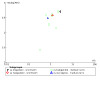
Funnel plot of comparison: 2 benzodiazepines versus antipsychotics, outcome: 2.1 Tranquillisation or asleep: 1. sedation.
Data synthesis
We understand that there is no closed argument for preference for use of fixed‐effect or random‐effects models. The random‐effects method incorporates an assumption that the different trials are estimating different, yet related, intervention effects. This often seems to be true to us and the random‐effects model takes into account differences between trials even if there is no statistically significant heterogeneity. However, there is a disadvantage to the random‐effects model as it puts added weight onto small trials, which often are the most biased ones. Depending on the direction of effect, these trials can either inflate or deflate the effect size. We chose a fixed‐effect model for all analyses, and if heterogeneity was identified, we used a random‐effects model.
As this is a review of the effects on acute psychosis, we included only those outcomes up to and including 48 hours after the initial dose of medication. Where data were for more than one time interval within the immediate (zero to 15 minutes), short term (15 minutes to one hour) and medium term (one to 48 hours) categories, we used the earlier data. The only exception to this were the data from Diazepam 1979, IL; this trial reported Clinical Global Impression (CGI) data at four and 24 hours (medium term) but because the loss to follow‐up was more than 50% for one group at four hours and complete at 24 hours, we used the latter data.
Subgroup analysis and investigation of heterogeneity
1. Subgroup analyses
Subgroup analyses were carried out for different antipsychotics.
2. Investigation of heterogeneity
If inconsistency was high, this was reported. First, we investigated whether data had been entered correctly. Second, if data were correct, we visually inspected the graph and if the results of trials were clearly different, these data were not pooled. Where there was evidence of substantial statistical heterogeneity data (Analysis 5.1; Analysis 5.5; Analysis 2.9), these were also analysed using a random‐effects model and any differences in the results of fixed‐effect and random‐effects models covered in the Discussion. Possible reasons for identified heterogeneity are also considered in the Discussion.
5.1. Analysis.
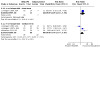
Comparison 5: Benzodiazepines plus antipsychotics versus same antipsychotics, Outcome 1: Tranquillisation or asleep: 1. sedation
5.5. Analysis.

Comparison 5: Benzodiazepines plus antipsychotics versus same antipsychotics, Outcome 5: Global state: 1. no improvement
2.9. Analysis.
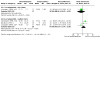
Comparison 2: Benzodiazepines versus antipsychotics, Outcome 9: Mental state: 2. mean change/endpoint score (BPRS, high = worse)
Sensitivity analysis
1. Implication of randomisation
If trials were described in some way as to imply randomisation, we undertook a sensitivity analyses for the primary outcome. We included these studies in the analyses and if there was no substantive difference when the implied randomised studies were added to those with better description of randomisation, then we used relevant data from these studies.
2. Assumptions for lost binary data
Where assumptions had to be made regarding people lost to follow‐up (see Dealing with missing data), we compared the findings of the primary outcome when we used our assumption compared with completer data only. If there was a substantial difference, we reported and discussed these results but continued to employ our assumption.
Where assumptions had to be made regarding missing SDs data (see Dealing with missing data), we compared the findings of the primary outcome when we used our assumption compared with completer data only. We undertook a sensitivity analysis testing how prone results were to change when 'completer' data only were compared to the imputed data using the above assumption. If there was a substantial difference, we reported and discussed these results but continued to employ our assumption.
3. Risk of bias
We analysed the effects of excluding trials that we judged to be at high risk of bias across one or more of the domains of randomisation for the meta‐analysis of the primary outcome (see Assessment of risk of bias in included studies). If the exclusion of trials at high risk of bias did not substantially alter the direction of effect or the precision of the effect estimates, we included data from these trials in the analysis
4. Imputed values
We undertook a sensitivity analysis to assess the effects of including data from trials where we used imputed values for intraclass correlation coefficients in calculating the design effect in cluster randomised trials. If we found substantial differences in the direction or precision of effect estimates, we did not pool data from the excluded trials with the other trials contributing to the outcome, but presented them separately.
5. Fixed and random effects
We synthesised data using a fixed‐effect model, however, we also synthesised data for the primary outcome using a random‐effects model to evaluate whether this altered the significance of the results.
Results
Description of studies
Results of the search
The update searches were undertaken on two occasions; August 2015 (75 references) and August 2016 (three references), totalling 78 new references. With the addition of the previous search results, we screened 2497 references. Of which, 2428 references were excluded after viewing the titles and abstracts and 84 full‐text reports were obtained for further screening. Forty‐eight studies (with 52 full‐text reports) were excluded due to ineligible study design, participants or comparisons. Finally, 20 studies (with 32 full‐text reports) were included in the review (see Figure 2).
2.
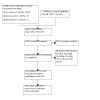
Study flow diagram.
Included studies
See Characteristics of included studies table for descriptions of each study. This updated review adopted a different means of presenting included studies. We decided to present included studies in such a way as to describe the type of benzodiazepine employed in the study, as well as the year and country in which the study was undertaken. For example, in the study that was referenced in the previous review as 'Qu 1999', participants received either clonazepam 2 mg or haloperidol 10 mg and the study was undertaken in China in 1999; therefore, it is now presented as Clonazepam 1999, CHN. We felt that this method, although unconventional, would be most suitable way to present the findings in a logical and concise manner, as results are clustered in graphs for ease of understanding.
The review included 20 trials. This is the total of the 17 trials from the previous review and three after the latest search (Clonazepam 2007a, CHN; Lorazepam 2009, SK; Lorazepam 2010, IN). In this 2016 update, we changed the inclusion criteria to include the comparison of antihistamines/anticholinergics in combination with antipsychotics, as we considered that a review of the effect of benzodiazepines for psychosis‐induced aggression should take into account the potential use of antihistamines for the treatment of psychosis‐induced aggression due to its potential sedative and anticholinergic properties and the widespread use of this combination. The inclusion criteria were clarified to specify the inclusion of benzodiazepines either alone or in combination with any other antipsychotic drug, versus placebo, non‐pharmacological approaches, other benzodiazepines or antipsychotics alone, or combined with any other antipsychotic, antihistaminic/anticholinergic drugs or other benzodiazepine. The inclusion criteria were further refined to ensure that the benzodiazepine was the same in the intervention and comparator arm of the trials where benzodiazepine alone was compared to benzodiazepine combined with antipsychotic. This enabled us to detect whether the apparent effect was due to combination with an antipsychotic. Where a combination of benzodiazepine with an antipsychotic was compared to another benzodiazepine combined with an antipsychotic, it was ensured that the antipsychotic was the same in both the intervention and the comparator arm. This allowed us to detect whether the apparent effect was due to the superiority of one benzodiazepine over another. Moreover, this had the result of permitting the exclusion of previously included studies, which were excluded due to comparing benzodiazepines plus antipsychotics versus different antipsychotics (Han 2005; Wang 2004; Yang 2003; Zhang 2007).
One trial compared benzodiazepines with placebo (Lorazepam 2001, RO and USA); 11 trials compared benzodiazepines with antipsychotics (Clonazepam 1993, CA; Clonazepam 1999, CHN; Clonazepam 2007a, CHN; Diazepam 1979, IL; Flunitrazepam 1999, IL; Lorazepam 1989, USA; Lorazepam 1991, USA; Lorazepam 1997a, USA; Lorazepam 1997b, USA; Lorazepam 2001, RO and USA; Midazolam 2006, AU); five trials compared benzodiazepines combined with antipsychotics with the same benzodiazepines alone (Clonazepam 2007a, CHN; Lorazepam 1997a, USA; Lorazepam 1998, USA; Lorazepam 1989, USA; Lorazepam 2006, USA); six trials compared benzodiazepines combined with antipsychotics with the same antipsychotics alone (Alprazolam 1992, USA; Clonazepam 2007a, CHN; Lorazepam 1989, USA; Lorazepam 1997a, USA; Lorazepam 2009, SK; Midazolam 2011, BZ); four trials compared benzodiazepines with antihistamines combined with antipsychotics (Lorazepam 2004, IN; Lorazepam 2010, IN; Midazolam 2003, BZ; Midazolam 2011, BZ); one trial compared benzodiazepines combined with antipsychotics versus two different antipsychotics (Lorazepam 1998, SA); and one trial compared benzodiazepines combined with antipsychotics versus antipsychotics and antihistamines (Midazolam 2011, BZ). Seven trials had with multiple treatment arms (Clonazepam 2007a, CHN; Lorazepam 1989, USA; Lorazepam 1997a, USA; Lorazepam 2001, RO and USA; Lorazepam 2006, USA; Lorazepam 2009, SK; Midazolam 2011, BZ).
1. Setting
Three trials were set in general emergency departments (Lorazepam 1997a, USA; Lorazepam 2006, USA; Midazolam 2006, AU); five trials were set in psychiatric hospitals (Diazepam 1979, IL; Lorazepam 1989, USA; Lorazepam 1998, SA; Lorazepam 2004, IN; Midazolam 2003, BZ); one was implied as having taken place in a psychiatric hospital (Flunitrazepam 1999, IL); and one within a general hospital (Lorazepam 2001, RO and USA). Five trials were conducted in psychiatric emergency departments (Alprazolam 1992, USA; Clonazepam 1993, CA; Lorazepam 1997b, USA; Lorazepam 1998, USA; Midazolam 2011, BZ); one trial took place in a locked intensive care unit (Lorazepam 1991, USA); two trials were implied as having taken place in a Chinese hospital (Clonazepam 1999, CHN; Clonazepam 2007a, CHN); one trial was conducted in a institute of mental health in India (Lorazepam 2010, IN), one trial did not state the settings of enrolling participants (Lorazepam 2009, SK). The majority of these trials took place in the Americas, followed by China, India, Israel, Canada, Australia, Romania, South Africa and South Korea.
2. Length of trials
The duration of included trials varied from one hour (Lorazepam 1989, USA) to seven days (Lorazepam 1998, SA; Lorazepam 1998, USA), and two weeks (Lorazepam 2004, IN; Midazolam 2003, BZ), although only data up to 48 hours were included for this review.
3. Participants
Participants in seven of the included trials appeared to have been inpatients (Clonazepam 1999, CHN; Clonazepam 2007a, CHN; Flunitrazepam 1999, IL; Lorazepam 1989, USA; Lorazepam 1991, USA; Lorazepam 2001, RO and USA; Lorazepam 2004, IN), while in 12 trials, participants appeared to have been newly admitted (Alprazolam 1992, USA; Diazepam 1979, IL; Lorazepam 1997a, USA; Lorazepam 1997b, USA; Lorazepam 1998, SA; Lorazepam 1998, USA; Lorazepam 2004, IN; Lorazepam 2006, USA; Lorazepam 2010, IN; Midazolam 2003, BZ; Midazolam 2006, AU; Midazolam 2011, BZ), and in one trial, participants were a mixture of inpatients and new admissions (Clonazepam 1993, CA).
In most trials, participants were of mixed diagnoses (Clonazepam 1993, CA; Clonazepam 1999, CHN; Diazepam 1979, IL; Flunitrazepam 1999, IL; Lorazepam 1989, USA; Lorazepam 1991, USA; Lorazepam 1997a, USA; Lorazepam 1997b, USA; Lorazepam 1998, SA; Lorazepam 1998, USA; Lorazepam 2001, RO and USA; Lorazepam 2004, IN; Lorazepam 2006, USA; Lorazepam 2009, SK; Midazolam 2003, BZ; Midazolam 2011, BZ). Participants in Alprazolam 1992, USA were diagnosed as having schizophrenia and in Clonazepam 2007a, CHN, participants had schizophrenia with agitation/aggression. In Midazolam 2006, AU and Lorazepam 2010, IN, the diagnosis was not explicit but was described as a 'mental illness/psychotic diagnosis.'
4. Trial size
The overall sample size in all the included trials was generally small. The total number of participants in each trial ranged from 16 (Clonazepam 1993, CA) to 301 (Midazolam 2003, BZ).
5. Interventions
5.1. Benzodiazepines versus placebo
We were able to include one trial comparing benzodiazepines with placebo (Lorazepam 2001, RO and USA). This trial compared one to three IM injections of lorazepam (2 mg to 5 mg) with IM placebo.
5.2. Benzodiazepines versus antipsychotics
Eleven trials compared benzodiazepines with antipsychotics. Four trials compared lorazepam with haloperidol (Lorazepam 1989, USA; Lorazepam 1991, USA; Lorazepam 1997a, USA; Lorazepam 1997b, USA); three trials compared lorazepam 2 mg versus haloperidol 5 mg (Lorazepam 1997a, USA; Lorazepam 1997b, USA; Lorazepam 1991, USA); and one trial compared lorazepam 4 mg to haloperidol 5 mg (Lorazepam 1989, USA). In all these trials, both interventions were given as an IM injection, although in the trial by Lorazepam 1997b, USA, participants were able to receive the administered dose as an oral concentrate. Medications were given as a single injection in the trials by Lorazepam 1989, USA and Lorazepam 1991, USA. In the trial by Lorazepam 1997b, USA, doses were administered every 30 minutes for four hours or until the participant was sedated. Additional doses could be given in the trial by Lorazepam 1991, USA, where the mean number of doses of lorazepam was 1.13 and haloperidol was 1.10. Participants in Lorazepam 1997a, USA could have been given up to six doses over eight hours although the majority (71% of participants receiving haloperidol and 74% receiving lorazepam) received fewer than three doses. Lorazepam 2001, RO and USA compared lorazepam 2 mg to 5 mg IM with olanzapine 10 mg to 25 mg IM. In this trial, participants received one to three doses based on the clinical judgement of 'the investigator.'
In the remaining trials that compared benzodiazepines with antipsychotics, three compared IM clonazepam with IM haloperidol (Clonazepam 1993, CA; Clonazepam 1999, CHN; Clonazepam 2007a, CHN). Clonazepam 1993, CA compared clonazepam 1 mg to 2 mg with haloperidol 5 mg to 10 mg at 0 minutes, 30 minutes and one hour. Clonazepam 1999, CHN compared clonazepam 2 mg with haloperidol 10 mg. Clonazepam 2007a, CHN compared clonazepam 2 mg to 6 mg with haloperidol 5 mg to 15 mg. Flunitrazepam 1999, IL compared single doses of flunitrazepam 1 mg with haloperidol 5 mg. The trial by Diazepam 1979, IL compared diazepam (mean dose 35 mg over three hours) with high‐dose haloperidol (35 mg over three hours) and low‐dose haloperidol (20 mg over three hours) and Clonazepam 1999, CHN compared clonazepam 2 mg IM with haloperidol 10 mg IM. Midazolam 2006, AU compared midazolam 5 mg with droperidol 10 mg, both of which were given intravenously, with repeat doses given until sedation was achieved.
5.3. Benzodiazepines plus antipsychotics versus same benzodiazepines
Five trials compared a combination of lorazepam with haloperidol versus lorazepam alone. Lorazepam 1997a, USA and Lorazepam 1998, USA compared lorazepam 2 mg plus haloperidol 5 mg with lorazepam 2 mg alone while Lorazepam 1989, USA compared lorazepam 4 mg plus haloperidol 5 mg with lorazepam 4 mg. All were given by IM injection. Lorazepam 2006, USA compared lorazepam 2 mg IM plus risperidone 2 mg oral, or lorazepam 2 mg IM plus haloperidol 5 mg oral with lorazepam 2 mg IM (plus oral placebo). Clonazepam 2007a, CHN compared clonazepam 2 mg to 6 mg IM plus haloperidol 5 mg to 15 mg IM with clonazepam 2 mg to 6 mg IM (plus placebo). Lorazepam 1989, USA and Lorazepam 2006, USA gave single doses. Participants in Lorazepam 1998, USA could receive a second dose within the first hour, and in Lorazepam 1997a, USA participants could be given up to six doses over eight hours. In Clonazepam 2007a, CHN, the participant received at least one dose but no more than three doses. However, majority of participants received fewer than three doses.
5.4. Benzodiazepines plus antipsychotics versus same antipsychotics
We found six trials comparing combined benzodiazepines/antipsychotics with the same antipsychotics alone. In each study, benzodiazepines were combined with and compared with haloperidol; Alprazolam 1992, USA compared alprazolam 1 mg plus haloperidol 5 mg with haloperidol 5 mg plus placebo; Lorazepam 1997a, USA compared lorazepam 2 mg plus haloperidol 5 mg with haloperidol 5 mg alone; and Lorazepam 1989, USA compared lorazepam 4 mg plus haloperidol 5 mg with haloperidol 5 mg. Clonazepam 2007a, CHN compared clonazepam 2 mg to 6 mg IM plus haloperidol 5 mg to 15 mg IM with haloperidol 5 mg to 15 mg IM (plus placebo). All drugs were administered as an IM injection. In the trials by Lorazepam 1989, USA single doses were given; in Alprazolam 1992, USA medications were administered as a daily oral dose although additional doses could be given if the psychosis scores were high; and in Lorazepam 1997a, USA, 9% of the participants receiving both drugs and 29% of the participants receiving haloperidol were given three or more doses. Midazolam 2011, BZ compared midazolam 15 mg combined with haloperidol 5 mg IM versus haloperidol 5 mg IM.
5.5. Benzodiazepines versus antipsychotics plus antihistamines
We found three trials comparing benzodiazepines versus antipsychotics plus antihistamines (Lorazepam 2004, IN; Lorazepam 2010, IN; Midazolam 2003, BZ). Two were large, higher‐quality trials that compared the effects of benzodiazepines versus combined haloperidol/promethazine. In Midazolam 2003, BZ, midazolam 15 mg IM (with flumazenil made available for use in the event of midazolam toxicity) was compared with haloperidol 5 mg to 10 mg IM (77 participants received 5 mg, 71 participants received 10 mg) combined with promethazine 25 mg to 50 mg IM (147 participants received 50 mg, one participant received 25 mg). Similarly, Lorazepam 2004, IN compared lorazepam 4 mg IM with haloperidol 10 mg IM combined with promethazine 25 mg to 50 mg IM (96 participants received 50 mg, four participants received 25 mg); all doses were given at the discretion of the treating physician. Lorazepam 2010, IN compared lorazepam 4 mg IM with haloperidol 10 mg IM.
5.6. Benzodiazepines plus antipsychotics versus antipsychotics plus antipsychotics
One trial compared benzodiazepines plus antipsychotics versus antipsychotics plus antipsychotics (Lorazepam 1998, SA). The trial compared lorazepam 4 mg IM with clotiapine 40 mg IM given at six hourly intervals 'if warranted.' Both groups also received haloperidol 10 mg IM at the same time.
5.7. Benzodiazepines plus antipsychotics versus antipsychotics plus antihistamines
One trial compared benzodiazepines plus antipsychotics versus antipsychotics plus antihistamines (Midazolam 2011, BZ). The trial compared midazolam 15 mg plus haloperidol 5 mg (each administered IM) with promethazine 50 mg plus haloperidol 5 mg (each administered IM). After the initial dose, only additional doses of combined haloperidol/promethazine could be used, according to clinical judgement. If a participant needed another intervention, he or she were immediately removed from the study.
6. Outcomes scales
The trials used the following outcome scales.
6.1. Global state
1.1. Clinical Global Impression (CGI, Busner 2007; Guy 1970) (high = worse).
The CGI scale was designed to quantify severity of illness and overall clinical improvement in people with a psychiatric disorder. A 7‐point scoring system is usually used for severity and improvement with lower scores indicating decreased severity or greater recovery, or both. Alprazolam 1992, USA; Diazepam 1979, IL; Lorazepam 1997b, USA; and Lorazepam 2001, RO and USA used this scale. Lorazepam 1998, USA dichotomised scores by defining a reduction of at least 3 points on the CGI as improvement. Lorazepam 2004, IN dichotomised the outcomes of this scale to present outcomes of those clinically improved.
6.1.2. Ramsay Sedation Scale (RSS, Ramsay 1974)
The RSS is a six‐item rating scale used to assess levels of sedation by selecting the most appropriate level of response. A rating of one indicates an agitated, anxious state, and a rating of six indicates an unresponsive state. Midazolam 2011, BZ reported data using this scale.
6.2. Behaviour
6.2.1. Agitated Behaviour Scale (ABS, Corrigan 1988) (high = worse)
The ABS was originally developed in response to the need to make serial assessments of agitation during the acute period following traumatic brain injury (Caplan 1999). It originally consisted of 39 items, but was subsequently reduced to 14 items following validation and includes a range of agitated behaviour, such as short attention span, impulsiveness, violence/threatening violence, unco‐operativeness, restlessness and repetitive behaviour. The 14‐item ratings range on a scale of one to four, with one indicating the absence of agitated behaviour, and four indicating the extreme presence of agitated behaviour. Lorazepam 2001, RO and USA used this scale. Lorazepam 1997a, USA also used this scale, but presented skewed data (see Data and analyses).
6.2.2. Overt Aggression Scale (OAS, Yudofsky 1986) (high = worse)
The OAS is designed to assess observable aggressive or violent behaviour and consists of four categories: verbal aggression, physical aggression against objects, physical aggression against self and physical aggression against other people. Within each category, there are four types of aggressive behaviour listed. Clonazepam 1999, CHN; Lorazepam 1998, SA; and Midazolam 2011, BZ used this scale. Flunitrazepam 1999, IL defined improvement as a reduction of at least 4 points on the OAS and Lorazepam 1998, USA defined improvement as a decrease of 50% or more. Lorazepam 1991, USA also used this scale, defining improvement as a 'greater than mean decrease' in scores at two hours.
6.2.3. Overt Agitation Severity Scale (OASS, Yudofsky 1997) (high = worse)
The OASS is designed to define and objectively rate the severity of agitated behaviour and confines its rating exclusively to observable behavioural manifestations of agitation. This comprises three categories: vocalisations and oral/facial movements, upper torso and upper extremity movements, and lower extremity movements, each with four types of agitated behaviour listed. These types of behaviour are rated on a 0‐ to 4‐point scale, with 0 = not present and 4 = always present. Midazolam 2011, BZ reported data using this scale.
6.2.4. Positive and Negative Symptom Scale (PANSS, Kay 1987) (high = worse)
PANSS was developed from the Brief Psychiatric Rating Scale (BPRS) and the Psychopathology Rating Scale. It is used to evaluate positive, negative and other symptom dimensions in schizophrenia. The scale has 30 items, each measured on a 7‐point scoring system varying from one (absent) to seven (extreme). Lorazepam 2006, USA; however, data were skewed for Lorazepam 2006, USA. Lorazepam 2001, RO and USA each reported data from the PANSS‐Excited Component subscale (PANSS‐EC); Lorazepam 2001, RO and USA defined a reduction of 40% or more on the PANSS‐EC as a measure of improvement.
6.3. Mental state
6.3.1. Brief Psychiatric Rating Scale (BPRS, Overall 1967; Shafer 2005) (high = worse)
The BPRS lists a range of psychiatric symptoms generally associated with the domains of anxiety and depression, hostility and suspiciousness, thought disturbance and withdrawal/motor retardation. The original scale has 16 items, but a revised 18‐item scale is commonly used. Each item is rated on a 7‐point scale varying from 'not present' to 'extremely severe.' Alprazolam 1992, USA, Clonazepam 1999, CHN; and Lorazepam 1997b, USA reported data from this scale. Alprazolam 1992, USA and Lorazepam 1997a, USA also reported data using the 11 psychosis‐anxiety items from the BPRS, classified as the BPRS‐psychosis subscale (Faustman 1989). Lorazepam 2006, USA reported skew data from this scale.
6.3.2. Inpatient Multidimensional Psychiatric Scale (IMPS, Cairns 1983; Lorr 1963)
The IMPS measures psychotic symptom scales in psychiatric inpatients. It originally consisted of 75 items and 10 domains. The addition of another 15 items resulted in 12 domains: excitement, hostile belligerence, grandiose expansiveness, paranoid projection, perceptual distortions, anxious depression, retardation and apathy, conceptual disorganisation, motor disturbances, disoriented behaviour, impaired functioning and obsessive‐phobic. The IMPS was used by Clonazepam 1993, CA who reported a reduction of at least 50% as improvement.
Excluded studies
We excluded 48 studies (with 52 full‐text reports). See Characteristics of excluded studies table.
Four trials did not appear to be randomised (Arana 1986; Liang 2003; Simpson 2003; Yu 2006).
Participants in eight trials were agitated without psychosis, retarded catatonia or not acutely psychotic (Gharabawi 2003; Lenox 1992; Nestoros 1982; Nobay 2004; Richards 1998; Wetzel 1997). Martel 2005 was excluded because agitation appeared to be due to alcohol intoxication in 93% of participants. Isbister 2010 was excluded because it enrolled participants with acutely disturbed/aggressive/agitated behaviour believed to be secondary to psychotic illnesses.
19 trials had ineligible comparisons (Currier 2000; Currier 2004; Han 2005; Hou 2011; Huf 2007; Hwang 2012; Kinon 2002; Kinon 2004; NCT00797277; NCT00859872; Veraksa 2016; Wang 2004; Wu 2006; Yang 2003; Yang 2006; Zhang 2007; Zhong 2006; Zhou 2014; Zhu 2005).
None of the outcomes of interest were reported in 17 trials within the 48‐hour time period (Chen 2012; Davis 2008; Deng 2004; Ge 2004; Guz 1972; Hankoff 1962; Hanlon 1970; He 2011; Kang 2006; Mei 2006; Stevens 1992; Tang 2007; Wan 2005; Wyant 1990; Zhang 2008; Zhou 2012).
Risk of bias in included studies
For a summary of the overall risk of bias in included trials, see Figure 3 and Figure 4.
3.
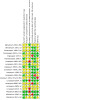
'Risk of bias' summary: review authors' judgements about each risk of bias item for each included study.
4.
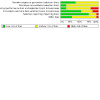
'Risk of bias' graph: review authors' judgements about each risk of bias item presented as percentages across all included studies.
Allocation
All 20 included trials were described as randomised but overall the description of allocation and concealment was poor. Only Lorazepam 2004, IN, Midazolam 2006, AU, and Midazolam 2003, BZ adequately described the process used for randomisation and the concealment of allocation. Four trials stated that a table of random numbers was used to allocate participants (Clonazepam 2007a, CHN; Flunitrazepam 1999, IL; Lorazepam 1997a, USA; Lorazepam 1998, USA). Diazepam 1979, IL was described as a randomised trial but also referred to alternate allocation. There was no description of the method of allocation and concealment in the remaining trials.
Blinding
1. Blinding of participants
Twelve of the included trials were described as double blinded; however, the method of blinding was unclear (Alprazolam 1992, USA; Clonazepam 1993, CA; Clonazepam 2007a, CHN; Lorazepam 1991, USA; Lorazepam 1997a, USA; Lorazepam 1997b, USA; Lorazepam 1998, SA; Lorazepam 1998, USA; Lorazepam 2001, RO and USA; Lorazepam 2006, USA; Midazolam 2006, AU; Midazolam 2011, BZ), with only three trials explaining blinding methods (Alprazolam 1992, USA; Lorazepam 1991, USA; Lorazepam 1997a, USA).
Four trials were single/observer blinded (Diazepam 1979, IL; Flunitrazepam 1999, IL; Lorazepam 2004, IN; Midazolam 2003, BZ). Midazolam 2003, BZ and Lorazepam 2004, IN were blind up until point of treatment assignment. Lorazepam 1989, USA and Lorazepam 2010, IN were not blinded. Clonazepam 1999, CHN and Lorazepam 2009, SK did not state whether blinding was used.
Incomplete outcome data
High loss to follow‐up was where the number of participants lost to follow‐up was more than 5% in the first two hours or between 25% and 50% overall. In six of the trials, there was a high loss to follow‐up rate observed (Alprazolam 1992, USA; Clonazepam 1993, CA; Diazepam 1979, IL; Lorazepam 1991, USA; Lorazepam 2006, USA; Midazolam 2006, AU), and 12 trials had a low loss to follow‐up (Clonazepam 1999, CHN; Clonazepam 2007a, CHN; Flunitrazepam 1999, IL; Lorazepam 1989, USA; Lorazepam 1997a, USA; Lorazepam 1997b, USA; Lorazepam 1998, SA; Lorazepam 1998, USA; Lorazepam 2001, RO and USA; Lorazepam 2004, IN; Midazolam 2003, BZ; Midazolam 2011, BZ). Two trials had unclear rate of loss to follow‐up, as only abstracts of these two trials are available (Lorazepam 2009, SK; Lorazepam 2010, IN; see Table 11).
4. High and low attrition studies.
| Attrition | Study | % loss | Duration | Notes |
| High | Alprazolam 1992, USA | 31 | 72 hours | ‐ |
| Clonazepam 1993, CA | 12 | 2 hours | ‐ | |
| Midazolam 2006, AU | 10 | 100 minutes | ‐ | |
| Diazepam 1979, IL | 50 | 24 hours | ‐ | |
| Lorazepam 1991, USA | 33 | 48 hours | 33% participants lost to follow‐up for EPS outcome and 12% loss for 'sedation' | |
| Lorazepam 2006, USA | 10 | 90 minutes | ‐ | |
| Low | Lorazepam 1998, USA | 0 | 7 days | ‐ |
| Flunitrazepam 1999, IL | 0 | 2 hours | ‐ | |
| Lorazepam 2001, RO and USA | 4 | 24 hours | ‐ | |
| Lorazepam 1998, SA | 0 | 7 days | ‐ | |
| Midazolam 2003, BZ | 1 | 2 weeks | ‐ | |
| Lorazepam 2004, IN | 0.5 | 4 hours | ‐ | |
| Clonazepam 1999, CHN | 0 | 24 hours | ‐ | |
| Clonazepam 2007a, CHN | 0 | 24 hours | ‐ | |
| Lorazepam 1989, USA | 0 | 60 minutes | ‐ | |
| Lorazepam 1997a, USA | 0 | 24 hours | ‐ | |
| Lorazepam 1997b, USA | 0 | 4 hours | ‐ | |
| Midazolam 2011, BZ | 0 | 12 hours | ‐ | |
| Unclear | Lorazepam 2009, SK | Unclear | 120 minutes | Only abstract available. |
| Lorazepam 2010, IN | Unclear | 24 hours | Only abstract available. |
Trials were considered to have a high attrition rates if it was more than 5% within the first two hours or 25% to 50% overall.
EPS: extrapyramidal symptoms.
Selective reporting
Most of the studies were rated as low risk of bias in this domain as all measured outcomes of each study were reported. In Lorazepam 1998, USA, there was a higher risk of bias noted, as the trial authors changed the criteria for 'improvement' (using a visual analogue scale (VAS) post‐study, after analysis had taken place. We considered there were potential risks of selective reporting in four trials: Alprazolam 1992, USA did not report the data measured by Simpson‐Angus Side Effects Profile. Lorazepam 1991, USA did not report the SD of BPRS and CGI. Lorazepam 2009, SK and Lorazepam 2010, IN were reported as abstracts, so it is unclear whether there was selective reporting.
Other potential sources of bias
Funding sources
Six trials were funded by pharmaceutical companies:
Alprazolam 1992, USA was supported in part by a grant from The Upjohn Company (now Pfizer); Clonazepam 1993, CA was partially funded by Hoffmann La Roche Ltd; Lorazepam 1991, USA was supported in part by Wyeth Laboratories; Lorazepam 1997a, USA was supported in part by a grant from Wyeth‐Ayerst Research (now also part of Pfizer); and Lorazepam 2006, USA was funded by a grant from Janssen Pharmaceutica. However, as the study did not reveal more information, we are unsure whether the pharmaceutical companies were involved in the study design and reporting process. Lorazepam 2001, RO and USA was funded by Lilly Research Laboratories, Indiana, and developed a rating scale for use in the study (which was excluded from analysis); 90% of the trial authors of this study were also employed by the same pharmaceutical company. Therefore, the company was probably involved in the study design and reporting process, and we suspect there is conflict of interests.
Other sources of funding include support from the National Alliance for Research on Schizophrenia and Depression (Lorazepam 1997b, USA); a postgraduate scholarship from the National Health and Medicine Research Council and a research grant from the Australasian College for Emergency Medicine (Morson Taylor Award, Midazolam 2006, AU); a grant from the Gralnick Foundation, High Point Hospital, Port Chester, New York (Diazepam 1979, IL); funding from Fundação Oswaldo Cruz, the British Council, CAPES (Coordenação de Aperfeiçoamento de Pessoal de Nível Superior) and FAPERJ (Fundação de Amparo à Pesquisa do Estado do Rio de Janeiro, Midazolam 2003, BZ); funding by intramural research grants from Fluid Research Fund (Christian Medical College, Vellore), and the Cochrane Schizophrenia Group general fund (Lorazepam 2004, IN). American John M Davis Funding supported the Clonazepam 2007a, CHN study.
Eight trials did not reveal information about funding source: Clonazepam 1999, CHN; Flunitrazepam 1999, IL; Lorazepam 1989, USA; Lorazepam 1998, SA; Lorazepam 1998, USA; Lorazepam 2009, SK; Lorazepam 2010, IN; Midazolam 2011, BZ.
Effects of interventions
See: Table 1; Table 2; Table 3; Table 4; Table 5; Table 6; Table 7
Comparison 1: Benzodiazepines versus placebo
All data for this comparison came from Lorazepam 2001, RO and USA) (n = 102). This comparison has 11 outcomes.
1.1 Tranquillisation or asleep
There was no clear difference between the benzodiazepine and placebo groups in the number of people who were sedated (n = 102, RR 1.67, 95% CI 0.42 to 6.61, Analysis 1.1, very low quality evidence).
1.1. Analysis.
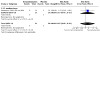
Comparison 1: Benzodiazepines versus placebo, Outcome 1: Tranquillisation or asleep: 1. sedation
1.2. Behaviours
There was a clear difference with ABS scores in favour of participants allocated to benzodiazepine (n = 101, MD ‐3.61, 95% CI ‐5.92 to ‐1.30, Analysis 1.2).
1.2. Analysis.
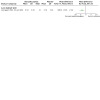
Comparison 1: Benzodiazepines versus placebo, Outcome 2: Behaviour: 1. mean change score (Agitated Behaviour Scale, high = worse)
1.3 to 1.5 Global state
There was no clear difference in the number of people who had not improved in the short term (n = 102, RR 0.89, 95% CI 0.69 to 1.16) but fewer people receiving benzodiazepines were rated as not improved in the medium term (n = 102, RR 0.62, 95% CI 0.40 to 0.97, Analysis 1.3, very low quality evidence). There was no clear difference between benzodiazepine and placebo in the number of people who needed additional medication (n = 102, RR 1.00, 95% CI 0.69 to 1.44, Analysis 1.4, very low quality evidence). The mean change in CGI scores was also comparable (n = 76, MD 0.07, 95% CI ‐0.46 to 0.60, Analysis 1.5).
1.3. Analysis.
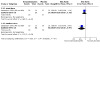
Comparison 1: Benzodiazepines versus placebo, Outcome 3: Global state: 1. no improvement (> 40% reduction Positive and Negative Syndrome Scale‐Excited Component (PANSS‐EC))
1.4. Analysis.
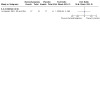
Comparison 1: Benzodiazepines versus placebo, Outcome 4: Global state: 2. need for additional medication
1.5. Analysis.
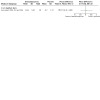
Comparison 1: Benzodiazepines versus placebo, Outcome 5: Global state: 3. mean change score (Clinical Global Impression Severity Scale, high = worse)
1.6 to 1.7 Mental state
There was no clear difference between groups in the change in PANSS (n = 99, MD ‐2.57, 95% CI ‐6.23 to 1.09, Analysis 1.6) or PANSS excited component scores (n = 101, MD ‐1.91, 95% CI ‐3.83 to 0.01, Analysis 1.7).
1.6. Analysis.
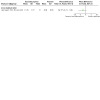
Comparison 1: Benzodiazepines versus placebo, Outcome 6: Mental state: 1. mean change score (Positive and Negative Syndrome Scale, high = worse)
1.7. Analysis.
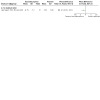
Comparison 1: Benzodiazepines versus placebo, Outcome 7: Mental state: 2. mean change score (PANSS‐EC, high = worse)
1.8 to 1.10 Adverse effects/events
There was no clear difference between benzodiazepine and placebo in EPS (n = 102, RR 0.33, 95% CI 0.04 to 3.10, Analysis 1.8, very low quality evidence) or receiving medication for EPS (n = 102, RR 0.33, 95% CI 0.04 to 3.10, Analysis 1.9) There was no clear difference in dizziness, nausea and vomiting (Analysis 1.10).
1.8. Analysis.
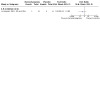
Comparison 1: Benzodiazepines versus placebo, Outcome 8: Adverse effects/events: 1. extrapyramidal symptoms (EPS)
1.9. Analysis.
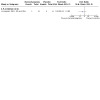
Comparison 1: Benzodiazepines versus placebo, Outcome 9: Adverse effects/events: 2. use of medication for EPS
1.10. Analysis.
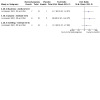
Comparison 1: Benzodiazepines versus placebo, Outcome 10: Adverse effects/events: 3. specific
1.11 Leaving study early
There was no clear difference in leaving the study early for any reason (n = 102, RR 0.60, 95% CI 0.15 to 2.38, Analysis 1.11).
1.11. Analysis.
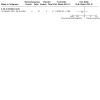
Comparison 1: Benzodiazepines versus placebo, Outcome 11: Leaving the study early: 1. any reason
Missing outcomes
For this comparison, none of the studies reported hospital and service outcomes, satisfaction with treatment or economic outcomes.
Comparison 2: Benzodiazepines versus antipsychotics
We included 11 trials comparing benzodiazepines with antipsychotics (Clonazepam 1993, CA; Clonazepam 1999, CHN; Clonazepam 2007a, CHN; Diazepam 1979, IL; Flunitrazepam 1999, IL; Lorazepam 1989, USA; Lorazepam 1991, USA; Lorazepam 1997a, USA; Lorazepam 1997b, USA; Lorazepam 2001, RO and USA; Midazolam 2006, AU).
2.1 Tranquillisation or asleep
There was no clear difference in the number of people sedated when benzodiazepines were compared with haloperidol in the short term (n = 44, 1 RCT, RR 1.17, 95% CI 0.53 to 2.59) or medium term (n = 434, 8 RCTs, RR 1.13, 95% CI 0.83 to 1.54, low quality evidence) or olanzapine in the medium term (n = 150, 1 RCT, RR 0.75, 95% CI 0.28 to 1.98). However, people receiving benzodiazepines were more likely to be sedated in the short term when compared with people receiving droperidol (n = 153, 1 RCT, RR 2.71, 95% CI 1.55 to 4.73). The differences between subgroups were significant (Chi2 = 8.77, P = 0.03, I2 = 66%, Analysis 2.1.
2.1. Analysis.
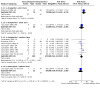
Comparison 2: Benzodiazepines versus antipsychotics, Outcome 1: Tranquillisation or asleep: 1. sedation
2.2 to 2.3 Behaviours
People receiving olanzapine scored significantly lower on the Agitated Behaviour Scale (ABS) in the medium term (n = 149,1 RCT, MD 2.91, 95% CI 0.80 to 5.02) but there was no difference when haloperidol was compared with lorazepam (n = 66,1 RCT, MD 1.80, 95% CI ‐2.39 to 5.99, Analysis 2.2). There was no significant difference in OAS scores at medium term when clonazepam was compared with haloperidol (n = 46, 1 RCT, MD 0.20, 95% CI ‐0.57 to 0.97, Analysis 2.3).
2.2. Analysis.
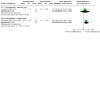
Comparison 2: Benzodiazepines versus antipsychotics, Outcome 2: Behaviour: 2. mean change/endpoint score (Agitated Behaviour Scale, high = worse)
2.3. Analysis.
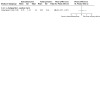
Comparison 2: Benzodiazepines versus antipsychotics, Outcome 3: Behaviour: 4. mean change score (Overt Aggression Scale, high = worse)
2.4 to 2.7 Global state
More people in the benzodiazepines group were likely to be rated as not improved in the medium term (n = 150, 1 RCT, RR 1.84, 95% CI 1.06 to 3.18, very low quality evidence) when compared with olanzapine but there was no clear difference in the short term (n = 150, 1 RCT, RR 1.26, 95% CI 0.95 to 1.66) or when benzodiazepines were compared with haloperidol in the medium term (n = 188, 5 RCTs, RR 0.89, 95% CI 0.71 to 1.11, low quality evidence). Analysis 2.4
2.4. Analysis.
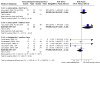
Comparison 2: Benzodiazepines versus antipsychotics, Outcome 4: Global state: 1. no improvement (> 40% reduction Positive and Negative Syndrome Scale‐Excited Component (PANSS‐EC))
People receiving benzodiazepines were no more likely to need additional medication compared with those receiving droperidol in the short term (n = 153, 1 RCT, RR 1.87, 95% CI 0.83 to 4.19) or haloperidol in the medium term (n = 66, 1 RCT, RR 0.87, 95% CI 0.70 to 1.09, very low quality evidence). However, participants receiving lorazepam were more likely to require additional medication than those receiving olanzapine in the medium term (n = 150, 1 RCT, RR 2.02, 95% CI 1.33 to 3.07, very low quality evidence); Analysis 2.5.
2.5. Analysis.
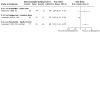
Comparison 2: Benzodiazepines versus antipsychotics, Outcome 5: Global state: 2. need for additional medication
CGI change/endpoint scores for the short term favoured lorazepam when compared with haloperidol (n = 37, 1 RCT, MD ‐0.67, 95% CI ‐1.09 to ‐0.25). Because of the marked heterogeneity of medium‐term data, these were not pooled. Results clearly favoured lorazepam compared with haloperidol (n = 37, 1 RCT, MD ‐0.81, 95% CI ‐1.37 to ‐0.25). There was no clear difference when diazepam was compared with haloperidol (n = 40, 1 RCT, MD 0.60, 95% CI ‐0.17 to 1.37) or when olanzapine was compared with lorazepam (n = 147, 1 RCT, MD 0.14, 95% CI ‐0.15 to 0.43). (All in Analysis 2.6). There was also no clear difference in IMPS scores in the medium term when clonazepam was compared with haloperidol (n = 16, 1 RCT, MD 2.60, 95% CI ‐3.04 to 8.24, Analysis 2.7).
2.6. Analysis.
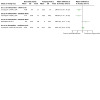
Comparison 2: Benzodiazepines versus antipsychotics, Outcome 6: Global state: 3. mean change/endpoint score (Clinical Global Impression Severity Scale, high = worse)
2.7. Analysis.
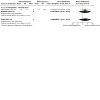
Comparison 2: Benzodiazepines versus antipsychotics, Outcome 7: Global state: 4. mean endpoint score (Inpatient Multidimensional Psychiatric Scale, high = worse)
2.8 to 2.14 Mental state
When no clinical improvement was defined as the decrease rate of BPRS score less than 30%, there was no clear difference between clonazepam and haloperidol (n = 30, 1 RCT, RR 0.93, 95% CI 0.73 to 1.18, Analysis 2.8). There was no clear difference in BPRS scores in the short term (n = 37, 1 RCT, MD ‐3.26, 95% CI ‐10.65 to 4.13) or medium term (n = 123, 3 RCTs, MD 1.67, 95% CI ‐1.84 to 5.18), Analysis 2.9). As the medium‐term data were heterogenous (Chi2 = 4.43, P = 0.11, I2 = 55%), we used a random‐effects model but these results were also equivocal (n = 123, 3 RCTs, MD 1.18, 95% CI ‐4.18 to 6.53). In the medium term, there was no difference between people receiving lorazepam or haloperidol in BPRS psychosis subscale scores (n = 66, 1 RCT, MD = 0.70, 95% CI ‐7.20 to 8.60, Analysis 2.10). For BPRS positive subscale and excited component subscale, there was no clear difference between clonazepam and haloperidol (n = 30, 1 RCT, MD 0.80, 95% CI ‐1.83 to 3.43, Analysis 2.11; n = 30, 1 RCT, MD 1.27, 95% CI ‐0.49 to 3.03, Analysis 2.12). For people receiving antipsychotics, the change in PANSS (n = 146, 1 RCT, MD 5.64, 95% CI 2.20 to 9.08, Analysis 2.13) and PANSS excited component scores were significantly better for people receiving olanzapine compared to those receiving lorazepam (n = 149, 1 RCT, MD 2.85, 95% CI 1.14 to 4.56, Analysis 2.14).
2.8. Analysis.
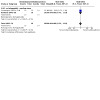
Comparison 2: Benzodiazepines versus antipsychotics, Outcome 8: Mental state: 1. no improvement (decrease rate of Brief Psychiatric Rating Scale (BPRS) score < 30%)
2.10. Analysis.
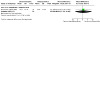
Comparison 2: Benzodiazepines versus antipsychotics, Outcome 10: Mental state: 3. mean endpoint score (BPRS psychosis subscale, high = worse)
2.11. Analysis.
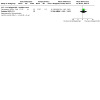
Comparison 2: Benzodiazepines versus antipsychotics, Outcome 11: Mental state: 3a. mean endpoint score (BPRS positive subscale, high = worse)
2.12. Analysis.
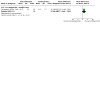
Comparison 2: Benzodiazepines versus antipsychotics, Outcome 12: Mental state: 4a. mean endpoint score (BPRS‐excited component, high = worse)
2.13. Analysis.
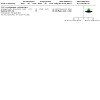
Comparison 2: Benzodiazepines versus antipsychotics, Outcome 13: Mental state: 2a. mean change score (Positive and Negative Syndrome Scale, high = worse)
2.14. Analysis.
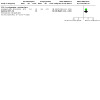
Comparison 2: Benzodiazepines versus antipsychotics, Outcome 14: Mental state: 4. mean change score (PANSS‐EC, high = worse)
2.15 to 2.17 Adverse effects/events
EPS were significantly lower in the group receiving benzodiazepines compared with those receiving haloperidol (n = 233, 6 RCTs, RR 0.13, 95% CI 0.04 to 0.41, low quality evidence) and cumulatively (n = 536, 8 RCTs, RR 0.15, 95% CI 0.06 to 0.39). There was no difference in the single trials where lorazepam was compared with olanzapine (n = 150, 1 RCT, RR 0.24, 95% CI 0.03 to 1.89) and midazolam was compared with droperidol (n = 153, 1 RCT, RR 0.15, 95% CI 0.01 to 2.90), Analysis 2.15. People receiving antipsychotics were no more likely to require medication for EPS (n = 216, 2 RCT, RR 0.40, 95% CI 0.15 to 1.05) or the single trials that compared lorazepam with haloperidol (n = 66, 1 RCT, RR 0.50, 95% CI 0.17 to 1.47) or olanzapine (n = 150, 1 RCT, RR 0.24, 95% CI 0.03 to 1.89). Analysis 2.16.
2.15. Analysis.
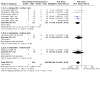
Comparison 2: Benzodiazepines versus antipsychotics, Outcome 15: Adverse effects/events: 1. extrapyramidal symptoms (EPS)
2.16. Analysis.
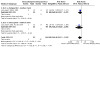
Comparison 2: Benzodiazepines versus antipsychotics, Outcome 16: Adverse effects/events: 2. use of medication for EPS
There were no differences in the number of people experiencing specific adverse effects: airway management, akathisia, ataxia, low blood pressure, dizziness, dry mouth, drowsiness, hypoxia, high or low heart rates, nausea or vomiting, seizures, speech disorder or tremor when compared with people receiving antipsychotics. However, these results all came from single trials (Analysis 2.17).
2.17. Analysis.
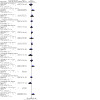
Comparison 2: Benzodiazepines versus antipsychotics, Outcome 17: Adverse effects/events: 3. specific
2.18 Leaving study early
There was no clear difference between groups at medium term for leaving the study early (n = 339, 3 RCTs, RR 1.48, 95% CI 0.70 to 3.13, Analysis 2.18).
2.18. Analysis.
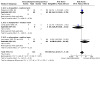
Comparison 2: Benzodiazepines versus antipsychotics, Outcome 18: Leaving the study early: 1. any reason
Missing outcomes
For this comparison, none of the studies reported hospital and service outcomes, satisfaction with treatment or economic outcomes.
Comparison 3: Benzodiazepines versus antipsychotics plus antihistamines
Two trials compared benzodiazepines versus antipsychotics + antihistamines (Lorazepam 2004, IN; Midazolam 2003, BZ).
3.1 Tranquillisation or asleep
The two trials presented conflicting results for sedation (Midazolam 2003, BZ; Lorazepam 2004, IN). People receiving lorazepam were less likely to be sedated compared with haloperidol and promethazine in the immediate term (n = 200, 1 RCT, RR 0.88, 95% CI 0.77 to 0.99), short term (n = 200, 1 RCT, RR 0.85, 95% CI 0.77 to 0.95) and medium term (n = 200, 1 RCT, RR 0.91, 95% CI 0.84 to 0.98, low quality evidence), while people receiving midazolam were more likely to be sedated in the short term (n = 301, 1 RCT, RR 1.32, 95% CI 1.16 to 1.49) and medium term (n = 301, 1 RCT, RR 1.13, 95% CI 1.04 to 1.23, Analysis 3.1, low quality evidence) compared to those receiving combined haloperidol/promethazine mix. Because of the high degree of heterogeneity (short term: Chi2 = 30.06; I2 = 97%; medium term: Chi2 = 14.31; I2 = 93%), data from these trials were not pooled (see Summary of main results).
3.1. Analysis.
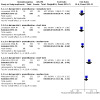
Comparison 3: Benzodiazepines versus antipsychotics plus antihistamines, Outcome 1: Tranquilisation or asleep: 1. sedation
3.2 to 3.4 Global state
One study reported most of these outcomes (Lorazepam 2004, IN). More people receiving lorazepam had not improved compared to those receiving combined haloperidol/promethazine in the immediate term (n = 200, 1 RCT, RR 1.79, 95% CI 1.36 to 2.37), short term (n = 200, 1 RCT, RR 2.47, 95% CI 1.51 to 4.03), and medium term (n = 200, 1 RCT, RR 2.17, 95% CI 1.16 to 4.05, low quality evidence).Analysis 3.2. Neither group required additional medication in the immediate term and there was no clear difference between groups in the short term (n = 200, RR 3.00, 95% CI 0.12 to 72.77) and medium term (n = 200, RR 1.33, 95% CI 0.31 to 5.81, low quality evidence).Analysis 3.3.
3.2. Analysis.
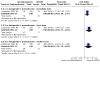
Comparison 3: Benzodiazepines versus antipsychotics plus antihistamines, Outcome 2: Global state: 1. no improvement (Clinical Global Impression (CGI) ‐ improvement scale dichotomised; much and very much improved)
3.3. Analysis.
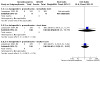
Comparison 3: Benzodiazepines versus antipsychotics plus antihistamines, Outcome 3: Global state: 2. need for additional medication
One study reported mean CGI scores (Lorazepam 2004, IN). The scores were higher in participants receiving combined haloperidol/promethazine than participants receiving benzodiazepines alone in the immediate term (n = 200, 1 RCT, MD 0.49, 95% CI 0.23 to 0.75) and short term (n = 200, 1 RCT, MD 0.60, 95% CI 0.34 to 0.86), but not the medium term (n = 200, 1 RCT, MD 0.23, 95% CI ‐0.05 to 0.51). Analysis 3.4.
3.4. Analysis.
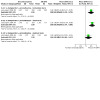
Comparison 3: Benzodiazepines versus antipsychotics plus antihistamines, Outcome 4: Global state: 3. mean endpoint score (CGI, high = worse)
3.5 Adverse effects/events
There were no clear differences in the specific adverse events: airway management (n = 501, 2 RCTs, RR 2.99, 95% CI 0.31 to 28.54), nausea (n = 200, 1 RCT, RR 3.00; 95% CI 0.12 to 72.77) or seizure (n = 301, 1 RCT, RR 0.33, 95% CI 0.01 to 8.06) when midazolam or lorazepam were compared with combined haloperidol/promethazine. Analysis 3.5
3.5. Analysis.
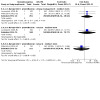
Comparison 3: Benzodiazepines versus antipsychotics plus antihistamines, Outcome 5: Adverse effects/events: 1. specific
3.6 Hospital and service outcomes
There was no clear difference in the number of people 'not discharged' in each treatment group (n = 200, medium term RR 1.13, 95% CI 0.86 to 1.48, Analysis 3.6).
3.6. Analysis.
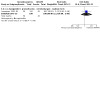
Comparison 3: Benzodiazepines versus antipsychotics plus antihistamines, Outcome 6: Hospital and service outcomes: 1. changes in hospital status
3.7 Leaving study early
There was no clear difference in people lost to follow‐up when midazolam and lorazepam were compared with combined haloperidol/promethazine (n = 501, 2 RCTs, RR 0.43, 95% CI 0.06 to 2.87, Analysis 3.7).
3.7. Analysis.
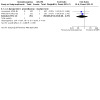
Comparison 3: Benzodiazepines versus antipsychotics plus antihistamines, Outcome 7: Leaving the study early: 1. any reason
Missing outcomes
For this comparions, non of the studies reported data for mental state, hospital and service outcomes, satisfaction with treatment or economic outcomes.
Comparison 4: Benzodiazepines plus antipsychotics versus same benzodiazepines
Five trials reported data comparing benzodiazepines plus antipsychotics versus same benzodiazepines (Clonazepam 2007a, CHN; Lorazepam 1997a, USA; Lorazepam 1998, USA; Lorazepam 1989, USA; Lorazepam 2006, USA).
4.1 Tranquillisation or asleep
Sedation was higher in the combined lorazepam/haloperidol group than the lorazepam only group in the short term (n = 47, 1 RCT, RR 1.92, 95% CI 1.10 to 3.35), although there was no difference in the medium term (n = 110, 2 RCTs, RR 0.84, 95% CI 0.59 to 1.19, low quality evidence). Analysis 4.1.
4.1. Analysis.
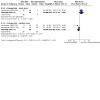
Comparison 4: Benzodiazepines plus antipsychotics vs same benzodiazepines, Outcome 1: Tranquillisation or asleep: 1. sedation
4.2 Behaviours
Medium‐term ABS scores for people receiving lorazepam were similar to those receiving combined lorazepam/haloperidol treatment (n = 63, 1 RCT, RR ‐1.60, 95% CI ‐5.94 to 2.74, Analysis 4.2).
4.2. Analysis.

Comparison 4: Benzodiazepines plus antipsychotics vs same benzodiazepines, Outcome 2: Behaviour: 1. mean endpoint score (Agitated Behaviour Scale, high = worse)
4.3 to 4.4 Global state
There was no clear difference in improvement when people who received combined lorazepam/haloperidol were compared to people receiving lorazepam in the short term (n = 20, 1 RCT, RR 0.11, 95% CI 0.01 to 1.74) or medium term (n = 113, 3 RCTs, RR 0.96, 95% CI 0.76 to 1.20, low quality evidence), or compared to people receiving combined lorazepam/risperidone in the medium term (n = 20, 1 RCT, RR 0.86, 95% CI 0.45 to 1.64, low quality evidence). Analysis 4.3. There was no clear difference in the number of participants requiring additional medication when lorazepam was compared with combined lorazepam/haloperidol in the medium term (n = 103, 3 RCTs, RR 1.02, 95% CI 0.79 to 1.32, low quality evidence), with no instances reported when comparing combined lorazepam/risperidone with lorazepam alone. Analysis 4.4.
4.3. Analysis.

Comparison 4: Benzodiazepines plus antipsychotics vs same benzodiazepines, Outcome 3: Global state: 1. no improvement mean endpoint change in Clinical Global Impression score)
4.4. Analysis.
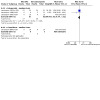
Comparison 4: Benzodiazepines plus antipsychotics vs same benzodiazepines, Outcome 4: Global state: 2. need for additional medication
4.5 to 4.12 Mental state
When no clinical improvement was defined as the decrease rate of BPRS score less than 30%, there was no clear difference between clonazepam and haloperidol (n = 30, 1 RCT, RR 1.00 CI 0.76 to 1.32, Analysis 4.5).
4.5. Analysis.
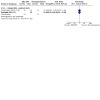
Comparison 4: Benzodiazepines plus antipsychotics vs same benzodiazepines, Outcome 5: Mental state: 1. no improvement (the decrease rate of Brief Psychiatric Rating Scale (BPRS) score < 30%)
There was no clear difference between people who received combined lorazepam/antipsychotics compared with people who received lorazepam alone for BPRS (short term: n = 20, 1 RCT, MD 1.10, 95% CI ‐23.17 to 25.37; medium term: n = 20, 1 RCT, MD ‐1.70, 95% CI ‐24.26 to 20.86). Analysis 4.6. BPRS psychosis subscale (n = 63, 1 RCT, MD 1.20, 95% CI ‐6.28 to 8.68, Analysis 4.10), BPRS positive subscale (n = 30, 1 RCT, MD 0.06, 95% CI ‐2.73 to 2.85, Analysis 4.11), BPRS excited component scale (n = 30, 1 RCT, MD ‐0.80, 95% CI ‐2.41 to 0.81, Analysis 4.12) and PANSS (short term: n = 20, 1 RCT, MD 6.40, 95% CI ‐36.50 to 49.30; medium term: n = 20, 1 RCT, MD 3.20, 95% CI ‐29.41 to 35.81, Analysis 4.8) . Data from Lorazepam 2006, USA could not be added to the meta‐analysis for BPRS (Analysis 4.7) and PANSS scores (Analysis 4.9) because data appeared to be skewed.
4.6. Analysis.
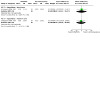
Comparison 4: Benzodiazepines plus antipsychotics vs same benzodiazepines, Outcome 6: Mental state: 2a. mean endpoint score (BPRS, high = worse)
4.10. Analysis.

Comparison 4: Benzodiazepines plus antipsychotics vs same benzodiazepines, Outcome 10: Mental state: 3a. mean endpoint score (BPRS psychosis subscale, high = worse)
4.11. Analysis.
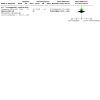
Comparison 4: Benzodiazepines plus antipsychotics vs same benzodiazepines, Outcome 11: Mental state: 3b. mean endpoint score (BPRS positive subscale, high = worse)
4.12. Analysis.
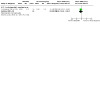
Comparison 4: Benzodiazepines plus antipsychotics vs same benzodiazepines, Outcome 12: Mental state: 4. mean endpoint score (BPRS‐excited component, high = worse)
4.8. Analysis.
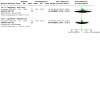
Comparison 4: Benzodiazepines plus antipsychotics vs same benzodiazepines, Outcome 8: Mental state: 2c. mean endpoint score (Positive and Negative Syndrome Scale (PANSS), high = worse)
4.7. Analysis.
Comparison 4: Benzodiazepines plus antipsychotics vs same benzodiazepines, Outcome 7: Mental state: 2b. mean endpoint score (BPRS, high = worse, skew)
| Mental state: 2b. mean endpoint score (BPRS, high = worse, skew) | ||||
| Study | Intervention | Mean | SD | N |
| + haloperidol ‐ short term | ||||
| Lorazepam 2006, USA | Lorazepam | 40.8 | 28.12 | 10 |
| Lorazepam+haloperidol | 48.2 | 65.46 | 10 | |
| + haloperidol ‐ medium term | ||||
| Lorazepam 2006, USA | Lorazepam | 35.5 | 25.61 | 10 |
| Lorazepam+haloperidol | 40.1 | 51.23 | 10 | |
4.9. Analysis.
Comparison 4: Benzodiazepines plus antipsychotics vs same benzodiazepines, Outcome 9: Mental state: 2d. mean endpoint score (PANSS, high = worse, skew)
| Mental state: 2d. mean endpoint score (PANSS, high = worse, skew) | ||||
| Study | Intervention | Mean | SD | N |
| + haloperidol ‐ short term | ||||
| Lorazepam 2006, USA | Lorazepam | 59.4 | 36.22 | 10 |
| Lorazepam+haloperidol | 74.6 | 100.22 | 10 | |
| + haloperidol ‐ medium term | ||||
| Lorazepam 2006, USA | Lorazepam | 53.9 | 35.53 | 10 |
| Lorazepam+haloperidol | 65.8 | 100.4 | 10 | |
4.13 to 4.15 Adverse effects/events
There was no clear difference in EPS when comparing combined lorazepam/haloperidol with lorazepam alone (n = 83, 2 RCTs, RR 1.94, 95% CI 0.18 to 20.30, Analysis 4.13, low quality evidence), but Lorazepam 1998, USA reported no instances of EPS in their study. There was also no clear difference in the need for medication for EPS (n = 63, 1 RCT, RR 0.73, 95% CI 0.18 to 2.99, Analysis 4.14), or any clear difference in the specific adverse events; akathisia, ataxia, dizziness, drowsiness, dry mouth or speech disorder, Analysis 4.15).
4.13. Analysis.
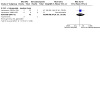
Comparison 4: Benzodiazepines plus antipsychotics vs same benzodiazepines, Outcome 13: Adverse effects/events: 1. extrapyramidal symptoms (EPS)
4.14. Analysis.
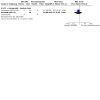
Comparison 4: Benzodiazepines plus antipsychotics vs same benzodiazepines, Outcome 14: Adverse effects/events: 2. use of medication for EPS
4.15. Analysis.
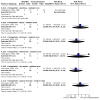
Comparison 4: Benzodiazepines plus antipsychotics vs same benzodiazepines, Outcome 15: Adverse effects/events: 3. specific
4.16 Leaving study early
There was no clear difference in the number of people leaving the study early when lorazepam was compared with combined lorazepam/haloperidol (n = 40, 2 RCTs, RR 0.71, 95% CI 0.34 to 1.50) or combined lorazepam/risperidone (n = 20, 1 RCT, RR 0.86, 95% CI 0.45 to 1.64). Analysis 4.16.
4.16. Analysis.
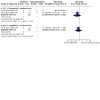
Comparison 4: Benzodiazepines plus antipsychotics vs same benzodiazepines, Outcome 16: Leaving the study early: 1. any reason
Missing outcomes
For this comparison, none of the studies reported hospital and service outcomes, satisfaction with treatment or economic outcomes.
Comparison 5: Benzodiazepines plus antipsychotics versus same antipsychotics
Six trials compared benzodiazepines plus antipsychotics versus same antipsychotics (Alprazolam 1992, USA; Clonazepam 2007a, CHN; Lorazepam 1989, USA; Lorazepam 1997a, USA; Lorazepam 2009, SK; Midazolam 2011, BZ). All trials compared combined benzodiazepine/haloperidol with haloperidol alone.
5.1 Tranquillisation or asleep
Sedation was significantly more likely in the combined benzodiazepines/haloperidol group compared with haloperidol in the short term (n = 45, 1 RCT, RR 2.25, 95% CI 1.18 to 4.30) and medium term (n = 172, 3 RCTs, RR 1.75, 95% CI 1.14 to 2.67, very low quality evidence) when using a fixed‐effect model. However, the medium‐term results were highly heterogeneous (Chi2 = 6.90, P = 0.03, I2 = 71%) and no longer significant when a random‐effects model was used (n = 172, 3 RCTs, RR 1.67, 95% CI 0.67 to 4.12). Analysis 5.1.
5.2 to 5.4 Behaviours
There was no clear difference in ABS agitation scores when lorazepam plus haloperidol was compared with haloperidol (n = 67, 1 RCT, MD ‐0.20, 95% CI ‐5.05 to 4.65, Analysis 5.2). OAS aggression scores were also not different when combined midazolam/haloperidol was compared with haloperidol in the short term (n = 60, 1 RCT, MD 1.20, 95% CI ‐0.04 to 2.44) but in the medium term favoured the haloperidol only group (n = 60, 1 RCT, MD 2.40, 95% CI 0.59 to 4.21). Analysis 5.3. Agitation scores using the OASS were significantly higher in the midazolam/haloperidol group compared with haloperidol in the short term (n = 60, 1 RCT, MD 8.50, 95% CI 7.07 to 9.93) and medium term (n = 60, 1 RCT, MD 6.70, 95% CI 5.94 to 7.46, Analysis 5.4).
5.2. Analysis.
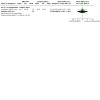
Comparison 5: Benzodiazepines plus antipsychotics versus same antipsychotics, Outcome 2: Behaviour: 1. mean endpoint score (Agitated Behaviour Scale, high = worse)
5.3. Analysis.
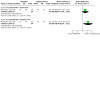
Comparison 5: Benzodiazepines plus antipsychotics versus same antipsychotics, Outcome 3: Behaviour: 2. mean endpoint score (Overt Aggression Scale (OAS), high = worse)
5.4. Analysis.
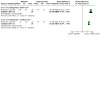
Comparison 5: Benzodiazepines plus antipsychotics versus same antipsychotics, Outcome 4: Behaviour: 3. mean endpoint score (Overt Agitation Severity Scale, high = worse)
5.5 to 5.8 Global state
In the medium term, people who received combined benzodiazepines/haloperidol were no more likely to improve than those receiving haloperidol alone (n = 185, 4 RCTs, RR 1.17, 95% CI 0.93 to 1.46, Analysis 5.5, low quality evidence). These results were heterogeneous (Chi2 = 11.15, P = 0.01, I2 = 73%) but this was due to one small study contributing only 2.9% of weight to the analysis. The findings using a random‐effects model were very similar (n = 185, 4 RCTs, RR 1.04 CI 0.67 to 1.62). In the medium term, people receiving haloperidol alone were no more likely to require additional medication than those receiving combined lorazepam/haloperidol (n = 67, 1 RCT, RR 0.95, 95% CI 0.79 to 1.15). Analysis 5.6, low quality evidence). There was also no clear difference in mean doses of additional medication when midazolam plus haloperidol was compared with midazolam (n = 60, 1 RCT, MD 0.20, 95% CI ‐0.33 to 0.73, Analysis 5.7). Mean change scores for the RSS were significantly higher in the combined midazolam/haloperidol group when compared with haloperidol in the short term (n = 60, 1 RCT, MD 0.50, 95% CI ‐0.01 to 1.01) although this was not different in the medium term (n = 60, 1 RCT, MD 0.10, 95% CI ‐0.36 to 0.56). Analysis 5.8.
5.6. Analysis.
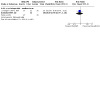
Comparison 5: Benzodiazepines plus antipsychotics versus same antipsychotics, Outcome 6: Global state: 2. need for additional medication
5.7. Analysis.
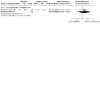
Comparison 5: Benzodiazepines plus antipsychotics versus same antipsychotics, Outcome 7: Global state: 3. need for additional medication (mean dose, high = worse)
5.8. Analysis.
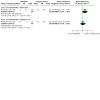
Comparison 5: Benzodiazepines plus antipsychotics versus same antipsychotics, Outcome 8: Global state: 4. mean change score (Ramsey Sedation Scale, high = worse)
5.9 to 5.13 Mental state
When clinical improvement was defined as the decrease rate of BPRS score less than 30%, there was no clear difference between clonazepam and haloperidol (n = 30, 1 RCT, RR 0.93, 95% CI 0.73 to 1.18, Analysis 5.9). Alprazolam 1992, USA reported medium‐term BPRS scale data, with no significant difference between (n = 28, MD 0.01, 95% CI ‐7.26 to 7.28, Analysis 5.10). There was no different between groups receiving the combined treatment compared to benzodiazepine alone in the medium term for BPRS psychosis subscale scores (n = 95, 2 RCTs, MD ‐1.19, 95% CI ‐4.60 to 2.23, Analysis 5.11), BPRS positive scores (n = 30, 1 RCT, MD 0.86, 95% CI ‐1.62 to 3.34, Analysis 5.12) and BPRS excited component scores (n = 30, 1 RCT, MD 0.47, 95% CI ‐1.32 to 2.26). Analysis 5.13.
5.9. Analysis.

Comparison 5: Benzodiazepines plus antipsychotics versus same antipsychotics, Outcome 9: Mental state: 1. no improvement (the decrease rate of Brief Psychiatric Rating Scale (BPRS) score < 30%)
5.10. Analysis.
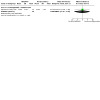
Comparison 5: Benzodiazepines plus antipsychotics versus same antipsychotics, Outcome 10: Mental state: 2. mean endpoint score (BPRS, high = worse)
5.11. Analysis.
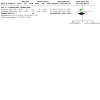
Comparison 5: Benzodiazepines plus antipsychotics versus same antipsychotics, Outcome 11: Mental state: 3a. mean endpoint score (BPRS psychosis subscale, high = worse)
5.12. Analysis.
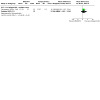
Comparison 5: Benzodiazepines plus antipsychotics versus same antipsychotics, Outcome 12: Mental state: 3b. mean endpoint score (BPRS positive subscale, high = worse)
5.13. Analysis.
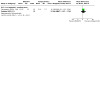
Comparison 5: Benzodiazepines plus antipsychotics versus same antipsychotics, Outcome 13: Mental state: 4. mean endpoint score (BPRS‐excited component, high = worse)
5.14 to 5.16 Adverse effects/events
There was no clear difference in the rate of EPS (n = 127, 2 RCTs, RR 0.44, 95% CI 0.16 to 1.17, Analysis 5.14, low quality evidence) or medication for EPS (n = 95, 2 RCTs, RR 0.52, 95% CI 0.27 to 1.01, Analysis 5.15) when people receiving combined benzodiazepines/haloperidol were compared with those receiving haloperidol alone. There was no clear difference between groups when assessing specific adverse events (Analysis 5.16).
5.14. Analysis.
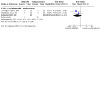
Comparison 5: Benzodiazepines plus antipsychotics versus same antipsychotics, Outcome 14: Adverse effects/events: 1. extrapyramidal symptoms (EPS)
5.15. Analysis.
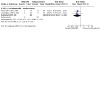
Comparison 5: Benzodiazepines plus antipsychotics versus same antipsychotics, Outcome 15: Adverse effects/events: 2. use of medication for EPS
5.16. Analysis.
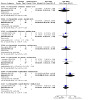
Comparison 5: Benzodiazepines plus antipsychotics versus same antipsychotics, Outcome 16: Adverse effects/events: 3. specific
5.17 Hospital and service outcomes
In Alprazolam 1992, USA, there was no difference in participants who had not been discharged in the medium term (n = 28, 1 RCT, RR 0.90, 95% CI 0.54 to 1.50, Analysis 5.17).
5.17. Analysis.
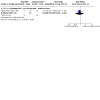
Comparison 5: Benzodiazepines plus antipsychotics versus same antipsychotics, Outcome 17: Hospital and service outcomes: 1. changes in hospital status
Missing outcomes
For this comparison, none of the studies reported leaving the study early, satisfaction with treatment or economic outcomes.
Comparison 6: Benzodiazepines plus antipsychotics versus antipsychotics plus antipsychotics
One study compared benzodiazepines plus antipsychotics versus antipsychotics plus antipsychotics (Lorazepam 1998, SA).
6.1 Behaviour
There was no clear difference in medium‐term OAS scores when combined lorazepam/haloperidol was compared with combined clothiapine/haloperidol (n = 60, 1 RCT, MD ‐5.83, 95% CI ‐27.60 to 15.94, Analysis 6.1).
6.1. Analysis.
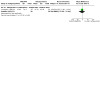
Comparison 6: Benzodiazepines + antipsychotics versus antipsychotics plus antipsychotics, Outcome 1: Behaviour: 3. mean endpoint score (Overt Aggression Scale, high = worse)
6.2 Leaving the study early
The study reported no participants left the study early (Analysis 6.2).
6.2. Analysis.
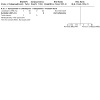
Comparison 6: Benzodiazepines + antipsychotics versus antipsychotics plus antipsychotics, Outcome 2: Leaving the study early: 1. any reason
Missing outcomes
For this comparison, none of the studies reported data for tranquilisation or asleep, global state, mental state, adverse effects/events, hospital and service outcomes, satisfaction with treatment or economic outcomes.
Comparison 7: Benzodiazepines plus antipsychotics versus antipsychotics plus antihistamines
One study compared benzodiazepines plus antipsychotics versus antipsychotics plus antihistamines (Midazolam 2011, BZ).
7.1 Tranquillisation or asleep
Medium‐term sedation was higher in the midazolam/haloperidol group (n = 60, 1 RCT, RR 12.00, 95% CI 1.66 to 86.59, very low quality evidence,Analysis 7.1).
7.1. Analysis.
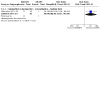
Comparison 7: Benzodiazepines plus antipsychotics versus antipsychotics plus antihistamines, Outcome 1: Tranquilisation or asleep: 1. sedation
7.2 to 7.3 Behaviours
OAS aggression scores in people receiving combined midazolam/haloperidol were significantly lower than scores in the combined promethazine/haloperidol group in the short term (n = 60, 1 RCT, MD ‐3.30, 95% CI ‐5.25 to ‐1.35), but there was no clear difference in the medium term (n = 60, 1 RCT, MD 1.70, 95% CI ‐0.06 to 3.46). Analysis 7.2. People who received combined midazolam/haloperidol scored lower on the OASS agitation scale in the short term (n = 60, 1 RCT, MD ‐16.00, 95% CI ‐18.98 to ‐13.02) and medium term (n = 60, 1 RCT, MD ‐2.70, 95% CI ‐3.73 to ‐1.67). Analysis 7.3.
7.2. Analysis.
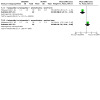
Comparison 7: Benzodiazepines plus antipsychotics versus antipsychotics plus antihistamines, Outcome 2: Behaviour: 1. mean endpoint score (Overt Aggression Scale (OAS), high = worse)
7.3. Analysis.
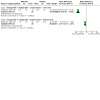
Comparison 7: Benzodiazepines plus antipsychotics versus antipsychotics plus antihistamines, Outcome 3: Behaviour: 2. mean endpoint score (Overt Agitation Severity Scale (OASS) agitation scale, high = worse)
7.4 to 7.6 Global state
In the medium term, more people receiving combined midazolam/haloperidol had not improved (n = 60, 1 RCT, RR 25.00, 95% CI 1.55 to 403.99, very low quality evidence,Analysis 7.4) and were given a higher dose of additional medication compared with the combined promethazine/haloperidol group (n = 60, 1 RCT, MD 0.63, 95% CI 0.15 to 1.11, Analysis 7.5). Short‐term RSS sedation scores (n = 60, 1 RCT, MD short term 0.60, 95% CI 0.07 to 1.13) were higher in the midazolam/haloperidol group, although there was no clear difference in medium‐term RSS scores (n = 60, 1 RCT, MD 0.00, 95% CI ‐0.46 to 0.46). Analysis 7.6.
7.4. Analysis.
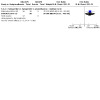
Comparison 7: Benzodiazepines plus antipsychotics versus antipsychotics plus antihistamines, Outcome 4: Global state: 1. no improvement (number of participants with < 10 points on the OAS and OASS after 12 hours)
7.5. Analysis.

Comparison 7: Benzodiazepines plus antipsychotics versus antipsychotics plus antihistamines, Outcome 5: Global state: 2. need for additional medication (mean dose, high = worse)
7.6. Analysis.
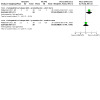
Comparison 7: Benzodiazepines plus antipsychotics versus antipsychotics plus antihistamines, Outcome 6: Global state: 3. mean change score (Ramsey Sedation Scale, high = worse)
7.7 to 7.8 Adverse events
There was no clear difference between groups in the incidence of EPS in the medium‐term (n = 60, 1 RCT, RR 0.60, 95% CI 0.16 to 2.29, very low quality evidence,Analysis 7.7) or hypotension (n = 60, 1 RCT, RR 1.67, 95% CI 0.44 to 6.36, Analysis 7.8).
7.7. Analysis.
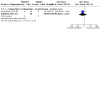
Comparison 7: Benzodiazepines plus antipsychotics versus antipsychotics plus antihistamines, Outcome 7: Adverse effects/events: 1. extrapyramidal symptoms
7.8. Analysis.
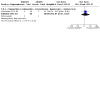
Comparison 7: Benzodiazepines plus antipsychotics versus antipsychotics plus antihistamines, Outcome 8: Adverse effects/events: 2. specific
Missing outcomes
For this comparison, none of the studies reported data for leaving the study early, hospital and service outcomes, satisfaction with treatment or economic outcomes.
Sensitivity analyses
We conducted sensitivity analyses for Comparison 2 (benzodiazepines versus antipsychotics) for the primary outcome of our primary outcome tranqulisation or asleep (sedation) and additional outcomes of global state 'improvement' and adverse effects 'extrapyramidal symptoms' as these analyses had the most available data.
8. Sensitivity analysis ‐ Randomised sequence generation
In trials rated as low risk of bias, people receiving benzodiazepines were significantly more likely to be sedated compared with people receiving antipsychotics (n = 247, 3 RCTs, RR 2.22, 95% CI 1.52 to 3.25) with slight heterogeneity (Chi2 = 2.26, P = 0.32, I2 = 11%); there was no clear difference between groups in trials where the method of sequence generation was unclear (n = 340, 6 RCTs, RR 0.84, 95% CI 0.56 to 1.26, Analysis 8.1). The test for differences between subgroups was significant and demonstrated high heterogeneity (Chi2 = 11.86, P = 0.0006, I2 = 91.6%).
8.1. Analysis.
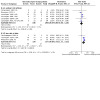
Comparison 8: Sensitivity analysis: benzodiazepines versus antipsychotics ‐ 1. Random sequence generation, Outcome 1: Tranquilisation or asleep: 1. sedation
In trials rated as low risk of bias, there was no clear difference between groups in the numbers who had not improved (n = 124, 3 RCTs, RR 1.01, 95% CI 0.80 to 1.28, Analysis 8.2), neither was there any clear difference between groups in trials where the method of sequence generation was unclear (n = 214, 3 RCTs, RR 1.13, 95% CI 0.78 to 1.63); however, heterogeneity was high (Chi2 = 9.34, P =.009, I2 = 79%). The test for differences between subgroups was not significant (Chi2 = 0.06, P = 0.81, I2 = 0%).
8.2. Analysis.
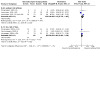
Comparison 8: Sensitivity analysis: benzodiazepines versus antipsychotics ‐ 1. Random sequence generation, Outcome 2: Global state: 1. no improvement
The estimates of EPS were similar in trials with a low risk of bias (n = 247, 3 RCTs, RR 0.16, 95% CI 0.03 to 0.85) and for trials that were unclear (n = 285, 5 RCTs, RR 0.15, 95% CI 0.05 to 0.47); both trials demonstrating a clear difference between benzodiazepines and antipsychotics (Analysis 8.3). There was no significant difference between subgroups (Chi2 = 0.00, P = 0.95, I2 = 0%).
8.3. Analysis.
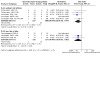
Comparison 8: Sensitivity analysis: benzodiazepines versus antipsychotics ‐ 1. Random sequence generation, Outcome 3: Adverse effects/events: 1. extrapyramidal symptoms
9. Sensitivity analysis ‐ Allocation concealment
People receiving benzodiazepines were more likely to be sedated in the one trial rated at low risk of bias for allocation concealment (n = 153, RR 2.71, 95% CI 1.55 to 4.73), although there was no clear difference between groups for those trials rated as unclear (n = 434, 8 RCTs, RR 1.08, 95% CI 0.79 to 1.48, Analysis 9.1). The difference between subgroups was clear and demonstrated high heterogeneity (Chi2 = 7.86, P = 0.005, I2 = 87.3%).
9.1. Analysis.
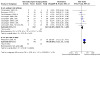
Comparison 9: Sensitivity analysis: benzodiazepines versus antipsychotics ‐ 2. Allocation concealment, Outcome 1: Tranquilisation or asleep: 1. sedation
All trials reporting improvement/no improvement were rated as having an unclear risk of bias. There was no clear difference in 'no improvement' (n = 338, 6 RCTs, RR 1.07, 95% CI 0.86 to 1.32); however, results displayed high heterogeneity (Chi2 = 11.33, P = 0.05, I2 = 56%, Analysis 9.2).
9.2. Analysis.
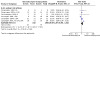
Comparison 9: Sensitivity analysis: benzodiazepines versus antipsychotics ‐ 2. Allocation concealment, Outcome 2: Global state: 1. no improvement
The risk of EPS was similar in the benzodiazepine and antipsychotics group in one study at a low risk of bias (n = 153, RR 0.15, 95% CI 0.01 to 2.90) and slightly reduced in the seven trials with an unclear risk of allocation bias (n = 379, 7 RCTs, RR 0.15, 95% CI 0.06 to 0.41, Analysis 9.3). There was no significant difference between subgroups (Chi2 = 0.00, P = 1.00, I2 = 0%).
9.3. Analysis.
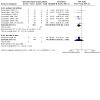
Comparison 9: Sensitivity analysis: benzodiazepines versus antipsychotics ‐ 2. Allocation concealment, Outcome 3: Adverse effects/events: 1. extrapyramidal symptoms
10. Sensitivity analysis ‐ Blinded outcome measurement
There was a clear difference in the amount of people who were sedated in the benzodiazepines group in those trials that were rated at low risk of bias (n = 119, 2 RCTs, RR 1.66, 95% CI 1.05 to 2.64), but not in trials rated at unclear risk of bias (n = 424, 6 RCTs, RR 1.34, 95% CI 0.93 to 1.94) for blinded outcome measurement. There was also no clear change in trials exhibiting a high risk (n = 44, 1 RCT, RR 1.14, 95% CI 0.56 to 2.34); however, heterogeneity was high (Analysis 10.1). There was no clear difference between subgroups (Chi2 = 0.89, P = 0.64, I2 = 0%).
10.1. Analysis.
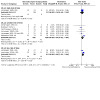
Comparison 10: Sensitivity analysis: benzodiazepines versus antipsychotics ‐ 3. Blinded outcome measurement, Outcome 1: Tranquilisation or asleep: 1. sedation
In trials rated as having an unclear risk of bias, the rate of no improvement was similar between people receiving benzodiazepines and people receiving antipsychotics (n = 224, 4 RCTs, RR 1.18, 95% CI 0.88 to 1.59), the heterogeneity was high (Chi2 = 12.97, P = 0.005; I2 = 77%) and in trials rated at low risk of bias, there was no clear difference in improvement between groups (n = 114, 2 RCTs, RR 0.80, 95% CI 0.60 to 1.07), but heterogeneity was high (Chi2 = 3.15, P = 0.08, I2 = 68%); differences between subgroups were significant with high heterogeneity (Chi2 = 3.36, P = 0.07, I2 = 70.2%, Analysis 10.2).
10.2. Analysis.
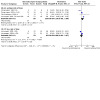
Comparison 10: Sensitivity analysis: benzodiazepines versus antipsychotics ‐ 3. Blinded outcome measurement, Outcome 2: Global state: 1. no improvement
There was a clearly decreased risk of EPS in people receiving benzodiazepines, irrespective of whether trials were rated as low risk of bias (n = 106, 2 RCTs, RR 0.12, 95% CI 0.03 to 0.48) or unclear risk of bias (n = 426, 6 RCTs, RR 0.19, 95% CI 0.05 to 0.68) for blinded outcome measurement (Analysis 10.3). There was no significant difference between subgroups (Chi2 = 0.21, P = 0.64, I2 = 0%).
10.3. Analysis.
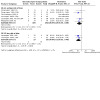
Comparison 10: Sensitivity analysis: benzodiazepines versus antipsychotics ‐ 3. Blinded outcome measurement, Outcome 3: Adverse effects/events: 1. extrapyramidal symptoms
11. Sensitivity analysis ‐ Incomplete outcome data (attrition bias)
There was no clear difference in sedation whether trials were rated at low risk of bias (n = 260, 4 RCTs, RR 1.30, 95% CI 0.83 to 2.03) or at unclear risk of bias (n = 134, 3 RCTs, RR 1.07, 95% CI 0.62 to 1.83). Where risk of bias was high, there was a difference in favour of antipsychotics, but heterogeneity between trials was high (n = 193, 2 RCTs, RR 1.78, 95% CI 1.15 to 2.75, Analysis 11.1). Apparent differences between subgroups were not significant (Chi2 = 2.23, P = 0.33, I2 = 10.1%).
11.1. Analysis.
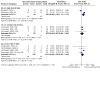
Comparison 11: Sensitivity analysis: benzodiazepines versus antipsychotics ‐ 4. Incomplete outcome data (attrition bias), Outcome 1: Tranquilisation or asleep: 1. sedation
Trials rated as a low risk of attrition bias were more likely to find similar rates of no improvement in people receiving benzodiazepines compared with people receiving antipsychotics (n = 290, 5 RCTs, RR 1.23, 95% CI 0.98 to 1.56), whereas, in the one trial rated at unclear risk of bias, there was a lower rate of no improvement in people receiving benzodiazepines identified (n = 48, RR 0.56, 95 % CI 0.32 to 0.97). There was a clear difference between these subgroups (Chi2 = 6.65, P = 0.01, I2 = 85.0%, Analysis 11.2).
11.2. Analysis.
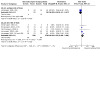
Comparison 11: Sensitivity analysis: benzodiazepines versus antipsychotics ‐ 4. Incomplete outcome data (attrition bias), Outcome 2: Global state: 1. no improvement
The finding that the incidence of EPS was lower in people receiving benzodiazepines was clearly identified in low risk of bias trials (n = 302, 5 RCTs, RR 0.18, 95% CI 0.06 to 0.60) and in unclear risk of bias trials (n = 77, 2 RCTs, RR 0.09, 95% CI 0.01 to 0.65), but not in high risk of bias trials (n = 153, 1 RCT, RR 0.15, 95% CI 0.01 to 2.90, Analysis 11.3). However, this apparent difference between subgroups was not significant (Chi2 = 0.44, P = 0.93, I2 = 0%).
11.3. Analysis.
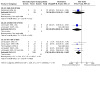
Comparison 11: Sensitivity analysis: benzodiazepines versus antipsychotics ‐ 4. Incomplete outcome data (attrition bias), Outcome 3: Adverse effects/events: 1. extrapyramidal symptoms
Publication bias
Sedation data from the comparison of benzodiazepines versus antipsychotics were used to investigate whether there was evidence of systematic small trial bias in a funnel plot analysis. There was a small number of trials and it was difficult to be sure of any asymmetry (Figure 1). We think it inadvisable to read too much into this exploratory, low‐powered technique of investigation. What is needed are more trials with a wide spread of findings.
Discussion
Summary of main results
Comparison 1: Benzodiazepines versus placebo
See Table 1. There was some evidence that lorazepam was superior to placebo in terms of improvement and behaviour in the medium but not short term, although these data came from a single small study with very serious risk of bias and were, therefore, graded as very low quality evidence. There was no clear evidence of a difference between groups in tranquillisation, mental state, adverse events or leaving the study early.
It is understandable that placebo‐controlled trials in this area are uncommon as withholding treatment from people in such a distressed state can be considered unethical. Therefore, evidence from RCTs that benzodiazepines are superior to placebo is insufficient.
Comparison 2: Benzodiazepines versus antipsychotics
See Table 2. Overall, there was very low‐ to low‐quality evidence of no difference between benzodiazepines and antipsychotics in terms of global state (e.g. clinical improvement or need for additional medication) or sedation, or both. However, there as low‐quality evidence from single small studies showing a clear difference between groups, One small study found that olanzapine was superior to lorazepam in terms of clinical improvement (n = 150, Lorazepam 2001, RO and USA). One small study with high attrition rates found that midazolam can achieve higher rates of sedation than droperidol (n = 163, Midazolam 2006, AU). On esmall study found lorazepam can reduce the severity of symptoms compared with haloperidol when measured by CGI (n = 37, Lorazepam 1997b, USA). Due to the high levels of heterogeneity between studies and the very low quality of evidence, it was difficult to make any conclusions from the results on the need of additional medication comparing benzodiazepines and antipsychotics. Moreover, there was no evidence available looking at the short‐term effect of benzodiazepines and haloperidol on various outcomes such as sedation, improvement in global state, adverse effects and need for additional medication.
In addition, low‐quality evidence showed that EPS were considerably lower in people receiving benzodiazepines. The data suggest EPS were significantly higher in people receiving antipsychotics and this should be considered in choosing the correct treatment in an emergency situation. In clinical practice, antipsychotics and mainly typical antipsychotics are often accompanied by anticholinergic treatment that may substantially decrease the incidence of EPS particularly in non‐organic psychosis. Therefore, the use of atypical antipsychotics based on the reduced EPS profile may be a suitable potential treatment option. Typical antipsychotics such as haloperidol without accompanying anticholinergics does not seem acceptable and this is consistent with outcomes of other relevant reviews (Huf 2009).
There was no difference between groups for mental state and other adverse events. Considering the above findings, due to the very low or low quality of evidence, the difference between benzodiazepine and antipsychotics for acute agitation remain uncertain.
Comparison 3: Benzodiazepines versus antipsychotics plus antihistamines
See Table 3. This comparison included Midazolam 2003, BZ and Lorazepam 2004, IN, which were larger trials. Results for improvement and global state scores favoured the use of combined haloperidol/promethazine over lorazepam but all these data came from Lorazepam 2004, IN; sedation was reported in both Midazolam 2003, BZ and Lorazepam 2004, IN trials, but data could not be pooled because of substantial heterogeneity between the two trials. People receiving midazolam were more likely to become sedated compared with combined haloperidol/promethazine in Midazolam 2003, BZ, unlike Lorazepam 2004, IN where people receiving combined haloperidol/promethazine were more likely to become sedated. Possible reasons for this dramatic heterogeneity was discussed in depth in another review (Huf 2009), but the most likely reason is midazolam is a faster‐acting and more potent benzodiazepine than lorazepam (Larson 1994). Clinically, sedation caused by combined haloperidol/promethazine was dose related.
Lorazepam 2004, IN reported the use of physical restraints. Throughout the course of the trial, people receiving lorazepam alone were more likely to be mechanically restrained than people who received combined haloperidol/promethazine. Although restraint was not a stated outcome in our protocol and may be of more relevance to clinicians in countries where the use of mechanical restraints is employed, we feel that it is an important outcome and should be considered in future reviews and trials.
In these larger and better‐reported trials, adverse effects were infrequent but important, and included respiratory depression, nausea and seizure. Respiratory depression is a very serious potential adverse effect of all benzodiazepines, and occurred in both trials. One participant in Midazolam 2003, BZ watdmitted with cocaine‐induced aggression, a potential mitigating factor.
The above findings were based on low‐quality evidence, and results from future studies are likely to change the findings.
Comparison 4: Benzodiazepines plus antipsychotics versus same benzodiazepines
See Table 4. There was little difference between combined benzodiazepines/antipsychotics compared with benzodiazepines alone but the quality of these data was low. The only significant difference was that sedation was more likely in people receiving the combination in the short term, although these data were from one small trial. Ratings of global state, mental state, behaviour and adverse effects were all equivocal between groups ‐ as could be expected in such low power. A real and important difference could exist, but larger trials are needed before any confident conclusions can be drawn.
Comparison 5: Benzodiazepines plus antipsychotics versus same antipsychotics
See Table 5. There were no apparent advantages in using combined benzodiazepines/antipsychotics compared with antipsychotics alone in terms of our primary outcome of no improvement but there were relatively few data with considerable heterogeneity. In addition, as each of the included trials defined 'improvement' differently, it was difficult to interpret how meaningful these data were.
Sedation rates were significantly higher in the combined benzodiazepines/haloperidol group compared with haloperidol alone in the short and medium term although the medium‐term data were heterogeneous. There were no differences between groups in the incidence of EPS or other adverse effects but these were rated as low‐quality evidence.
Behaviour scores did seem to favour haloperidol when compared with combined midazolam/haloperidol but these data came from one small trial (n = 60). This finding may be changed by further trials.
Comparison 6: Benzodiazepines plus antipsychotics versus antipsychotics plus antipsychotics
See Table 6. The only trial to report data for this comparison provided few data (Lorazepam 1998, SA), with no documented instances of people leaving the study early, and no difference in aggression ratings. Therefore, it is difficult to draw any meaningful conclusions from this comparison; larger, more informative trials with clearly defined outcomes are needed before any conclusions can be made.
Comparison 7: Benzodiazepines plus antipsychotics versus antipsychotics plus antihistamines
See Table 7. Only one trial reported two relevant arms (total n = 60), and the quality of evidence was very low (Midazolam 2011, BZ). There was very low quality evidence that combined haloperidol/promethazine was significantly better than combined midazolam/haloperidol in terms of improvement, need for additional medication, sedation and behaviour. However, as the quality of the evidence was very low, it was difficult to draw any meaningful conclusions.
Sensitivity analysis
Although sensitivity analyses were conducted for the 'Risk of bias' criteria, sequence generation, allocation concealment, blinded outcome measurement and incomplete data, there were few differences between trials at high, low and unclear risk of bias. Trials at low risk of bias for sequence generation, allocation concealment and blinded outcome measurement were more likely to favour benzodiazepines over antipsychotics in terms of sedation and lowering the risk of EPS. However, these findings were based on relatively few data and should at this stage be interpreted with caution.
Overall completeness and applicability of evidence
1. Completeness
1.1. Power
1.1.1. Limited power
We only found one trial (n = 102) comparing benzodiazepines with placebo. Although data were incomplete, we know enough to suggest that randomisation of benzodiazepine versus placebo to be ethical only in the most constrained services of such limited supply that anything but randomisation would be inequitable.
Eleven trials compared benzodiazepines directly with antipsychotics, and most of trials had small sample sizes. When a benzodiazepine was compared with combined benzodiazepine/antipsychotic, the five trials had a mean of 50 participants. Even if the outcome reporting had been comprehensive (taking into account views of clinicians and participants as well as researchers), the depth and strength of evidence in this area is very far from complete. Despite an increasing trend to consider atypical antipsychotics as more suitable for rapid tranquillisation than the older antipsychotics, there were inadequate data to compare atypical antipsychotics with benzodiazepines. Such promotion of the antipsychotics is based more on well‐meaning faith combined with an understandable lack of resistance from industry rather than good evidence.
The two TREC trials (Tranquilização Rápida‐Ensaio Clínico (Rapid Tranquillisation‐Clinical Trial)) that compared benzodiazepines with combined haloperidol/promethazine were large (n = 200 and 301), high‐powered trials, recognised for high methodological quality in this area of research (NICE 2015). These trials did not have an emphasis on recording scale‐derived data but did provide useful binary outcomes.
The comparison for combined benzodiazepines/haloperidol versus combined haloperidol/promethazine was very limited (1 RCT, n = 60) with few data from a single trial with multiple treatment arms. All outcomes need to be interpreted with great caution.
1.1.2. No power
The trial search did not identify trials that compared specific benzodiazepines at a high versus low dose; oral versus IM/intravenous; or low frequency versus high frequency (as defined by each study). Future research could examine these comparisons to highlight any potential benefits/efficacy of specifically named benzodiazepines in the management of psychosis‐induced aggression/agitation.
1.2. Outcome measurement
1.2.1. Measures
A major difficulty in synthesising data from trials in this review was the considerable variability in what and how outcomes were measured. Several trials reported outcomes that were not within the specified time period and therefore could not be used.
Given the potential for adverse events with benzodiazepines and antipsychotics, future trials should ensure that these data are collected and reported. In addition, as most trials allow for 'as‐needed' repeat doses of these drugs, the number of additional doses or mean dosage is also an important outcome in these trials.
The trials used a range of modified versions of validated measures or domain scores, thus, these data could not be synthesised in this review. If scales are to be used, it is important that they, and the individual subscales, are validated. Consistent use of measures of agreed importance is important.
1.2.2. Sedation
There is a need to achieve behavioural control without sedation (Rocca 2006). This perspective is reflected by sedation being reported as a positive outcome in earlier trials but as negative in more recent trials. However, sedation remains important and should be recorded and value judgements can be made by those who wish to use the evidence. In future trials, other outcomes such as improvement should be reported, as consensus guidelines have emphasised that calming an agitated/aggressive person is the key goal in an acute setting as opposed to rapid tranquillisation (Allen 2005).
2. Applicability
Despite a relatively broad range of inclusion criteria in regard to participants and settings, results were quite homogenous. Largely, participants, interventions and situations of administration were familiar to the average clinical setting and the data seem to be applicable. Benzodiazepines and antipsychotics were used quite consistently across trials. The majority used lorazepam or haloperidol in consistent clinically applicable doses. Only six trials used atypical antipsychotics.
The major sources of heterogeneity were CGI scores when lorazepam and diazepam were compared with haloperidol (Analysis 2.6), OASS scores when combined midazolam/haloperidol was compared with olanzapine and ziprasidone (Analysis 5.6), and sedation when lorazepam and midazolam were compared with combined haloperidol/promethazine (Analysis 3.1). There were several potential reasons for this heterogeneity. The most identifiable of these were differences in the types and doses of benzodiazepines and antipsychotics that were used.
Quality of the evidence
Overall, most quality criteria were poorly reported in the trials included in this review. Large, well‐designed, clinically relevant and clearly reported trials are clearly possible (Lorazepam 2004, IN; Midazolam 2003, BZ), but these are very much the exceptions to the rule. The randomisation methods and allocation concealment were poorly reported in the included trials. Most trials did not state whether they had concealed the group allocation regimen. Some trials used a double‐blind design, however, did not state who was blinded (e.g. participants, outcome assessor, data analyser). About 30% of trials were supported by pharmaceutical institutes.
The quality of evidence was low to very low, the main reasons for downgrading the evidence were very small sample size and serious risk of bias across included studies.
Potential biases in the review process
It is entirely possible that we have not identified small negative trials and would be most interested if readers know of these.
Agreements and disagreements with other studies or reviews
The findings of this review agree with other narrative syntheses of the literature that have concluded that benzodiazepines are at least as effective as antipsychotics in controlling severely agitated behaviour (Allen 2000; NICE 2005; Rocca 2006); however, because benzodiazepines have the potential to cause respiratory depression, their use should be carefully monitored in an environment suited to manage such cases. The findings are also consistent with other similar and overlapping reviews (see Implications for practice: 3. for managers and policy‐makers).
Authors' conclusions
Implications for practice.
1. For people with agitation/aggression due to schizophrenia or schizophrenia‐like illnesses
The intervention selected must be a reasonable and proportionate response to the risk posed by the person at that particular time. The aim of rapid tranquillisation is to achieve a state of calm sufficient to minimise the risk posed to patients or others. To achieve this state of calmness, various interventions can be used ranging from de‐escalation to pharmacological. Benzodiazepines are a viable option for care in acute aggression though secondary to psychotic illness, but much of the data on which practice is based are poor (although there are exceptions). Many recommendations for treatment are based on clinician's experience, expert consensus or local prescribing practice rather than data from high‐quality trials or well‐considered consumer feedback. We think that the situation is changing but certainly more well‐designed, conducted and reported trials are needed.
2. For clinicians
The data suggest that there is no difference between benzodiazepines and antipsychotics in particular relation to sedation but data are limited and not of high quality. Moreover, low‐quality evidence of differences between benzodiazepine and olanzapine exists even if not for every outcome. Using a combined benzodiazepine/antipsychotic does not seem to confer any advantage over use of either drug alone. There is some evidence that newer antipsychotics may be more beneficial than benzodiazepines but data are very limited.
3. For managers or policy‐makers
Lack of high‐quality evidence leaves managers and policy makers with difficult decisions to make. There is currently insufficient clinical evidence to suggest that the benzodiazepine group of drugs (alone or in combination with antipsychotics) is clearly superior to antipsychotics in reducing acute psychotic behaviour.
Implications for research.
1. General
Adherence to the CONSORT statement would probably have resulted in this review being more conclusive (Moher 2001). Clear descriptions of randomisation would have reassured users of these trials that selection bias had been minimised and well‐described and blinded outcome measurement could have encouraged greater confidence in the control of performance and detection bias. The use of validated binary outcomes should take preference over continuous results because they are easier to interpret and better reporting of validated rating scales would have provided more usable data. The reporting of outcomes with their means and standard deviations, again, would have provided more usable data and facilitated synthesis of findings. When presenting data in a graph, the exact numbers and standard deviations should also be reported.
2. Specific
2.1. Reviews
Although our original protocol specified a focus on rapid tranquillisation for acute psychosis, but by restricting our analyses up to 48 hours, other potential serious adverse effects may have been overlooked. For further reviews on this topic, or the update of this review in the future, we recommend a less rigid time restriction on long‐term effects of benzodiazepines to attain a more accurate consideration of the outcomes and other adverse effects (see Table 12).
2.2. Research
2.2.1. Methods
There is a need for better evidence regarding the relative effectiveness of benzodiazepines and antipsychotics, particularly regarding the reporting of both short‐term and long‐term adverse effects. We did identify large, well‐designed and clearly reported trials in this area (TREC Vellore; TREC‐II Brazil).
2.2.2. Interventions
More trials comparing the atypical antipsychotics, such as IM clozapine or olanzapine, with benzodiazepines are needed. Additional trials that compare combined benzodiazepines/antipsychotics with either drug alone are still needed, particularly where the newer antipsychotics are used. Because dosages could be adjusted on an as‐needed basis in the majority of trials, it is difficult to make conclusions about what doses of which drugs are most suitable for managing psychosis‐induced aggression or agitation. As the ability to adjust doses would seem to be the only ethical option in longer‐term trials, these data also need to be reported in future trials.
2.2.3. Outcomes
Standardised, validated scales that are acceptable to recipients of this care, clinicians working in the field, researchers and people working with regulatory authorities are needed to measure outcomes in future trials. Possible outcome measures should include measures of violence, degree of sedation, acceptability of the medication and adverse effects, all recorded over a suitable timescale to match the pharmacokinetic properties of the drugs. This will mean selective reporting biases are more likely to be eliminated and better‐quality meta‐analyses possible. One way to address this fundamental issue would be to develop and employ a standardised set of outcome measurements, or 'core outcome sets.' This may be achieved through the COMET (Core Outcome Measures in Effectiveness Trials; www.comet-initiative.org/) Initiative that seeks to identify a standardised set of outcomes, with consensus on how these are to be defined and measured.
2.2.4. Suggested design of trial
We realise that design of suitable trials takes time and a great deal of care but we have spent some considerable period studying the relevant existing trials and, therefore, suggest an outline of a suitable trial design (Table 13).
5. Suggested design of future reviews.
| Methods | Allocation: randomised, fully described in terms of methods of randomisation and allocation concealment. Blinding: double/single blind, with methods of maintenance of blinding fully described. Setting: psychiatric emergency settings/hospital. Duration: immediate term (0‐15 minutes); short term (15 minutes to 1 hour); medium term (1‐48 hours); long term (≥ 48 hours). |
| Participants | Diagnosis: primary diagnosis of schizophrenia or related disorders, including schizophreniform disorder, schizoaffective disorder and delusional disorder with psychosis‐induced aggression or agitation. Subgroups: dual diagnoses or drug/alcohol use, or both. Age: adults, with age specified in trial. Sex: both. |
| Comparisons |
a. Benzodiazepines ‐ given alone. Including: alprazolam, bretazenil, bromazepam, chlordiazepoxide, cinolazepam, clonazepam, clorazepate, clotiazepam, cloxazolam, delorazepam, diazepam, estazolam, flunitrazepam, halazepam, loprazolam, lorazepam, lormetazepam, medazepam, midazolam, nimetazepam, nitrazepam, nordazepam, oxazepam, phenazepam, pinazepam, prazepam, premazepam, quazepam, temazepam, tetrazepam or triazolam. Any dose, any means of administration. Compared with: 1. Other benzodiazepine ‐ given alone. Any dose, any means of administration. 2. Antipsychotics. First generation/typical, including: chlorpromazine, chlorprothixene, clopenthixol, cyamemazine, droperidol, flupentixol/flupenthixol, fluphenazine, haloperidol, levomepromazine, loxapine, mesoridazine, molindone, periciazine, perphenazine, pimozide, prochlorperazine, promazine, promethazine, thioridazine, thiothixene, trifluoperazine, triflupromazine or zuclopenthixol. Second generation/atypical, including: amisulpride, aripiprazole, asenapine, clozapine, clothiapine, clotiapine, iloperidone, lurasidone, mosapramine, olanzapine, paliperidone, perospirone, quetiapine, remoxipride, risperidone, sertindole, sulpiride, ziprasidone or zotepine. Any dose, any means of administration. 3. Other combinations of drugs. 3.1. Benzodiazepines + antipsychotics. 3.2. Antipsychotics + antihistamine/anticholinergic drugs. Antihistamines include: azelastine, brompheniramine, buclizine, bromodiphenhydramine, carbinoxamine, cetirizine, cyclizine, chlorpheniramine, chlorodiphenhydramine, clemastine, cyproheptadine, desloratadine, dexbrompheniramine, deschlorpheniramine, dexchlorpheniramine, dimenhydrinate, dimethindene, diphenhydramine, doxylamine, ebastine, embramine, fexofenadine, levocetirizine, loratadine, meclozine, olopatadine, orphenadrine, phenindamine, pheniramine, phenyltoloxamine, promethazine, pyrilamine, rupatadine, tripelennamine or triprolidine. Any dose, any means of administration. 4. Non‐pharmacological approaches. b. Benzodiazepines plus antipsychotics. Compared with: 1. Placebo. 2. Antipsychotics. Any dose, any means of administration. 3. Other combinations. 3.1. Benzodiazepines plus antipsychotics. 3.2. Antipsychotics plus antihistamines. 4. Non‐pharmacological approaches. c. Benzodiazepines (specific named drug) ‐ given alone. 1. High dose (as defined by each study). 2. Low or standard dose (as defined by each study). d. Benzodiazepines (specific named drug) ‐ given alone. 1. Oral. 2. Intramuscular or intravenous. e. Benzodiazepines (specific named drug) ‐ given alone. 1. Low frequency (as defined by each study). 2. High frequency (as defined by each study). |
| Outcomes measures |
Primary outcomes. 1. Global impression. 1.1. Specific. 1.1.1. No improvement: as defined by each study. If more than 1 measure of improvement was reported, then improvement in behaviour is used, followed by improvement in mental state, and then improvement in symptoms. 1.1.2. Tranquillisation (feeling of calmness or calm, non‐sedated behaviour (or both)). Secondary outcomes. 2. Global impression ‐ CGI. 2.1. General. 2.1.1. No clinically important change in general functioning. 2.1.2. No change in general functioning. 2.1.3. Mean endpoint change in general functioning. 2.1.4. Mean change in general functioning. 2.2. Specific. 2.2.1. Aggression. 2.2.2. Self‐harm, including suicide. 2.2.3. Injury to others. 2.2.4. Improvement in self‐care or degree of improvement in self‐care. 2.2.5. Sedation (sleepiness and drowsiness). 2.2.6. Compulsory administrations of treatment. 2.2.7. Need for additional medication. 2.2.8. Decrease in medication. 2.2.9. No change in medication dosage. 2.2.10. Mean change/endpoint scores. 3. Behaviour. 3.1. General. 3.1.1. No clinically important change in behaviour. 3.1.2. Mean behaviour score. 4. Mental state ‐ BPRS. 4.1. General. 4.1.1. No clinically important change in general mental state scores. 4.1.2. Mean endpoint general mental state score. 5. Adverse effects/events. 5.1. General. 5.1.1. Incidence of side effects, general or specific. 5.1.2. Severity of symptoms. 5.1.3. Measured acceptance of treatment. 5.1.4. Sudden or unexpected death. 5.2. Specific. 5.2.1. EPS. 5.2.2. Use of medication for EPS. 6. Hospital and service outcomes. 6.1. Hospitalisation. 6.1.1. Time to hospitalisation. 6.1.2. Hospitalisation of people in the community. 6.1.3. Duration of hospital stay. 6.1.4. Changes in services provided by community teams. 6.2. Seclusion. 6.2.1. Time in seclusion. 6.2.2. Changes in hospital status (e.g. changes from voluntary to involuntary care, changes in level of observation, use of seclusion). 7. Satisfaction with treatment. 7.1. Specific. 7.1.1. Consumers. 7.1.2. Family and informal carers. 7.1.3. Professionals/carers. 8. Economic outcomes. 8.1. Cost‐effectiveness. 8.2. Direct costs. 8.3. Indirect costs. 9. Leaving the study early. 9.1. For any reason. 9.2. For reasons treatment related. 9.3. For reasons unrelated to treatment. 9.4. Due to relapse. 9.5. Due to adverse effects. |
| Notes | ‐ |
BPRS: Brief Psychiatric Rating Scale; CGI: Clinical Global Impression; EPS: extrapyramidal symptoms.
6. Suggested design of future studies.
| Methods | Allocation: randomised, fully described in terms of methods of randomisation and allocation concealment. Blinding: double/single blind, with methods of maintenance of blinding fully described. Setting: psychiatric emergency settings/hospital. Duration: follow‐up 72 hours. |
| Participants | Diagnosis: primary diagnosis of schizophrenia or related disorders, including schizophreniform disorder, schizoaffective disorder and delusional disorder with psychosis‐induced aggression or agitation. Subgroups: dual diagnoses or drug/alcohol use (or both) Number of participants > 400. Age: adults, with age specified in trial. Sex: both. |
| Interventions |
1. Benzodiazepines ‐ given alone. Including: alprazolam, bretazenil, bromazepam, chlordiazepoxide, cinolazepam, clonazepam, clorazepate, clotiazepam, cloxazolam, delorazepam, diazepam, estazolam, flunitrazepam, halazepam, loprazolam, lorazepam, lormetazepam, medazepam, midazolam, nimetazepam, nitrazepam, nordazepam, oxazepam, phenazepam, pinazepam, prazepam, premazepam, quazepam, temazepam, tetrazepam or triazolam. Any dose, any means of administration. Compared with: a. Other benzodiazepine ‐ given alone. Any dose, any means of administration. b. Antipsychotics. First generation/typical, including: chlorpromazine, chlorprothixene, clopenthixol, cyamemazine, droperidol, flupentixol/flupenthixol, fluphenazine, haloperidol, levomepromazine, loxapine, mesoridazine, molindone, periciazine, perphenazine, pimozide, prochlorperazine, promazine, promethazine, thioridazine, thiothixene, trifluoperazine, triflupromazine or zuclopenthixol. Second generation/atypical, including: amisulpride, aripiprazole, asenapine, clozapine, clothiapine, clotiapine, iloperidone, lurasidone, mosapramine, olanzapine, paliperidone, perospirone, quetiapine, remoxipride, risperidone, sertindole, sulpiride, ziprasidone or zotepine. Any dose, any means of administration. c. Other combinations of drugs. i. Benzodiazepines plus antipsychotics. ii. Antipsychotics plus antihistamine/anticholinergic drugs. Antihistamines including: azelastine, brompheniramine, buclizine, bromodiphenhydramine, carbinoxamine, cetirizine, cyclizine, chlorpheniramine, chlorodiphenhydramine, clemastine, cyproheptadine, desloratadine, dexbrompheniramine, deschlorpheniramine, dexchlorpheniramine, dimenhydrinate, dimethindene, diphenhydramine, doxylamine, ebastine, embramine, fexofenadine, levocetirizine, loratadine, meclozine, olopatadine, orphenadrine, phenindamine, pheniramine, phenyltoloxamine, promethazine, pyrilamine, rupatadine, tripelennamine or triprolidine. Any dose, any means of administration. d. Non‐pharmacological approaches. 2. Benzodiazepines plus antipsychotics. Compared with: a. Placebo. b. Antipsychotics. Any dose, any means of administration. c. Other combinations. i. Benzodiazepines plus antipsychotics. ii. Antipsychotics plus antihistamines. d. Non‐pharmacological approaches. |
| Outcomes | 1. Global impression: no improvement (as defined by each study. If more than 1 measure of improvement was reported, then improvement in behaviour was used, followed by improvement in mental state, and then improvement in symptoms). 2. Global impression; general/specific (including tranquillisation/sedation/need for additional medication/decrease in medication/injury to others/self‐harm/aggression or agitation/compulsory administration of treatment). 3. Behaviour: no clinically important change in behaviour. 4. Mental state: no clinically important change in general mental state scores. 5. Adverse effects/events (including incidence of specific adverse effects/severity of symptoms/death/EPS/use of medication for EPS). 6. Hospital and service outcomes (including time to hospitalisation/duration of hospital stay/seclusion/time in seclusion/changes in hospital status/use of mechanical restraints). 7. Satisfaction with treatment. 8. Economic outcomes. 9. Leaving the study early. |
| Notes | Any outcomes measured using scale‐derived data should be interpreted in such a way as to make clear the real‐life relevance of changes in scale score. |
EPS: extrapyramidal symptoms.
What's new
| Date | Event | Description |
|---|---|---|
| 23 May 2023 | Amended | Slight wording change to sentence in abstract regarding difference between haloperidol and benzodiazepine, in response to comment. |
History
Protocol first published: Issue 2, 2001 Review first published: Issue 4, 2005
| Date | Event | Description |
|---|---|---|
| 13 September 2017 | New citation required but conclusions have not changed | New data found in update search have not altered overall conclusions of review. |
| 3 August 2016 | New search has been performed | Search updated and 3 studies were added to 'Studies awaiting classification' section of the review. Restructuring of outcomes to be consistent with outcome structure for other aggression reviews in Cochrane Schizophrenia. |
| 20 August 2015 | Amended | Search was updated and 75 references were added to 'Classification pending section' of the review. |
| 18 March 2013 | New citation required and conclusions have changed | Minor changes to conclusions after new data added to review. |
| 1 March 2013 | New search has been performed | Results of update search added. Ten new trials included bringing the total number of included studies in the review to 21, new comparisons and outcomes added with new data resulting in minor changes to conclusions. |
| 22 October 2008 | Amended | Converted to new review format. |
| 5 August 2005 | New citation required and conclusions have changed | Substantive amendment |
Acknowledgements
The Cochrane Schizophrenia Group produces and maintains a template for the methods section of their reviews. We have used this and adapted it for this update. The review authors would like to thank Mark Fenton (Cochrane Schizophrenia Group) for his assistance in the early stages of the original review, and Jun Xia for her help with translating Chinese studies and data extraction.
We would also like to acknowledge the contributions made by Annie McCloud and John Rathbone in previous versions of this review.
The searches for this review were developed and run by Farhad Shokraneh, the Trial Search Co‐ordinator of the Cochrane Schizophrenia Group.
This update was supported by a Cochrane Incentive Grant from the National Institute for Health Research (NIHR), the largest single funder of Cochrane Schizophrenia.
Note: the views and opinions expressed herein are those of the review authors and do not necessarily reflect those of the NIHR, National Health Service or the Department of Health.
Appendices
Appendix 1. Previous search methods for identification of studies
1.1. Search in 2002 and 2005
We identified relevant randomised controlled trials by searching the Cochrane Schizophrenia Group's register (October 2002) using the following search strategy which was designed to identify references relevant to benzodiazepines.
[benzodiazepine* or adinazolam or alprazolam or anthramycin or bentazepam or bromazepam or chlordiazepoxide or cinolazepam or clobazam or clonazepam or "clorazepam clorazepate" or clotiazepam or cloxazolam or cyprazepam or diazepam or doxefazepam or estazolam or etizolam or flunitrazepam or flurazepam or flutazoram or fosazepam or girisopam or halazepam or haloxazepam or ketazolam or loprazolam or lorazepam or lormetazepam or meclonazepam or medazepam or metaclazepam or mexazolam or midazolam or midazepam or nerisopam or nitrazepam or nordazepam or oxazepam or oxazolam or pinasepam or prazepam or temazepam or tetrazepam or tofisopam or triazolam or triflubazam]
Prior to publication of the review a further update of the Cochrane Schizophrenia Group's Trials Register was searched (April 2005) using the phrase: [(*azepam* OR *zolam* OR *diazep* or *Anthramycin* OR *clorazepat* OR *Devazepid* OR *Flumazenil* OR *Pirenzepine* OR *clobazam* OR * flutazoram* or *girisopam* or *nerisopam* or *pinasepam* or *tofisopam* or *triflubazam*)in REFERENCE Ti/Ab/In and (*azepam* OR *zolam* OR *diazep* or *Anthramycin* OR *clorazepat* OR *Devazepid* OR *Flumazenil* OR *Pirenzepine* OR *clobazam*) in STUDY Intervention].
1.2. Search in 2012
Electronic searches
1. Cochrane Schizophrenia Group Trial Register (January 2012)
We searched the Cochrane Schizophrenia Group's register (Jan 2012), which is based on regular searches of MEDLINE, Embase, CINAHL and PsycINFO, using the following search strategy.
(*azepam* OR *zolam* OR *diazep* or *Anthramycin* OR *clorazepat* OR *Devazepid* OR *Flumazenil* OR *Pirenzepine* OR *clobazam* OR *flutazoram* or *girisopam* or *nerisopam* or *pinasepam* or *tofisopam* or *triflubazam*) and (*agitat* OR *aggress* OR *violen* OR *disturb* or *acute* or *behave* or *tranquil* or *sedat* or *restrain*) in title, abstract, or index terms.
Searching other resources
1. Reference searching
We inspected references of all included studies for further relevant studies.
2. Handsearching
We sought additional relevant trials by handsearching reference lists of included and excluded trials.
3. Requests for additional data
We attempted to contact authors of relevant trials to inquire about other sources of relevant information.
Appendix 2. Previous Plain language summary
Benzodiazepines alone or in combination with antipsychotic drugs for acute psychosis
People with mental health problems may exhibit agitated, violent and aggressive behaviour which can be a danger to themselves or others. Usually, de‐escalation techniques such as talking to the patient are used to calm down the situation. However, people's behaviour may be too disturbed, violent or agitated. In these circumstances, rapid tranquillisation is given to achieve a state of calm. Three major classes of drugs are used to achieve rapid tranquillisation: typical antipsychotics; benzodiazepines; and more recently atypical antipsychotics. The review included 20 studies involving 1695 people. The aim was to explore the tranquillising effects of benzodiazepines (alone or in combination with antipsychotics; placebo; and antihistamines). Overall, there is insufficient information in these 20 studies to support or refute the use of benzodiazepines (alone or in combination with other drugs, where emergency drugs are needed). The majority of studies are too small, so that larger and more informative studies are required before definite conclusions can be drawn as to the effectiveness of benzodiazepines. However, there was low quality evidence to suggest that benzodiazepines are at least as effective as antipsychotics in reducing the agitation associated with mental illness. Side effects such as weight gain, shaking, tremors and slurred speech were significantly higher in people who received antipsychotics. Therefore, if antipsychotics are used for rapid tranquillisation, they should be given with other calming drugs (anticholinergic medication) which can prevent side effects. In summary, there is no strong information from these studies to support or refute the use of benzodiazepines (with or without antipsychotics or in combination with other drugs) if the situation has deteriorated to such an extent that emergency drugs are needed. However, the lower rates of side effects in people receiving benzodiazepines may be a reason to choose benzodiazepines over older antipsychotics. Lack of good quality evidence leaves managers, clinicians, psychiatrists and policy makers with difficult decisions to make. There is currently limited evidence to suggest that benzodiazepines (alone or in combination with antipsychotics) are clearly superior to antipsychotics (alone or in combination with antihistamines) in reducing acute psychotic behaviour, such as aggression or agitation.
Benjamin Gray, Service User and Service User Expert, Rethink Mental Illness wrote this summary.
Data and analyses
Comparison 1. Benzodiazepines versus placebo.
| Outcome or subgroup title | No. of studies | No. of participants | Statistical method | Effect size |
|---|---|---|---|---|
| 1.1 Tranquillisation or asleep: 1. sedation | 1 | 102 | Risk Ratio (M‐H, Fixed, 95% CI) | 1.67 [0.42, 6.61] |
| 1.1.1 medium term | 1 | 102 | Risk Ratio (M‐H, Fixed, 95% CI) | 1.67 [0.42, 6.61] |
| 1.2 Behaviour: 1. mean change score (Agitated Behaviour Scale, high = worse) | 1 | Mean Difference (IV, Fixed, 95% CI) | Totals not selected | |
| 1.2.1 medium term | 1 | Mean Difference (IV, Fixed, 95% CI) | Totals not selected | |
| 1.3 Global state: 1. no improvement (> 40% reduction Positive and Negative Syndrome Scale‐Excited Component (PANSS‐EC)) | 1 | Risk Ratio (M‐H, Fixed, 95% CI) | Subtotals only | |
| 1.3.1 short term | 1 | 102 | Risk Ratio (M‐H, Fixed, 95% CI) | 0.89 [0.69, 1.16] |
| 1.3.2 medium term | 1 | 102 | Risk Ratio (M‐H, Fixed, 95% CI) | 0.62 [0.40, 0.97] |
| 1.4 Global state: 2. need for additional medication | 1 | Risk Ratio (M‐H, Fixed, 95% CI) | Totals not selected | |
| 1.4.1 medium term | 1 | Risk Ratio (M‐H, Fixed, 95% CI) | Totals not selected | |
| 1.5 Global state: 3. mean change score (Clinical Global Impression Severity Scale, high = worse) | 1 | Mean Difference (IV, Fixed, 95% CI) | Totals not selected | |
| 1.5.1 medium term | 1 | Mean Difference (IV, Fixed, 95% CI) | Totals not selected | |
| 1.6 Mental state: 1. mean change score (Positive and Negative Syndrome Scale, high = worse) | 1 | Mean Difference (IV, Fixed, 95% CI) | Totals not selected | |
| 1.6.1 medium term | 1 | Mean Difference (IV, Fixed, 95% CI) | Totals not selected | |
| 1.7 Mental state: 2. mean change score (PANSS‐EC, high = worse) | 1 | Mean Difference (IV, Fixed, 95% CI) | Totals not selected | |
| 1.7.1 medium term | 1 | Mean Difference (IV, Fixed, 95% CI) | Totals not selected | |
| 1.8 Adverse effects/events: 1. extrapyramidal symptoms (EPS) | 1 | Risk Ratio (M‐H, Fixed, 95% CI) | Totals not selected | |
| 1.8.1 medium term | 1 | Risk Ratio (M‐H, Fixed, 95% CI) | Totals not selected | |
| 1.9 Adverse effects/events: 2. use of medication for EPS | 1 | Risk Ratio (M‐H, Fixed, 95% CI) | Totals not selected | |
| 1.9.1 medium term | 1 | Risk Ratio (M‐H, Fixed, 95% CI) | Totals not selected | |
| 1.10 Adverse effects/events: 3. specific | 1 | Risk Ratio (M‐H, Fixed, 95% CI) | Totals not selected | |
| 1.10.1 dizziness ‐ medium term | 1 | Risk Ratio (M‐H, Fixed, 95% CI) | Totals not selected | |
| 1.10.2 nausea ‐ medium term | 1 | Risk Ratio (M‐H, Fixed, 95% CI) | Totals not selected | |
| 1.10.3 vomiting ‐ medium term | 1 | Risk Ratio (M‐H, Fixed, 95% CI) | Totals not selected | |
| 1.11 Leaving the study early: 1. any reason | 1 | Risk Ratio (M‐H, Fixed, 95% CI) | Totals not selected | |
| 1.11.1 medium term | 1 | Risk Ratio (M‐H, Fixed, 95% CI) | Totals not selected |
Comparison 2. Benzodiazepines versus antipsychotics.
| Outcome or subgroup title | No. of studies | No. of participants | Statistical method | Effect size |
|---|---|---|---|---|
| 2.1 Tranquillisation or asleep: 1. sedation | 9 | Risk Ratio (M‐H, Fixed, 95% CI) | Subtotals only | |
| 2.1.1 vs droperidol ‐ short term | 1 | 153 | Risk Ratio (M‐H, Fixed, 95% CI) | 2.71 [1.55, 4.73] |
| 2.1.2 vs haloperidol ‐ short term | 1 | 44 | Risk Ratio (M‐H, Fixed, 95% CI) | 1.17 [0.53, 2.59] |
| 2.1.3 vs haloperidol ‐ medium term | 8 | 434 | Risk Ratio (M‐H, Fixed, 95% CI) | 1.13 [0.83, 1.54] |
| 2.1.4 vs olanzapine ‐ medium term | 1 | 150 | Risk Ratio (M‐H, Fixed, 95% CI) | 0.75 [0.28, 1.98] |
| 2.2 Behaviour: 2. mean change/endpoint score (Agitated Behaviour Scale, high = worse) | 2 | Mean Difference (IV, Fixed, 95% CI) | Subtotals only | |
| 2.2.1 vs haloperidol ‐ medium term | 1 | 66 | Mean Difference (IV, Fixed, 95% CI) | 1.80 [‐2.39, 5.99] |
| 2.2.2 vs olanzapine ‐ medium term | 1 | 149 | Mean Difference (IV, Fixed, 95% CI) | 2.91 [0.80, 5.02] |
| 2.3 Behaviour: 4. mean change score (Overt Aggression Scale, high = worse) | 1 | Mean Difference (IV, Fixed, 95% CI) | Totals not selected | |
| 2.3.1 vs haloperidol ‐ medium term | 1 | Mean Difference (IV, Fixed, 95% CI) | Totals not selected | |
| 2.4 Global state: 1. no improvement (> 40% reduction Positive and Negative Syndrome Scale‐Excited Component (PANSS‐EC)) | 6 | Risk Ratio (M‐H, Fixed, 95% CI) | Subtotals only | |
| 2.4.1 vs olanzapine ‐ short term | 1 | 150 | Risk Ratio (M‐H, Fixed, 95% CI) | 1.26 [0.95, 1.66] |
| 2.4.2 vs olanzapine ‐ medium term | 1 | 150 | Risk Ratio (M‐H, Fixed, 95% CI) | 1.84 [1.06, 3.18] |
| 2.4.3 vs haloperidol ‐ medium term | 5 | 188 | Risk Ratio (M‐H, Fixed, 95% CI) | 0.89 [0.71, 1.11] |
| 2.5 Global state: 2. need for additional medication | 3 | Risk Ratio (M‐H, Fixed, 95% CI) | Totals not selected | |
| 2.5.1 vs droperidol ‐ short term | 1 | Risk Ratio (M‐H, Fixed, 95% CI) | Totals not selected | |
| 2.5.2 vs haloperidol ‐ medium term | 1 | Risk Ratio (M‐H, Fixed, 95% CI) | Totals not selected | |
| 2.5.3 vs olanzapine ‐ medium term | 1 | Risk Ratio (M‐H, Fixed, 95% CI) | Totals not selected | |
| 2.6 Global state: 3. mean change/endpoint score (Clinical Global Impression Severity Scale, high = worse) | 3 | Mean Difference (IV, Fixed, 95% CI) | Totals not selected | |
| 2.6.1 vs haloperidol ‐ short term | 1 | Mean Difference (IV, Fixed, 95% CI) | Totals not selected | |
| 2.6.2 vs haloperidol ‐ medium term | 1 | Mean Difference (IV, Fixed, 95% CI) | Totals not selected | |
| 2.6.3 vs haloperidol ‐ medium term | 1 | Mean Difference (IV, Fixed, 95% CI) | Totals not selected | |
| 2.6.4 vs olanzapine ‐ medium term | 1 | Mean Difference (IV, Fixed, 95% CI) | Totals not selected | |
| 2.7 Global state: 4. mean endpoint score (Inpatient Multidimensional Psychiatric Scale, high = worse) | 1 | 16 | Mean Difference (IV, Fixed, 95% CI) | 2.60 [‐3.04, 8.24] |
| 2.7.1 vs haloperidol ‐ medium term | 1 | 16 | Mean Difference (IV, Fixed, 95% CI) | 2.60 [‐3.04, 8.24] |
| 2.8 Mental state: 1. no improvement (decrease rate of Brief Psychiatric Rating Scale (BPRS) score < 30%) | 1 | 30 | Risk Ratio (M‐H, Fixed, 95% CI) | 0.93 [0.73, 1.18] |
| 2.8.1 vs haloperidol ‐ medium term | 1 | 30 | Risk Ratio (M‐H, Fixed, 95% CI) | 0.93 [0.73, 1.18] |
| 2.9 Mental state: 2. mean change/endpoint score (BPRS, high = worse) | 3 | Mean Difference (IV, Fixed, 95% CI) | Subtotals only | |
| 2.9.1 vs haloperidol ‐ short term | 1 | 37 | Mean Difference (IV, Fixed, 95% CI) | ‐3.26 [‐10.65, 4.13] |
| 2.9.2 vs haloperidol ‐ medium term | 3 | 123 | Mean Difference (IV, Fixed, 95% CI) | 1.67 [‐1.84, 5.18] |
| 2.10 Mental state: 3. mean endpoint score (BPRS psychosis subscale, high = worse) | 1 | Mean Difference (IV, Fixed, 95% CI) | Subtotals only | |
| 2.10.1 vs haloperidol ‐ medium term | 1 | 66 | Mean Difference (IV, Fixed, 95% CI) | 0.70 [‐7.20, 8.60] |
| 2.11 Mental state: 3a. mean endpoint score (BPRS positive subscale, high = worse) | 1 | Mean Difference (IV, Fixed, 95% CI) | Subtotals only | |
| 2.11.1 vs haloperidol ‐ medium term | 1 | 30 | Mean Difference (IV, Fixed, 95% CI) | 0.80 [‐1.83, 3.43] |
| 2.12 Mental state: 4a. mean endpoint score (BPRS‐excited component, high = worse) | 1 | Mean Difference (IV, Fixed, 95% CI) | Subtotals only | |
| 2.12.1 vs haloperidol ‐ medium term | 1 | 30 | Mean Difference (IV, Fixed, 95% CI) | 1.27 [‐0.49, 3.03] |
| 2.13 Mental state: 2a. mean change score (Positive and Negative Syndrome Scale, high = worse) | 1 | Mean Difference (IV, Fixed, 95% CI) | Subtotals only | |
| 2.13.1 vs olanzapine ‐ medium term | 1 | 146 | Mean Difference (IV, Fixed, 95% CI) | 5.64 [2.20, 9.08] |
| 2.14 Mental state: 4. mean change score (PANSS‐EC, high = worse) | 1 | Mean Difference (IV, Fixed, 95% CI) | Subtotals only | |
| 2.14.1 vs olanzapine ‐ medium term | 1 | 149 | Mean Difference (IV, Fixed, 95% CI) | 2.85 [1.14, 4.56] |
| 2.15 Adverse effects/events: 1. extrapyramidal symptoms (EPS) | 8 | 536 | Risk Ratio (M‐H, Fixed, 95% CI) | 0.15 [0.06, 0.39] |
| 2.15.1 vs haloperidol ‐ medium term | 6 | 233 | Risk Ratio (M‐H, Fixed, 95% CI) | 0.13 [0.04, 0.41] |
| 2.15.2 vs olanzapine ‐ medium term | 1 | 150 | Risk Ratio (M‐H, Fixed, 95% CI) | 0.24 [0.03, 1.89] |
| 2.15.3 vs droperidol ‐ medium term | 1 | 153 | Risk Ratio (M‐H, Fixed, 95% CI) | 0.15 [0.01, 2.90] |
| 2.16 Adverse effects/events: 2. use of medication for EPS | 2 | 216 | Risk Ratio (M‐H, Fixed, 95% CI) | 0.40 [0.15, 1.05] |
| 2.16.1 vs haloperidol ‐ medium term | 1 | 66 | Risk Ratio (M‐H, Fixed, 95% CI) | 0.50 [0.17, 1.47] |
| 2.16.2 vs olanzapine ‐ medium term | 1 | 150 | Risk Ratio (M‐H, Fixed, 95% CI) | 0.24 [0.03, 1.89] |
| 2.17 Adverse effects/events: 3. specific | 5 | Risk Ratio (M‐H, Fixed, 95% CI) | Subtotals only | |
| 2.17.1 vs haloperidol ‐ akathisia ‐ medium term | 1 | 30 | Risk Ratio (M‐H, Fixed, 95% CI) | 0.33 [0.01, 7.58] |
| 2.17.2 vs droperidol ‐ airway management ‐ medium term | 1 | 153 | Risk Ratio (M‐H, Fixed, 95% CI) | 7.47 [0.39, 142.14] |
| 2.17.3 vs haloperidol ‐ ataxia ‐ medium term | 1 | 66 | Risk Ratio (M‐H, Fixed, 95% CI) | 2.26 [0.22, 23.71] |
| 2.17.4 vs droperidol ‐ low blood pressure ‐ medium term | 1 | 153 | Risk Ratio (M‐H, Fixed, 95% CI) | 1.42 [0.33, 6.15] |
| 2.17.5 vs haloperidol ‐ dizziness ‐ medium term | 1 | 66 | Risk Ratio (M‐H, Fixed, 95% CI) | 1.13 [0.25, 5.19] |
| 2.17.6 vs olanzapine ‐ dizziness ‐ medium term | 1 | 150 | Risk Ratio (M‐H, Fixed, 95% CI) | 1.51 [0.60, 3.82] |
| 2.17.7 vs haloperidol ‐ drowsiness ‐ medium term | 1 | 30 | Risk Ratio (M‐H, Fixed, 95% CI) | 1.00 [0.07, 14.55] |
| 2.17.8 vs haloperidol ‐ dry mouth ‐ medium term | 1 | 66 | Risk Ratio (M‐H, Fixed, 95% CI) | 1.88 [0.49, 7.24] |
| 2.17.9 vs droperidol ‐ low heart rate ‐ medium term | 1 | 153 | Risk Ratio (M‐H, Fixed, 95% CI) | 0.36 [0.01, 8.59] |
| 2.17.10 vs haloperidol ‐ high heart rate ‐ medium term | 1 | 46 | Risk Ratio (M‐H, Fixed, 95% CI) | 0.22 [0.01, 4.29] |
| 2.17.11 vs droperidol ‐ hypoxia ‐ medium term | 1 | 153 | Risk Ratio (M‐H, Fixed, 95% CI) | 1.42 [0.33, 6.15] |
| 2.17.12 vs olanzapine ‐ nausea ‐ medium term | 1 | 150 | Risk Ratio (M‐H, Fixed, 95% CI) | 7.76 [0.89, 67.67] |
| 2.17.13 vs droperidol ‐ seizure ‐ medium term | 1 | 0 | Risk Ratio (M‐H, Fixed, 95% CI) | Not estimable |
| 2.17.14 vs haloperidol ‐ speech disorder ‐ medium term | 1 | 66 | Risk Ratio (M‐H, Fixed, 95% CI) | 0.56 [0.11, 2.87] |
| 2.17.15 vs haloperidol ‐ tremor ‐ medium term | 1 | 46 | Risk Ratio (M‐H, Fixed, 95% CI) | 0.10 [0.01, 1.69] |
| 2.17.16 vs droperidol ‐ vomiting ‐ medium term | 1 | 0 | Risk Ratio (M‐H, Fixed, 95% CI) | Not estimable |
| 2.17.17 vs olanzapine ‐ vomiting ‐ medium term | 1 | 150 | Risk Ratio (M‐H, Fixed, 95% CI) | 13.46 [0.71, 255.70] |
| 2.18 Leaving the study early: 1. any reason | 3 | 339 | Risk Ratio (M‐H, Fixed, 95% CI) | 1.48 [0.70, 3.13] |
| 2.18.1 vs droperidol ‐ medium term | 1 | 173 | Risk Ratio (M‐H, Fixed, 95% CI) | 1.51 [0.60, 3.79] |
| 2.18.2 vs haloperidol ‐ medium term | 1 | 16 | Risk Ratio (M‐H, Fixed, 95% CI) | 0.20 [0.01, 3.61] |
| 2.18.3 vs olanzapine ‐ medium term | 1 | 150 | Risk Ratio (M‐H, Fixed, 95% CI) | 5.82 [0.62, 54.58] |
Comparison 3. Benzodiazepines versus antipsychotics plus antihistamines.
| Outcome or subgroup title | No. of studies | No. of participants | Statistical method | Effect size |
|---|---|---|---|---|
| 3.1 Tranquilisation or asleep: 1. sedation | 2 | Risk Ratio (M‐H, Fixed, 95% CI) | Subtotals only | |
| 3.1.1 vs haloperidol + promethazine ‐ immediate term | 1 | 200 | Risk Ratio (M‐H, Fixed, 95% CI) | 0.88 [0.77, 0.99] |
| 3.1.2 vs haloperidol + promethazine ‐ short term | 1 | 200 | Risk Ratio (M‐H, Fixed, 95% CI) | 0.85 [0.77, 0.95] |
| 3.1.3 vs haloperidol + promethazine ‐ medium term | 1 | 200 | Risk Ratio (M‐H, Fixed, 95% CI) | 0.91 [0.84, 0.98] |
| 3.1.4 vs haloperidol + promethazine ‐ short term | 1 | 301 | Risk Ratio (M‐H, Fixed, 95% CI) | 1.32 [1.16, 1.49] |
| 3.1.5 vs haloperidol + promethazine ‐ medium term | 1 | 301 | Risk Ratio (M‐H, Fixed, 95% CI) | 1.13 [1.04, 1.23] |
| 3.2 Global state: 1. no improvement (Clinical Global Impression (CGI) ‐ improvement scale dichotomised; much and very much improved) | 1 | Risk Ratio (M‐H, Fixed, 95% CI) | Subtotals only | |
| 3.2.1 vs haloperidol + promethazine ‐ immediate term | 1 | 200 | Risk Ratio (M‐H, Fixed, 95% CI) | 1.79 [1.36, 2.37] |
| 3.2.2 vs haloperidol + promethazine ‐ short term | 1 | 200 | Risk Ratio (M‐H, Fixed, 95% CI) | 2.47 [1.51, 4.03] |
| 3.2.3 vs haloperidol + promethazine ‐ medium term | 1 | 200 | Risk Ratio (M‐H, Fixed, 95% CI) | 2.17 [1.16, 4.05] |
| 3.3 Global state: 2. need for additional medication | 1 | Risk Ratio (M‐H, Fixed, 95% CI) | Subtotals only | |
| 3.3.1 vs haloperidol + promethazine ‐ immediate term | 1 | 0 | Risk Ratio (M‐H, Fixed, 95% CI) | Not estimable |
| 3.3.2 vs haloperidol + promethazine ‐ short term | 1 | 200 | Risk Ratio (M‐H, Fixed, 95% CI) | 3.00 [0.12, 72.77] |
| 3.3.3 vs haloperidol + promethazine ‐ medium term | 1 | 200 | Risk Ratio (M‐H, Fixed, 95% CI) | 1.33 [0.31, 5.81] |
| 3.4 Global state: 3. mean endpoint score (CGI, high = worse) | 1 | Mean Difference (IV, Fixed, 95% CI) | Subtotals only | |
| 3.4.1 vs haloperidol + promethazine ‐ immediate term | 1 | 200 | Mean Difference (IV, Fixed, 95% CI) | 0.49 [0.23, 0.75] |
| 3.4.2 vs haloperidol + promethazine ‐ short term | 1 | 200 | Mean Difference (IV, Fixed, 95% CI) | 0.60 [0.34, 0.86] |
| 3.4.3 vs haloperidol + promethazine ‐ medium term | 1 | 200 | Mean Difference (IV, Fixed, 95% CI) | 0.23 [‐0.05, 0.51] |
| 3.5 Adverse effects/events: 1. specific | 2 | Risk Ratio (M‐H, Fixed, 95% CI) | Subtotals only | |
| 3.5.1 vs haloperidol + promethazine ‐ airway management ‐ medium term | 2 | 501 | Risk Ratio (M‐H, Fixed, 95% CI) | 2.99 [0.31, 28.54] |
| 3.5.2 vs haloperidol + promethazine ‐ nausea ‐ medium term | 1 | 200 | Risk Ratio (M‐H, Fixed, 95% CI) | 3.00 [0.12, 72.77] |
| 3.5.3 vs haloperidol + promethazine ‐ seizure ‐ medium term | 1 | 301 | Risk Ratio (M‐H, Fixed, 95% CI) | 0.33 [0.01, 8.06] |
| 3.6 Hospital and service outcomes: 1. changes in hospital status | 1 | Risk Ratio (M‐H, Fixed, 95% CI) | Subtotals only | |
| 3.6.1 vs haloperidol + promethazine ‐ not discharged ‐ medium term | 1 | 200 | Risk Ratio (M‐H, Fixed, 95% CI) | 1.12 [0.86, 1.48] |
| 3.7 Leaving the study early: 1. any reason | 2 | Risk Ratio (M‐H, Fixed, 95% CI) | Subtotals only | |
| 3.7.1 vs haloperidol + promethazine ‐ medium term | 2 | 501 | Risk Ratio (M‐H, Fixed, 95% CI) | 0.43 [0.06, 2.87] |
Comparison 4. Benzodiazepines plus antipsychotics vs same benzodiazepines.
| Outcome or subgroup title | No. of studies | No. of participants | Statistical method | Effect size |
|---|---|---|---|---|
| 4.1 Tranquillisation or asleep: 1. sedation | 2 | Risk Ratio (M‐H, Fixed, 95% CI) | Subtotals only | |
| 4.1.1 + haloperidol ‐ short term | 1 | 47 | Risk Ratio (M‐H, Fixed, 95% CI) | 1.92 [1.10, 3.35] |
| 4.1.2 + haloperidol ‐ medium term | 2 | 110 | Risk Ratio (M‐H, Fixed, 95% CI) | 0.84 [0.59, 1.19] |
| 4.2 Behaviour: 1. mean endpoint score (Agitated Behaviour Scale, high = worse) | 1 | Mean Difference (IV, Fixed, 95% CI) | Subtotals only | |
| 4.2.1 + haloperidol ‐ medium term | 1 | 63 | Mean Difference (IV, Fixed, 95% CI) | ‐1.60 [‐5.94, 2.74] |
| 4.3 Global state: 1. no improvement mean endpoint change in Clinical Global Impression score) | 4 | Risk Ratio (M‐H, Fixed, 95% CI) | Subtotals only | |
| 4.3.1 + haloperidol ‐ short term | 1 | 20 | Risk Ratio (M‐H, Fixed, 95% CI) | 0.11 [0.01, 1.74] |
| 4.3.2 + haloperidol ‐ medium term | 3 | 113 | Risk Ratio (M‐H, Fixed, 95% CI) | 0.96 [0.76, 1.20] |
| 4.3.3 + risperidone ‐ medium term | 1 | 20 | Risk Ratio (M‐H, Fixed, 95% CI) | 0.86 [0.45, 1.64] |
| 4.4 Global state: 2. need for additional medication | 3 | Risk Ratio (M‐H, Fixed, 95% CI) | Subtotals only | |
| 4.4.1 + haloperidol ‐ medium term | 3 | 103 | Risk Ratio (M‐H, Fixed, 95% CI) | 1.02 [0.79, 1.32] |
| 4.4.2 + risperidone ‐ medium term | 1 | 0 | Risk Ratio (M‐H, Fixed, 95% CI) | Not estimable |
| 4.5 Mental state: 1. no improvement (the decrease rate of Brief Psychiatric Rating Scale (BPRS) score < 30%) | 1 | Risk Ratio (M‐H, Fixed, 95% CI) | Subtotals only | |
| 4.5.1 + haloperidol ‐ medium term | 1 | 30 | Risk Ratio (M‐H, Fixed, 95% CI) | 1.00 [0.76, 1.32] |
| 4.6 Mental state: 2a. mean endpoint score (BPRS, high = worse) | 1 | Mean Difference (IV, Fixed, 95% CI) | Subtotals only | |
| 4.6.1 + risperidone ‐ short term | 1 | 20 | Mean Difference (IV, Fixed, 95% CI) | 1.10 [‐23.17, 25.37] |
| 4.6.2 + risperidone ‐ medium term | 1 | 20 | Mean Difference (IV, Fixed, 95% CI) | ‐1.70 [‐24.26, 20.86] |
| 4.7 Mental state: 2b. mean endpoint score (BPRS, high = worse, skew) | 1 | Other data | No numeric data | |
| 4.7.1 + haloperidol ‐ short term | 1 | Other data | No numeric data | |
| 4.7.2 + haloperidol ‐ medium term | 1 | Other data | No numeric data | |
| 4.8 Mental state: 2c. mean endpoint score (Positive and Negative Syndrome Scale (PANSS), high = worse) | 1 | Mean Difference (IV, Fixed, 95% CI) | Subtotals only | |
| 4.8.1 + risperidone ‐ short term | 1 | 20 | Mean Difference (IV, Fixed, 95% CI) | 6.40 [‐36.50, 49.30] |
| 4.8.2 + risperidone ‐ medium term | 1 | 20 | Mean Difference (IV, Fixed, 95% CI) | 3.20 [‐29.41, 35.81] |
| 4.9 Mental state: 2d. mean endpoint score (PANSS, high = worse, skew) | 1 | Other data | No numeric data | |
| 4.9.1 + haloperidol ‐ short term | 1 | Other data | No numeric data | |
| 4.9.2 + haloperidol ‐ medium term | 1 | Other data | No numeric data | |
| 4.10 Mental state: 3a. mean endpoint score (BPRS psychosis subscale, high = worse) | 1 | Mean Difference (IV, Fixed, 95% CI) | Subtotals only | |
| 4.10.1 + haloperidol ‐ medium term | 1 | 63 | Mean Difference (IV, Fixed, 95% CI) | 1.20 [‐6.28, 8.68] |
| 4.11 Mental state: 3b. mean endpoint score (BPRS positive subscale, high = worse) | 1 | Mean Difference (IV, Fixed, 95% CI) | Subtotals only | |
| 4.11.1 vs haloperidol ‐ medium term | 1 | 30 | Mean Difference (IV, Fixed, 95% CI) | 0.06 [‐2.73, 2.85] |
| 4.12 Mental state: 4. mean endpoint score (BPRS‐excited component, high = worse) | 1 | Mean Difference (IV, Fixed, 95% CI) | Subtotals only | |
| 4.12.1 vs haloperidol ‐ medium term | 1 | 30 | Mean Difference (IV, Fixed, 95% CI) | ‐0.80 [‐2.41, 0.81] |
| 4.13 Adverse effects/events: 1. extrapyramidal symptoms (EPS) | 2 | Risk Ratio (M‐H, Fixed, 95% CI) | Subtotals only | |
| 4.13.1 + haloperidol ‐ medium term | 2 | 83 | Risk Ratio (M‐H, Fixed, 95% CI) | 1.94 [0.18, 20.30] |
| 4.14 Adverse effects/events: 2. use of medication for EPS | 1 | Risk Ratio (M‐H, Fixed, 95% CI) | Subtotals only | |
| 4.14.1 + haloperidol ‐ medium term | 1 | 63 | Risk Ratio (M‐H, Fixed, 95% CI) | 0.73 [0.18, 2.99] |
| 4.15 Adverse effects/events: 3. specific | 2 | Risk Ratio (M‐H, Fixed, 95% CI) | Subtotals only | |
| 4.15.1 + haloperidol ‐ akathisia ‐ medium term | 1 | 0 | Risk Ratio (M‐H, Fixed, 95% CI) | Not estimable |
| 4.15.2 + haloperidol ‐ ataxia ‐ medium term | 1 | 63 | Risk Ratio (M‐H, Fixed, 95% CI) | 1.45 [0.26, 8.11] |
| 4.15.3 + haloperidol ‐ dizziness ‐ medium term | 1 | 63 | Risk Ratio (M‐H, Fixed, 95% CI) | 0.65 [0.12, 3.61] |
| 4.15.4 + haloperidol ‐ drowsiness ‐ medium term | 1 | 30 | Risk Ratio (M‐H, Fixed, 95% CI) | 1.00 [0.07, 14.55] |
| 4.15.5 + haloperidol ‐ dry mouth ‐ medium term | 1 | 63 | Risk Ratio (M‐H, Fixed, 95% CI) | 0.58 [0.15, 2.23] |
| 4.15.6 + haloperidol ‐ speech disorder ‐ medium term | 1 | 63 | Risk Ratio (M‐H, Fixed, 95% CI) | 1.45 [0.26, 8.11] |
| 4.16 Leaving the study early: 1. any reason | 2 | Risk Ratio (M‐H, Fixed, 95% CI) | Subtotals only | |
| 4.16.1 + haloperidol ‐ medium term | 2 | 40 | Risk Ratio (M‐H, Fixed, 95% CI) | 0.71 [0.34, 1.50] |
| 4.16.2 + risperidone ‐ medium term | 1 | 20 | Risk Ratio (M‐H, Fixed, 95% CI) | 0.86 [0.45, 1.64] |
Comparison 5. Benzodiazepines plus antipsychotics versus same antipsychotics.
| Outcome or subgroup title | No. of studies | No. of participants | Statistical method | Effect size |
|---|---|---|---|---|
| 5.1 Tranquillisation or asleep: 1. sedation | 3 | Risk Ratio (M‐H, Fixed, 95% CI) | Subtotals only | |
| 5.1.1 +/vs haloperidol ‐ short term | 1 | 45 | Risk Ratio (M‐H, Fixed, 95% CI) | 2.25 [1.18, 4.30] |
| 5.1.2 +/vs haloperidol ‐ medium term | 3 | 172 | Risk Ratio (M‐H, Fixed, 95% CI) | 1.75 [1.14, 2.67] |
| 5.2 Behaviour: 1. mean endpoint score (Agitated Behaviour Scale, high = worse) | 1 | Mean Difference (IV, Fixed, 95% CI) | Subtotals only | |
| 5.2.1 +/vs haloperidol ‐ medium term | 1 | 67 | Mean Difference (IV, Fixed, 95% CI) | ‐0.20 [‐5.05, 4.65] |
| 5.3 Behaviour: 2. mean endpoint score (Overt Aggression Scale (OAS), high = worse) | 1 | Mean Difference (IV, Fixed, 95% CI) | Subtotals only | |
| 5.3.1 +/vs haloperidol ‐ short term | 1 | 60 | Mean Difference (IV, Fixed, 95% CI) | 1.20 [‐0.04, 2.44] |
| 5.3.2 +/vs haloperidol ‐ medium term | 1 | 60 | Mean Difference (IV, Fixed, 95% CI) | 2.40 [0.59, 4.21] |
| 5.4 Behaviour: 3. mean endpoint score (Overt Agitation Severity Scale, high = worse) | 1 | Mean Difference (IV, Fixed, 95% CI) | Subtotals only | |
| 5.4.1 +/vs haloperidol ‐ short term | 1 | 60 | Mean Difference (IV, Fixed, 95% CI) | 8.50 [7.07, 9.93] |
| 5.4.2 +/vs haloperidol ‐ medium term | 1 | 60 | Mean Difference (IV, Fixed, 95% CI) | 6.70 [5.94, 7.46] |
| 5.5 Global state: 1. no improvement | 4 | Risk Ratio (M‐H, Fixed, 95% CI) | Subtotals only | |
| 5.5.1 +/vs haloperidol ‐ medium term | 4 | 185 | Risk Ratio (M‐H, Fixed, 95% CI) | 1.17 [0.93, 1.46] |
| 5.6 Global state: 2. need for additional medication | 1 | Risk Ratio (M‐H, Fixed, 95% CI) | Subtotals only | |
| 5.6.1 +/vs haloperidol ‐ medium term | 1 | 67 | Risk Ratio (M‐H, Fixed, 95% CI) | 0.95 [0.79, 1.15] |
| 5.7 Global state: 3. need for additional medication (mean dose, high = worse) | 1 | Mean Difference (IV, Fixed, 95% CI) | Subtotals only | |
| 5.7.1 +/vs haloperidol ‐ medium term | 1 | 60 | Mean Difference (IV, Fixed, 95% CI) | 0.20 [‐0.33, 0.73] |
| 5.8 Global state: 4. mean change score (Ramsey Sedation Scale, high = worse) | 1 | Mean Difference (IV, Fixed, 95% CI) | Subtotals only | |
| 5.8.1 +/vs haloperidol ‐ short term | 1 | 60 | Mean Difference (IV, Fixed, 95% CI) | 0.50 [‐0.01, 1.01] |
| 5.8.2 +/vs haloperidol ‐ medium term | 1 | 60 | Mean Difference (IV, Fixed, 95% CI) | 0.10 [‐0.36, 0.56] |
| 5.9 Mental state: 1. no improvement (the decrease rate of Brief Psychiatric Rating Scale (BPRS) score < 30%) | 1 | Risk Ratio (M‐H, Fixed, 95% CI) | Subtotals only | |
| 5.9.1 +/vs haloperidol ‐ medium term | 1 | 30 | Risk Ratio (M‐H, Fixed, 95% CI) | 0.93 [0.73, 1.18] |
| 5.10 Mental state: 2. mean endpoint score (BPRS, high = worse) | 1 | Mean Difference (IV, Fixed, 95% CI) | Subtotals only | |
| 5.10.1 +/vs haloperidol ‐ medium term | 1 | 28 | Mean Difference (IV, Fixed, 95% CI) | 0.01 [‐7.26, 7.28] |
| 5.11 Mental state: 3a. mean endpoint score (BPRS psychosis subscale, high = worse) | 2 | Mean Difference (IV, Fixed, 95% CI) | Subtotals only | |
| 5.11.1 +/vs haloperidol ‐ medium term | 2 | 95 | Mean Difference (IV, Fixed, 95% CI) | ‐1.19 [‐4.60, 2.23] |
| 5.12 Mental state: 3b. mean endpoint score (BPRS positive subscale, high = worse) | 1 | Mean Difference (IV, Fixed, 95% CI) | Subtotals only | |
| 5.12.1 vs haloperidol ‐ medium term | 1 | 30 | Mean Difference (IV, Fixed, 95% CI) | 0.86 [‐1.62, 3.34] |
| 5.13 Mental state: 4. mean endpoint score (BPRS‐excited component, high = worse) | 1 | Mean Difference (IV, Fixed, 95% CI) | Subtotals only | |
| 5.13.1 vs hoperidol ‐ medium term | 1 | 30 | Mean Difference (IV, Fixed, 95% CI) | 0.47 [‐1.32, 2.26] |
| 5.14 Adverse effects/events: 1. extrapyramidal symptoms (EPS) | 2 | Risk Ratio (M‐H, Fixed, 95% CI) | Subtotals only | |
| 5.14.1 +/vs haloperidol ‐ medium term | 2 | 127 | Risk Ratio (M‐H, Fixed, 95% CI) | 0.44 [0.16, 1.17] |
| 5.15 Adverse effects/events: 2. use of medication for EPS | 2 | Risk Ratio (M‐H, Fixed, 95% CI) | Subtotals only | |
| 5.15.1 +/vs haloperidol ‐ medium term | 2 | 95 | Risk Ratio (M‐H, Fixed, 95% CI) | 0.52 [0.27, 1.01] |
| 5.16 Adverse effects/events: 3. specific | 4 | Risk Ratio (M‐H, Fixed, 95% CI) | Subtotals only | |
| 5.16.1 +/vs haloperidol ‐ akathisia ‐ medium term | 1 | 30 | Risk Ratio (M‐H, Fixed, 95% CI) | 0.33 [0.01, 7.58] |
| 5.16.2 +/vs haloperidol ‐ ataxia ‐ medium term | 1 | 67 | Risk Ratio (M‐H, Fixed, 95% CI) | 3.28 [0.36, 29.97] |
| 5.16.3 +/vs haloperidol ‐ dizziness ‐ medium term | 2 | 92 | Risk Ratio (M‐H, Fixed, 95% CI) | 0.54 [0.12, 2.32] |
| 5.16.4 +/vs haloperidol ‐ drowsiness ‐ medium term | 1 | 30 | Risk Ratio (M‐H, Fixed, 95% CI) | 1.00 [0.07, 14.55] |
| 5.16.5 +/vs haloperidol ‐ dry mouth ‐ medium term | 2 | 92 | Risk Ratio (M‐H, Fixed, 95% CI) | 1.26 [0.32, 4.92] |
| 5.16.6 +/vs haloperidol ‐ hypotension ‐ medium term | 1 | 60 | Risk Ratio (M‐H, Fixed, 95% CI) | 11.00 [0.64, 190.53] |
| 5.16.7 +/vs haloperidol ‐ speech disorder ‐ medium term | 1 | 67 | Risk Ratio (M‐H, Fixed, 95% CI) | 0.82 [0.20, 3.39] |
| 5.17 Hospital and service outcomes: 1. changes in hospital status | 1 | Risk Ratio (M‐H, Fixed, 95% CI) | Subtotals only | |
| 5.17.1 +/vs haloperidol ‐ not discharged ‐ medium term | 1 | 28 | Risk Ratio (M‐H, Fixed, 95% CI) | 0.90 [0.54, 1.50] |
Comparison 6. Benzodiazepines + antipsychotics versus antipsychotics plus antipsychotics.
| Outcome or subgroup title | No. of studies | No. of participants | Statistical method | Effect size |
|---|---|---|---|---|
| 6.1 Behaviour: 3. mean endpoint score (Overt Aggression Scale, high = worse) | 1 | Mean Difference (IV, Fixed, 95% CI) | Subtotals only | |
| 6.1.1 + haloperidol vs clothiapine + haloperidol ‐ medium term | 1 | 60 | Mean Difference (IV, Fixed, 95% CI) | ‐5.83 [‐27.60, 15.94] |
| 6.2 Leaving the study early: 1. any reason | 1 | Risk Ratio (M‐H, Fixed, 95% CI) | Subtotals only | |
| 6.2.1 + haloperidol vs clothiapine + haloperidol ‐ medium term | 1 | 0 | Risk Ratio (M‐H, Fixed, 95% CI) | Not estimable |
Comparison 7. Benzodiazepines plus antipsychotics versus antipsychotics plus antihistamines.
| Outcome or subgroup title | No. of studies | No. of participants | Statistical method | Effect size |
|---|---|---|---|---|
| 7.1 Tranquilisation or asleep: 1. sedation | 1 | Risk Ratio (M‐H, Fixed, 95% CI) | Subtotals only | |
| 7.1.1 + haloperidol vs haloperidol + promethazine ‐ medium term | 1 | 60 | Risk Ratio (M‐H, Fixed, 95% CI) | 12.00 [1.66, 86.59] |
| 7.2 Behaviour: 1. mean endpoint score (Overt Aggression Scale (OAS), high = worse) | 1 | Mean Difference (IV, Fixed, 95% CI) | Subtotals only | |
| 7.2.1 + haloperidol vs haloperidol + promethazine ‐ short term | 1 | 60 | Mean Difference (IV, Fixed, 95% CI) | ‐3.30 [‐5.25, ‐1.35] |
| 7.2.2 + haloperidol vs haloperidol + promethazine ‐ medium term | 1 | 60 | Mean Difference (IV, Fixed, 95% CI) | 1.70 [‐0.06, 3.46] |
| 7.3 Behaviour: 2. mean endpoint score (Overt Agitation Severity Scale (OASS) agitation scale, high = worse) | 1 | Mean Difference (IV, Fixed, 95% CI) | Subtotals only | |
| 7.3.1 + haloperidol vs haloperidol + promethazine ‐ short term | 1 | 60 | Mean Difference (IV, Fixed, 95% CI) | ‐16.00 [‐18.98, ‐13.02] |
| 7.3.2 + haloperidol vs haloperidol + promethazine ‐ medium term | 1 | 60 | Mean Difference (IV, Fixed, 95% CI) | ‐2.70 [‐3.73, ‐1.67] |
| 7.4 Global state: 1. no improvement (number of participants with < 10 points on the OAS and OASS after 12 hours) | 1 | Risk Ratio (M‐H, Fixed, 95% CI) | Subtotals only | |
| 7.4.1 + haloperidol vs haloperidol + promethazine ‐ medium term | 1 | 60 | Risk Ratio (M‐H, Fixed, 95% CI) | 25.00 [1.55, 403.99] |
| 7.5 Global state: 2. need for additional medication (mean dose, high = worse) | 1 | Mean Difference (IV, Fixed, 95% CI) | Subtotals only | |
| 7.5.1 + haloperidol vs haloperidol + promethazine ‐ medium term | 1 | 60 | Mean Difference (IV, Fixed, 95% CI) | 0.63 [0.15, 1.11] |
| 7.6 Global state: 3. mean change score (Ramsey Sedation Scale, high = worse) | 1 | Mean Difference (IV, Fixed, 95% CI) | Subtotals only | |
| 7.6.1 + haloperidol vs haloperidol + promethazine ‐ short term | 1 | 60 | Mean Difference (IV, Fixed, 95% CI) | 0.60 [0.07, 1.13] |
| 7.6.2 + haloperidol vs haloperidol + promethazine ‐ medium term | 1 | 60 | Mean Difference (IV, Fixed, 95% CI) | 0.00 [‐0.46, 0.46] |
| 7.7 Adverse effects/events: 1. extrapyramidal symptoms | 1 | Risk Ratio (M‐H, Fixed, 95% CI) | Subtotals only | |
| 7.7.1 + haloperidol vs haloperidol + promethazine ‐ medium term | 1 | 60 | Risk Ratio (M‐H, Fixed, 95% CI) | 0.60 [0.16, 2.29] |
| 7.8 Adverse effects/events: 2. specific | 1 | Risk Ratio (M‐H, Fixed, 95% CI) | Subtotals only | |
| 7.8.1 + haloperidol vs haloperidol + promethazine ‐ hypotension ‐ medium term | 1 | 60 | Risk Ratio (M‐H, Fixed, 95% CI) | 1.67 [0.44, 6.36] |
Comparison 8. Sensitivity analysis: benzodiazepines versus antipsychotics ‐ 1. Random sequence generation.
| Outcome or subgroup title | No. of studies | No. of participants | Statistical method | Effect size |
|---|---|---|---|---|
| 8.1 Tranquilisation or asleep: 1. sedation | 9 | Risk Ratio (M‐H, Fixed, 95% CI) | Subtotals only | |
| 8.1.1 unclear risk of bias | 6 | 340 | Risk Ratio (M‐H, Fixed, 95% CI) | 0.84 [0.56, 1.26] |
| 8.1.2 low risk of bias | 3 | 247 | Risk Ratio (M‐H, Fixed, 95% CI) | 2.22 [1.52, 3.25] |
| 8.2 Global state: 1. no improvement | 6 | Risk Ratio (M‐H, Fixed, 95% CI) | Subtotals only | |
| 8.2.1 unclear risk of bias | 3 | 214 | Risk Ratio (M‐H, Fixed, 95% CI) | 1.13 [0.78, 1.63] |
| 8.2.2 low risk of bias | 3 | 124 | Risk Ratio (M‐H, Fixed, 95% CI) | 1.01 [0.80, 1.28] |
| 8.3 Adverse effects/events: 1. extrapyramidal symptoms | 8 | Risk Ratio (M‐H, Fixed, 95% CI) | Subtotals only | |
| 8.3.1 unclear risk of bias | 5 | 285 | Risk Ratio (M‐H, Fixed, 95% CI) | 0.15 [0.05, 0.47] |
| 8.3.2 low risk of bias | 3 | 247 | Risk Ratio (M‐H, Fixed, 95% CI) | 0.16 [0.03, 0.85] |
Comparison 9. Sensitivity analysis: benzodiazepines versus antipsychotics ‐ 2. Allocation concealment.
| Outcome or subgroup title | No. of studies | No. of participants | Statistical method | Effect size |
|---|---|---|---|---|
| 9.1 Tranquilisation or asleep: 1. sedation | 9 | Risk Ratio (M‐H, Fixed, 95% CI) | Subtotals only | |
| 9.1.1 unclear risk of bias | 8 | 434 | Risk Ratio (M‐H, Fixed, 95% CI) | 1.08 [0.79, 1.48] |
| 9.1.2 low risk of bias | 1 | 153 | Risk Ratio (M‐H, Fixed, 95% CI) | 2.71 [1.55, 4.73] |
| 9.2 Global state: 1. no improvement | 6 | Risk Ratio (M‐H, Fixed, 95% CI) | Subtotals only | |
| 9.2.1 unclear risk of bias | 6 | 338 | Risk Ratio (M‐H, Fixed, 95% CI) | 1.07 [0.86, 1.32] |
| 9.3 Adverse effects/events: 1. extrapyramidal symptoms | 8 | Risk Ratio (M‐H, Fixed, 95% CI) | Subtotals only | |
| 9.3.1 unclear risk of bias | 7 | 379 | Risk Ratio (M‐H, Fixed, 95% CI) | 0.15 [0.06, 0.41] |
| 9.3.2 low risk of bias | 1 | 153 | Risk Ratio (M‐H, Fixed, 95% CI) | 0.15 [0.01, 2.90] |
Comparison 10. Sensitivity analysis: benzodiazepines versus antipsychotics ‐ 3. Blinded outcome measurement.
| Outcome or subgroup title | No. of studies | No. of participants | Statistical method | Effect size |
|---|---|---|---|---|
| 10.1 Tranquilisation or asleep: 1. sedation | 9 | Risk Ratio (M‐H, Fixed, 95% CI) | Subtotals only | |
| 10.1.1 high risk of bias | 1 | 44 | Risk Ratio (M‐H, Fixed, 95% CI) | 1.14 [0.56, 2.34] |
| 10.1.2 unclear risk of bias | 6 | 424 | Risk Ratio (M‐H, Fixed, 95% CI) | 1.34 [0.93, 1.94] |
| 10.1.3 low risk of bias | 2 | 119 | Risk Ratio (M‐H, Fixed, 95% CI) | 1.66 [1.05, 2.64] |
| 10.2 Global state: 1. no improvement | 6 | Risk Ratio (M‐H, Fixed, 95% CI) | Subtotals only | |
| 10.2.1 unclear risk of bias | 4 | 224 | Risk Ratio (M‐H, Fixed, 95% CI) | 1.18 [0.88, 1.59] |
| 10.2.2 low risk of bias | 2 | 114 | Risk Ratio (M‐H, Fixed, 95% CI) | 0.80 [0.60, 1.07] |
| 10.3 Adverse effects/events: 1. extrapyramidal symptoms | 8 | Risk Ratio (M‐H, Fixed, 95% CI) | Subtotals only | |
| 10.3.1 unclear risk of bias | 6 | 426 | Risk Ratio (M‐H, Fixed, 95% CI) | 0.19 [0.05, 0.68] |
| 10.3.2 low risk of bias | 2 | 106 | Risk Ratio (M‐H, Fixed, 95% CI) | 0.12 [0.03, 0.48] |
Comparison 11. Sensitivity analysis: benzodiazepines versus antipsychotics ‐ 4. Incomplete outcome data (attrition bias).
| Outcome or subgroup title | No. of studies | No. of participants | Statistical method | Effect size |
|---|---|---|---|---|
| 11.1 Tranquilisation or asleep: 1. sedation | 9 | Risk Ratio (M‐H, Fixed, 95% CI) | Subtotals only | |
| 11.1.1 high risk of bias | 2 | 193 | Risk Ratio (M‐H, Fixed, 95% CI) | 1.78 [1.15, 2.75] |
| 11.1.2 unclear risk of bias | 3 | 134 | Risk Ratio (M‐H, Fixed, 95% CI) | 1.07 [0.62, 1.83] |
| 11.1.3 low risk of bias | 4 | 260 | Risk Ratio (M‐H, Fixed, 95% CI) | 1.30 [0.83, 2.03] |
| 11.2 Global state: 1. no improvement | 6 | Risk Ratio (M‐H, Fixed, 95% CI) | Subtotals only | |
| 11.2.1 unclear risk of bias | 1 | 48 | Risk Ratio (M‐H, Fixed, 95% CI) | 0.56 [0.32, 0.97] |
| 11.2.2 low risk of bias | 5 | 290 | Risk Ratio (M‐H, Fixed, 95% CI) | 1.23 [0.98, 1.56] |
| 11.3 Adverse effects/events: 1. extrapyramidal symptoms | 8 | Risk Ratio (M‐H, Fixed, 95% CI) | Subtotals only | |
| 11.3.1 high risk of bias | 1 | 153 | Risk Ratio (M‐H, Fixed, 95% CI) | 0.15 [0.01, 2.90] |
| 11.3.2 unclear risk of bias | 2 | 77 | Risk Ratio (M‐H, Fixed, 95% CI) | 0.09 [0.01, 0.65] |
| 11.3.3 low risk of bias | 5 | 302 | Risk Ratio (M‐H, Fixed, 95% CI) | 0.18 [0.06, 0.60] |
Characteristics of studies
Characteristics of included studies [ordered by study ID]
Alprazolam 1992, USA.
| Study characteristics | ||
| Methods | Allocation: randomised. Blinding: double blind. Design: not stated. Duration: 72 hours. Setting: hospital ‐ psychiatric emergency service, US. |
|
| Participants | Diagnosis: all participants fulfilled DSM‐III‐R criteria for schizophrenia. n = 28. Age: mean 33 years. Gender: 11 men, 17 women. Ethnicity: black (n = 23). Consent: gave informed consent. History: not stated. Inclusion: 18‐60 years old, actively psychotic with a minimum score of 12 on the abbreviated BPRS. Exclusion: coexisting major axis disorder, significant medical illness, pregnancy, use of non‐prescription psychoactive drug or alcohol in previous 72 hours. |
|
| Interventions | Benzodiazepines plus antipsychotics vs same antipsychotics. 1. Alprazolam 1 mg oral tablet + haloperidol 5 mg oral concentrate, mean 3.2 doses (n = 14). 2. Haloperidol 5 mg oral concentrate + placebo tablet, mean 2.1 doses (n = 14). Repeat dose given within first 24 hours if psychotic subscale was ≥ 11. Total dose administered on day 1 repeated days 2 and 3. Each participant received a minimum of 2 doses. |
|
| Outcomes | Global state: no improvement*. Mental state: mean endpoint score (BPRS and BPRS‐psychosis subscale). Adverse effects/events: use of medication for EPS. Hospital and service outcomes: discharged. Unable to use ‐ Global state: level of positive psychiatric symptoms (SAPS); level of negative psychiatric symptoms (SANS) (no data within 48 hours). Adverse effects/events: EPS (no useable data). |
|
| Notes | *'Improvement' ‐ undefined; this result included the number of participants who demonstrated lower mean baseline scores on the SAPS and BPRS subscale and were subsequently discharged before the completion of the study. | |
| Risk of bias | ||
| Bias | Authors' judgement | Support for judgement |
| Random sequence generation (selection bias) | Unclear risk | Randomised ‐ participants were 'randomly allocated;' however, no further description of randomisation provided. |
| Allocation concealment (selection bias) | Unclear risk | Not stated. |
| Blinding (performance bias and detection bias) All outcomes | Low risk | Double‐blind ‐ the investigators who administered the scales were blind to each other's ratings, and trial author DMM was blind to the dose and schedule of treatment. Both investigators were blind to drug assignment. Rating scales: trial author JGB administered the BPRS‐psychosis subscale, SANS, SAPS and trial author DMM administered the full‐scale version of the BPRS ‐ ratings were not a self‐report or completed by an independent rater. |
| Incomplete outcome data (attrition bias) All outcomes | Unclear risk | Follow‐up: 69%. 9 participants were permitted to leave the study early for 'humanitarian reasons,' as they had sufficiently improved to allow for early discharge. In this case, a final set of ratings were administered before discharge, and the results were included in the analyses. High attrition rate but last observation carried forward used for the analysis. |
| Selective reporting (reporting bias) | Unclear risk | Use of Simpson‐Angus Side Effects Profile and 'another side effects rating scale' was mentioned, but no data were reported. |
| Other bias | Unclear risk | Funding: supported in part by a grant from The Upjohn Company (now Pfizer). We are unsure whether Pfizer were involved in the study design and reporting process. |
Clonazepam 1993, CA.
| Study characteristics | ||
| Methods | Allocation: randomised. Blinding: double blind. Design: parallel. Duration: 2 hours. Setting: psychiatric emergency services, Canada. |
|
| Participants | Diagnosis: bipolar (n = 7), chronic schizophrenia (n = 5), schizoaffective disorder (n = 3), brief reactive psychosis (n = 1). n = 16 (14 were psychiatric inpatients at l'Hôpital Louis‐H. Lafontaine, Montreal; 2 were recruited from the emergency department of the Royal Victoria Hospital, Montreal, Canada). Age: 18‐60 years (mean 35 years). Gender: 10 men, 6 women. Ethnicity: not stated. Consent: participants gave voluntary, informed, written consent; in addition, signatures from 2 staff psychiatrists were required. History: not stated. Inclusion criteria: aged 18‐60 years with DSM‐III diagnosis of bipolar affective illness (manic phase, schizoaffective disorder, schizophrenia, schizophreniform disorder, brief reactive psychosis or atypical psychosis) and score of ≥ 4 on 1 of 4 items: hyperactivity, agitation, intrusiveness and impulsive behaviour on the Target Manic Behaviour Scale. Exclusion criteria: symptoms of organic brain syndromes, drug or alcohol abuse, epileptic disorders or ECT within past 6 months. |
|
| Interventions | Benzodiazepines vs antipsychotics. 1. Clonazepam 1‐2 mg IM, mean dose 5.4 mg + procyclidine placebo, mean dose 15.9 mg (n = 8). 2. Haloperidol 5‐10 mg IM, mean dose 19.4 mg + procyclidine, mean dose 12.5 mg (n = 8). Given at 0, 0.5 and 1‐hour intervals. Dosage adjusted by blinded psychiatrist; procyclidine given to haloperidol group and procyclidine placebo given to clonazepam group. No other psychotropic medication was used during the study. |
|
| Outcomes | Global impression: no improvement*; sedation; mean score (IMPS). Adverse effects/events: EPS. Leaving the study early**. Unable to use ‐ Global impression: using a modified 9‐point CGI‐S scale (not validated). Behaviour: Target Manic Behaviour Symptom Scale (not validated). Mental state: NOSIE (only selected items/questions from the actual validated tool were reported). |
|
| Notes | *'Improvement' ‐ defined as a reduction of ≥ 50% on the baseline IMPS score. **Both participants who left the study early were included in the statistical analysis by using the endpoint score at time of exclusion. |
|
| Risk of bias | ||
| Bias | Authors' judgement | Support for judgement |
| Random sequence generation (selection bias) | Unclear risk | Randomised participants "were randomly assigned to one of two drug treatment groups;" however, no further description of randomisation provided. |
| Allocation concealment (selection bias) | Unclear risk | Not stated. |
| Blinding (performance bias and detection bias) All outcomes | Unclear risk | Double blind ‐ the evaluating psychiatrist was "blind to treatment allocations" and determined the exact dose of medication. The haloperidol group also received procyclidine with each dose ‐ to maintain double‐blind conditions, the clonazepam group received procyclidine placebo with each dose. Rating scales: > 80% completed by a study psychiatrist, it was unclear whether the rater was blinded. |
| Incomplete outcome data (attrition bias) All outcomes | Low risk | Follow‐up: 88%* ‐ low attrition rate and last observation carried forward. 2 participants withdrew from the study; 1 due to 'parkinsonian reaction' and 1 due to 'sedation.' |
| Selective reporting (reporting bias) | Low risk | All outcomes reported. |
| Other bias | Unclear risk | Funding: "Supported in part through a grant from Hoffmann La Roche Ltd." We are unclear whether Hoffmann La Roche Ltd were involved in the study design and reporting process. |
Clonazepam 1999, CHN.
| Study characteristics | ||
| Methods | Allocation: randomised. Blinding: double blind. Design: not stated. Duration: 24 hours. Setting: inpatients, Chinese hospital. |
|
| Participants | Diagnosis: schizophrenia (n = 19), mood disorder (n = 19), schizoaffective psychosis (n = 6), epileptic mental disorder (n = 1), alcohol‐induced psychosis (n = 1) from Chinese Classification of Mental Disorders (CCMD‐2‐R). n = 46. Age: mean 32 years. Gender: 32 men, 14 women. Ethnicity: not stated. Consent: not stated. History: not stated. Inclusion criteria: aggressive people with mental illness. Exclusion criteria: not stated. |
|
| Interventions | Benzodiazepines vs antipsychotics. 1. Clonazepam 2 mg IM (n = 22). 2. Haloperidol 10 mg IM (n = 24). |
|
| Outcomes | Behaviour: mean endpoint (OAS). Mental state: mean endpoint score (BPRS). Adverse effects/events: EPS, tremor, high heart rate. |
|
| Notes | ||
| Risk of bias | ||
| Bias | Authors' judgement | Support for judgement |
| Random sequence generation (selection bias) | Unclear risk | "Subject randomised" ‐ no further description. |
| Allocation concealment (selection bias) | Unclear risk | Not stated. |
| Blinding (performance bias and detection bias) All outcomes | Unclear risk | Not stated. Rating scales: unclear who administered the rating scales. |
| Incomplete outcome data (attrition bias) All outcomes | Low risk | Follow‐up: 100%. |
| Selective reporting (reporting bias) | Low risk | All measured outcomes were reported. |
| Other bias | Unclear risk | Funding: not stated. Unsure whether there was potential bias. |
Clonazepam 2007a, CHN.
| Study characteristics | ||
| Methods | Allocation: randomised. Blinding: double blinding, not state who was blinded. Design: parallel. Duration: 24 hours. Setting: inpatients, Chinese hospital. |
|
| Participants | Diagnosis: schizophrenia (CCMD‐III). n = 45. Age: 18‐45 years. Gender: 20 men and 25 women. Ethnicity: not stated. Consent: yes. History: not stated. Inclusion criteria: schizophrenia (CCMD‐3), aged 18‐45 years, ≥ 4 on the agitation item from BPRS, ≥ 4 on any 1 of the following items from BPRS: unco‐operativeness, hostility, tension, mannerisms and posturing. Exclusion criteria: serious physical illness, substance or alcohol dependence, received the study drugs 1 month prior to randomisation but with poor response. |
|
| Interventions | Combined benzodiazepines/antipsychotics vs same antipsychotics + placebo vs same benzodiazepine + placebo. 1. Clonazepam 2‐6 mg IM + haloperidol 5‐15 mg IM (n = 15). 2. Haloperidol 5‐15 mg IM + placebo (n = 15). 3. Clonazepam 2‐6 mg IM + placebo (n =15). Participants were administered scopolamine where EPS occurred. |
|
| Outcomes | Mental state: no improvement*. Mental state: mean score (total score of agitation items on BPRS, positive symptom score on BPRS). Adverse effects/events. |
|
| Notes | * decrease rate of BPRS score < 30%. | |
| Risk of bias | ||
| Bias | Authors' judgement | Support for judgement |
| Random sequence generation (selection bias) | Low risk | Randomised ‐ participants were "randomly allocated" based on random numbers. |
| Allocation concealment (selection bias) | Unclear risk | Not stated. |
| Blinding (performance bias and detection bias) All outcomes | Unclear risk | Double blind, not state who was blinded. |
| Incomplete outcome data (attrition bias) All outcomes | Low risk | Follow‐up: 100%. |
| Selective reporting (reporting bias) | Low risk | All measured outcomes were reported. |
| Other bias | Low risk | Funding: American John M Davis Funding. We did not detect any other potential bias. |
Diazepam 1979, IL.
| Study characteristics | ||
| Methods | Allocation: randomised. Blinding: double blind. Design: not stated. Duration: 24 hours. Setting: Eitanim Psychiatric Hospital, Israel. |
|
| Participants | Diagnosis: paranoid schizophrenia (n = 9), schizoaffective schizophrenia (n = 9), schizophrenia subtypes (n = 5), paranoid states (n = 2), mania (n = 5), no diagnosis (n = 10). n = 40. Age: 20‐49 years (mean 33 years). Gender: 27 men, 13 women. Ethnicity: not stated. Consent: not stated. History: previous hospitalisation (mean 3 instances). Inclusion criteria: newly admitted psychotic people aged 20‐50 years after 2 days of drug‐free observation. Exclusion criteria: physical illness. |
|
| Interventions | Benzodiazepines vs antipsychotics. 1. Diazepam 30‐40 mg IV (n = 20). 2. Haloperidol 20‐35 mg IV (n = 20). In the haloperidol group, 10 participants received high‐dose haloperidol and 10 participants received moderately high‐dose haloperidol; these scores were analysed together. Doses were given over a 3‐hour period. All participants were free from neuroleptics for 48 hours before the study began. |
|
| Outcomes | Global impression: sedation; mean score (CGI). Mental state: mean score (BPRS). | |
| Notes | Note: assumptions were made regarding missing SDs data ‐ SDs for the CGI‐S and BPRS mean scores were estimated from the range. | |
| Risk of bias | ||
| Bias | Authors' judgement | Support for judgement |
| Random sequence generation (selection bias) | Unclear risk | Randomised "patients were randomly assigned" to treatment ‐ no further description provided. |
| Allocation concealment (selection bias) | Unclear risk | Not stated. |
| Blinding (performance bias and detection bias) All outcomes | Unclear risk | Observer blind ‐ it is unclear how trial authors remained blinded to alternation and decrease of haloperidol dosage. Rating scales: BPRS and CGI were performed by consensus of 2 physicians (trial authors EL and YL), who were "unaware of the treatment administered." |
| Incomplete outcome data (attrition bias) All outcomes | High risk | Follow‐up: 50%. Reasons for dropout were reported; 16 due to treatment and 4 due to 'raters' being unavailable. |
| Selective reporting (reporting bias) | Low risk | All measure outcomes were reported. |
| Other bias | Low risk | Funding: supported by a grant from the Gralnick Foundation, High Point Hospital, Port Chester, NY. We did not detect any other bias. |
Flunitrazepam 1999, IL.
| Study characteristics | ||
| Methods | Allocation: randomised. Blinding: double blind. Design: not stated. Duration: 2 hours. Setting: psychiatric hospital, Israel. |
|
| Participants | Diagnosis: schizophrenia (n = 19), schizoaffective disorder (n = 7), bipolar (n = 2, DSM‐IV, Axis I Structured Clinical Interview). n = 28. Age: 20‐60 years (mean 36.8 years). Gender: 13 men, 15 women. Ethnicity: not stated. Consent: need for informed consent waived. History: not stated. Inclusion criteria: active psychosis, disruptive or aggressive behaviour; pronounced psychomotor agitation or violent outbursts; hospitalisation in an acute ward. Exclusion criteria: not stated. |
|
| Interventions | Benzodiazepines vs antipsychotics. 1. Flunitrazepam 1 mg IM, single dose (n = 15). 2. Haloperidol 5 mg IM, single dose (n = 13). Participants were monitored for 120 minutes. |
|
| Outcomes | Global impression: no improvement*; sedation. Adverse effects/events: EPS. Unable to use ‐ Behaviour: OAS scores (variance not reported). |
|
| Notes | *'Improvement' ‐ defined as reduction of ≥ 50% in the OAS score at 90 minutes. Participants in each group were taking additional medications leading up to the study, including the following in the haloperidol group: haloperidol 5‐10 mg/day (n = 4); perphenazine 5‐20 mg/day (n = 5); levomepromazine 50‐200 mg/day (n = 2); zuclopenthixol 25 mg/day (n = 2); and the following in the flunitrazepam group: perphenazine 5‐20 mg/day (n = 4); haloperidol 5‐15 mg/day (n = 6); levomepromazine 75 mg/day (n = 1); zuclopenthixol 25‐50 mg/day (n = 4). 4 participants (2 from each group) were also taking mood stabilisers (carbamazepine and valproic acid) and lorazepam. |
|
| Risk of bias | ||
| Bias | Authors' judgement | Support for judgement |
| Random sequence generation (selection bias) | Low risk | Participants were randomised "using a table of random numbers." |
| Allocation concealment (selection bias) | Unclear risk | Not stated. |
| Blinding (performance bias and detection bias) All outcomes | Unclear risk | Not state whether investigators were blinded. Rating scales: trial coauthor administered rating scales used for study. All rating scales (OAS, BPRS and CGI) were completed by author NK, who was blind to the study medications; unclear whether dose adjustment was blind. |
| Incomplete outcome data (attrition bias) All outcomes | Low risk | Follow‐up: 100%. |
| Selective reporting (reporting bias) | Low risk | All measure outcomes were reported. |
| Other bias | Unclear risk | Funding: not stated. Unsure whether there was potential bias. |
Lorazepam 1989, USA.
| Study characteristics | ||
| Methods | Allocation: randomised. Blinding: non‐blind. Design: not stated. Duration: "more than 60 minutes." Setting: metropolitan psychiatric hospital, US. |
|
| Participants | Diagnosis: manic (n = 22), schizophrenia (n = 16), atypical psychotics (n = 16), miscellaneous diagnoses (n = 14). n = 68. Age: not stated. Gender: 41 men, 27 women. Ethnicity: not stated. Consent: not stated. History: not stated. Inclusion criteria: requiring immediate treatment for agitated or assaultive behaviour and had to score > 50 mm on a 100‐mm VAS for agitation. All had failed to respond to non‐pharmacological interventions to control agitation. Exclusion criteria: not stated. |
|
| Interventions | Benzodiazepines + antipsychotics vs same benzodiazepine vs same antipsychotic. 1. Lorazepam + haloperidol: haloperidol 5 mg IM + lorazepam 4 mg IM (n = 24). 2. Lorazepam 4 mg IM (n = 23). 3. Haloperidol 5 mg IM (n = 21). All given as a single dose. |
|
| Outcomes | Global impression: sedation. | |
| Notes | The balance of men/women differed between treatment groups. | |
| Risk of bias | ||
| Bias | Authors' judgement | Support for judgement |
| Random sequence generation (selection bias) | Unclear risk | Randomised; however, no further description of randomisation provided. |
| Allocation concealment (selection bias) | Unclear risk | Not stated. |
| Blinding (performance bias and detection bias) All outcomes | High risk | Non‐blind, authors stated, "we considered that the degree of tranquillisation desired when treating agitated patients is easily ascertained, and thus we did not use control subjects and a blind design." Rating scales: unclear who administered rating scales used to determine baseline agitation ratings. |
| Incomplete outcome data (attrition bias) All outcomes | Unclear risk | Follow‐up: 100%. |
| Selective reporting (reporting bias) | Low risk | All measure outcomes were reported. |
| Other bias | Unclear risk | Funding: not stated. Unsure whether there was potential bias. |
Lorazepam 1991, USA.
| Study characteristics | ||
| Methods | Allocation: randomised. Blinding: double blind. Design: prospective. Duration: 48 hours ‐ intervention in an emergency situation; participants in both groups usually required only 1 parenteral injection for behavioural control during the study period (mean number of injections for lorazepam group = 1.13; mean number of injections for haloperidol group = 1.10). Setting: locked intensive care unit at Massachusetts Mental Health Center, Boston, US. |
|
| Participants | Diagnosis: schizophrenia (n = 16), bipolar (n = 11), schizoaffective disorder (n = 4), organic mental disorder (n = 6), other (n = 13). n = 60*. Age: mean 34 years. Gender: not stated. Ethnicity: not stated. Consent: not required. History: not stated. Inclusion: psychotic participants on a locked intensive care unit who required parenteral medication to control aggressive, assaultive or disruptive behaviour. Exclusion: known substance abuse documented by positive toxicology screen on admission. |
|
| Interventions | Benzodiazepines vs antipsychotics. 1. Lorazepam 2 mg IM, mean 1.13 injections (n = 30). 2. Haloperidol 5 mg IM, mean 1.10 injections (n = 30). Unclear when additional doses were given. |
|
| Outcomes | Global impression: no improvement*. Global impression: sedation. Adverse effects/events: EPS. Unable to use ‐ Global impression: CGI (no SD available). Behaviour: OAS (no SD available). Mental state: BPRS (no SD available). |
|
| Notes | *'Improvement' ‐ defined as a greater than mean decrease in OAS scores at 2 hours. "More bipolar participants received haloperidol by chance." *At the time of entering the study: ‐ n = 4 in the lorazepam group and n = 6 in the haloperidol group were receiving lithium carbonate. During the study period: ‐ n = 3 in the lorazepam group and n = 3 in the haloperidol group also received anticonvulsants. ‐ n = 3 in the lorazepam group and n = 3 in the haloperidol group also received beta‐blocking agents. ‐ n = 7 in the lorazepam group and n = 3 in the haloperidol group also received benzodiazepines. (Separate data analyses were conducted for participants receiving these additional psychotropic medications, but results did not differ.) |
|
| Risk of bias | ||
| Bias | Authors' judgement | Support for judgement |
| Random sequence generation (selection bias) | Unclear risk | Randomised ‐ no further description. |
| Allocation concealment (selection bias) | Unclear risk | Not stated. |
| Blinding (performance bias and detection bias) All outcomes | Low risk | Investigators were likely to have been blinded as the parenteral medication was prepared in advance by a member of the research staff who had no direct clinical responsibility for the participant. Rating scales: raters were blind to the treatment condition received by the participant. OAS ratings were obtained by staff nurses. BPRS ratings were obtained by "trained study psychiatrists." Adverse effects and sedation were assessed by clinicians who did not participate in evaluating therapeutic results. |
| Incomplete outcome data (attrition bias) All outcomes | Unclear risk | Follow‐up: sedation 88%; EPS 67%. ITT: not stated. Many participants were unavailable for all ratings ‐ "the number of patients available for rating after baseline declined in both treatment groups because some were discharged or transferred from the locked intensive care unit." |
| Selective reporting (reporting bias) | Unclear risk | Complete data not available ‐ SDs not available for most reported outcomes. BPRS and CGI data not reported for 48 hours post injection. |
| Other bias | Unclear risk | Funding: supported in part by Wyeth Laboratories. Unsure whether Wyeth Laboratories were involved in study design and reporting process. |
Lorazepam 1997a, USA.
| Study characteristics | ||
| Methods | Allocation: randomised. Blinding: double blind. Design: prospective, parallel, multi‐centre. Duration: 24 hours. Setting: emergency departments in 5 university/general hospitals in the US: University of Texas Southwestern Medical Center, Dallas; Harbor‐UCLA Medical Centre, Los Angeles; University of Nebraska Medical Center, Omaha; Albert Einstein Medical Centre, Philadelphia; and Harborview Medical Center, Seattle. |
|
| Participants | Diagnosis: schizophrenia (n = 47), psychosis (n = 27), psychoactive substance abuse (n = 16), mania (n = 13), schizophreniform disorder (n = 1). n = 98. Age: mean 34 years. Gender: 73 men, 25 women. Ethnicity: not stated. Consent: informed consent wherever possible. History: all participants exhibited psychosis and behavioural dyscontrol (agitated, aggressive, destructive, assaultive or restless behaviour). Inclusion: presentation to emergency department with psychosis and behavioural dyscontrol to the extent they were capable of harming themselves or others. Score of ≥ 5 on ≥ 3 psychosis/anxiety items from the BPRS. Exclusion: obvious alcohol intoxication, central nervous system depression, allergic hypersensitivity, delirium, neuroleptic malignant syndrome, airway obstruction, severe hypotension or hypertension, acute narrow‐angle glaucoma, benzodiazepine or antipsychotic in previous 24 hours, fluphenazine decanoate in previous 2 weeks, haloperidol decanoate in previous 4 weeks, pregnancy. |
|
| Interventions | Benzodiazepine + antipsychotic vs benzodiazepine vs same antipsychotic. 1. Lorazepam 2 mg IM + haloperidol 5 mg IM, maximum 6 doses (n = 32). 2. Lorazepam 2 mg IM, maximum 6 doses (n = 31). 3. Haloperidol 5 mg IM, maximum 6 doses (n = 35). Administered over 12 hours with ≤ 6 doses. First 3 injections at least 1 hour apart and remainder 2 hours apart. Need for subsequent doses made by blinded evaluator. Most participants had < 3 doses (lorazepam: 74%; haloperidol: 71%; combination: 91%). |
|
| Outcomes | Global impression: no improvement*; need for additional medication; sedation. Behaviour: mean behaviour score (ABS). Mental state: mean endpoint score (BPRS psychosis subscale). Adverse effects/events: EPS; use of medication for EPS; ataxia, dizziness, dry mouth, speech disorder. Unable to use ‐ Global impression: CGI (no useable data). |
|
| Notes | *'Improvement' ‐ defined as a decrease of 1 from baseline or ≥ 2 from baseline on the CGI (at 3 hours). Sample numbers were not clear, as the authors stated that data were only collected if the participant was awake. Note: assumptions made regarding missing SDs data. |
|
| Risk of bias | ||
| Bias | Authors' judgement | Support for judgement |
| Random sequence generation (selection bias) | Low risk | Randomised ‐ eligible participants were "sequentially assigned using a computer‐generated table of random numbers to receive one of three therapies." |
| Allocation concealment (selection bias) | Unclear risk | Not stated. |
| Blinding (performance bias and detection bias) All outcomes | Low risk | Double‐blind ‐ "the emergency department psychiatrist who treated and rated the patient remained blinded to the identity of the patient's medication throughout treatment." Rating scales: administered by emergency department psychiatrist, who also treated the participant, but "remained blinded to the identity of the patient's medication throughout." |
| Incomplete outcome data (attrition bias) All outcomes | Low risk | Follow‐up: 100%. The data from 2 participants were excluded from the efficacy analysis, as it was later determined that they had both received prescribed antipsychotic medication shortly before entering the study. Unclear which group(s) these 2 participants were excluded from. |
| Selective reporting (reporting bias) | Low risk | All measure outcomes were reported. |
| Other bias | Unclear risk | Funding: supported in part by a grant from Wyeth‐Ayerst Research (now Pfizer). Unsure whether Pfizer were involved in study design and reporting process. |
Lorazepam 1997b, USA.
| Study characteristics | ||
| Methods | Allocation: randomised. Blinding: double blind. Design: not stated. Duration: 4 hours. Setting: Psychiatric Emergency Service, Eastern Pennsylvania Psychiatric Institute, US. |
|
| Participants | Diagnosis: schizophrenia (n = 13), bipolar (n = 13), schizoaffective (n = 4), psychotic disorder not otherwise specified (n = 7). n = 37. Age: 18‐61 years. Gender: 26 men, 11 women. Ethnicity: white (n = 21), African‐American (n = 14), Hispanic (n = 2). Consent: need for informed consent waived. History: drug abuse or dependence n = 10. Inclusion criteria: highly agitated people exhibiting psychotic symptoms, judged by emergency department staff to be an imminent danger to themselves, required restraint, scored ≥ 5 on ≥ 3 BPRS items and ≥ 4 on CGI. Exclusion criteria: not stated. |
|
| Interventions | Benzodiazepines vs antipsychotics. 1. Lorazepam 2 mg oral or IM (n = 17). 2. Haloperidol 5 mg oral or IM (n = 20). Medication administered every 30 minutes for 4 hours 'as needed' until the participant was sedated or no longer posed a danger to themselves or staff. |
|
| Outcomes | Global impression: sedation; mean endpoint score (CGI‐S). Mental state: mean endpoint score (BPRS). Adverse effects/events: EPS. |
|
| Notes | More bipolar participants received lorazepam (n = 10) than haloperidol (n = 3). | |
| Risk of bias | ||
| Bias | Authors' judgement | Support for judgement |
| Random sequence generation (selection bias) | Unclear risk | Randomised; however, no further description of randomisation provided. |
| Allocation concealment (selection bias) | Unclear risk | Not stated. |
| Blinding (performance bias and detection bias) All outcomes | Unclear risk | Double blind; however, no further description of blinding provided. Rating scales: symptom ratings were conducted by 1 of 4 raters (psychiatry residents or psychiatric nursing staff). Raters were trained by trial author SF. |
| Incomplete outcome data (attrition bias) All outcomes | Low risk | Follow‐up: 100%. |
| Selective reporting (reporting bias) | Low risk | All measure outcomes were reported. |
| Other bias | Low risk | Funding: supported in part by a grant from the National Alliance for Research on Schizophrenia and Depression. We detect no other bias. |
Lorazepam 1998, SA.
| Study characteristics | ||
| Methods | Allocation: randomised. Blinding: double blind. Design: not stated. Duration: 7 days. Setting: Sterkfontein Psychiatric Hospital, Krugersdorp, South Africa. |
|
| Participants | Diagnosis: DSM‐III‐R organic (psychoactive substance) hallucinosis or delusional disorder (n = 24), schizophrenia (n = 16), bipolar disorder (n = 14), no diagnosis (n = 6). n = 60. Age: 18‐45 years. Gender: 46 men, 14 women. Ethnicity: not stated. Consent: signed informed consent obtained ‐ when consent was difficult to obtain, relatives were called upon to provide consent. History: not stated. Inclusion criteria: aged 18‐45 years, with aggressive and disorganised behaviour. Exclusion criteria: physical illness, pregnancy, abnormal routine blood tests. |
|
| Interventions | Benzodiazepines + antipsychotics vs antipsychotics + antipsychotics. 1. Lorazepam 4 mg IM + haloperidol 10 mg oral (n = 30). 2. Clothiapine 40 mg IM + haloperidol 10 mg oral (n = 30). Dose repeated 6 hourly 'if warranted.' |
|
| Outcomes | Behaviour: mean aggression score (OAS). Leaving the study early. Unable to use ‐ Mental state: mean score (BPRS) (no data within 48 hours). Extrapyramidal adverse effects (SAS) (no data within 48 hours). |
|
| Notes | ||
| Risk of bias | ||
| Bias | Authors' judgement | Support for judgement |
| Random sequence generation (selection bias) | Unclear risk | Randomised ‐ no further description provided. |
| Allocation concealment (selection bias) | Unclear risk | Not stated: medication administered as "determined by the emergency room nursing and physician staff." |
| Blinding (performance bias and detection bias) All outcomes | Unclear risk | Medications administered using "double blind procedures." Not stated who was blinded. Rating scales were completed by 1 of 4 people who were "trained" by study author (SF). |
| Incomplete outcome data (attrition bias) All outcomes | Low risk | Follow‐up: 100%. |
| Selective reporting (reporting bias) | Low risk | All measure outcomes were reported. |
| Other bias | Unclear risk | Funding: not stated. Unsure whether there was potential bias. |
Lorazepam 1998, USA.
| Study characteristics | ||
| Methods | Allocation: randomised. Blinding: double blind. Design: not stated. Duration: 3 hours. Setting: psychiatric emergency service, US hospital. |
|
| Participants | Diagnosis: bipolar (n = 9), psychosis (n = 4), paranoid schizophrenia (n = 3), brief reactive psychosis (n = 1), undifferentiated schizophrenia (n = 1), substance‐induced (n = 2). n = 20. Age: mean 36 years. Gender: 13 men, 7 women. Ethnicity: not stated. Consent: waiver of informed consent obtained. History: not stated. Inclusion criteria: aged 18‐50 years presenting to psychiatry emergency service with acutely agitated behaviour that met clinical criteria for chemical restraint, defined by a minimum score of 4, with a score of ≥ 2 on at least 1 OAS item, and a minimum rating of 50 on a 100‐point VAS reflecting agitation and hostility (n = 20). Exclusion criteria: pregnancy, HIV positive, history of seizures, severe head trauma, psychopathology due to suspected general medical condition or those whose symptoms related to drug or alcohol abuse. |
|
| Interventions | Benzodiazepine + antipsychotic vs same benzodiazepine. 1. Lorazepam 2 mg IM + haloperidol 5 mg IM (n = 9). 2. Lorazepam 2 mg IM (n = 11). (Repeated once at 60 minutes if participants were still severely agitated.) |
|
| Outcomes | Global impression: no improvement*; need for additional medication. Adverse effects/events: EPS. Leaving the study early. Unable to use ‐ Global impression: CGI (variance was not reported). Behaviour: mean aggression score (VAS) (variance was not reported); OAS scores (variance was not reported). |
|
| Notes | *'Improvement' ‐ defined as participants who demonstrated a decrease in ≥ 4 points on OAS scale. | |
| Risk of bias | ||
| Bias | Authors' judgement | Support for judgement |
| Random sequence generation (selection bias) | Low risk | Randomised ‐ "Participants were assigned to treatment according to computer‐generated forced randomisation blocks of four." |
| Allocation concealment (selection bias) | Unclear risk | Not stated. |
| Blinding (performance bias and detection bias) All outcomes | Unclear risk | Double blind ‐ "a member of nursing staff, independent of patient assessment or treatment, prepared and coded each injection of equal volume." Rating scales: administered by an investigator ‐ unclear whether this investigator was an independent rater. |
| Incomplete outcome data (attrition bias) All outcomes | Low risk | Follow‐up: 100%. |
| Selective reporting (reporting bias) | High risk | Authors changed criteria for 'improvement' on the VAS post‐study, after analysis had taken place. Full data not reported (i.e. continuous data for rating scales). Ratings for CGI, VAS and OAS taken at 30, 60, 120 and 180 minutes but no data were reported. |
| Other bias | Unclear risk | Funding: not stated. Unsure whether there was potential bias. |
Lorazepam 2001, RO and USA.
| Study characteristics | ||
| Methods | Allocation: randomised. Blinding: double blind. Design: not stated. Duration: 24 hours. Setting: hospitals in Romania and US. |
|
| Participants | Diagnosis: manic, mixed with psychotic features (52.3%; n = 105/201), mood congruent (87.5%; n = 176/201), rapid cycling (52.2%; n = 105/201). n = 201. Age: mean 40 years. Gender: 107 men, 94 women. Ethnicity: white (n = 146), black (n = 32), other (n = 23). Consent: written informed consent. History: age of onset mania or hypomania (mean 23.8), depression (mean 22.6), mixed episode (mean 24.7). Inclusion criteria: aged ≥ 18 years with DSM‐IV bipolar disorder (manic or mixed), deemed by a physician to have agitation severe enough to receive injections, minimum total PANSS‐EC score of 14, and ≥ 1 individual item score of ≥ 4. Exclusion criteria: not stated. |
|
| Interventions | Benzodiazepines vs antipsychotics vs placebo. 1. Lorazepam 2‐5 mg IM (n = 51). 2. Olanzapine 10‐25 mg IM (n = 99). 3. Placebo (first and second injections were placebo, the third injection was olanzapine 10 mg; participants requiring the third injection were excluded from 24‐hour analysis, n = 21, n = 51). Participants received 1‐3 doses over 3‐20 hours based on the clinical judgement of the investigator. |
|
| Outcomes | Global impression: no improvement*; sedation; need for additional medication; mean change (CGI‐S). Behaviour: mean behaviour score (ABS). Mental state: mean change (PANSS and PANSS‐EC). Adverse effects/events: EPS, use of medication for EPS, dizziness, vomiting, nausea. Leaving the study early. Unable to use ‐ Agitation‐Calmness Evaluation Scale (not validated ‐ developed by trial sponsors). |
|
| Notes | *'Improvement' ‐ defined as a reduction of ≥ 40% on the PANSS‐EC subscale. | |
| Risk of bias | ||
| Bias | Authors' judgement | Support for judgement |
| Random sequence generation (selection bias) | Unclear risk | Randomised ‐ no further description. |
| Allocation concealment (selection bias) | Unclear risk | Not stated. |
| Blinding (performance bias and detection bias) All outcomes | Unclear risk | Double blind ‐ no further description. Rating scales: Agitation‐Calmness Evaluation Scale ‐ single‐item 9‐point scale, developed by trial sponsors Eli Lilly and Company (results not included). Unclear who administered the rating scales used. |
| Incomplete outcome data (attrition bias) All outcomes | Low risk | Follow‐up: 91.6%. ITT analysis used (last observation carried forward). |
| Selective reporting (reporting bias) | Low risk | All measure outcomes were reported. |
| Other bias | High risk | Funding: study sponsored by Eli Lilly and Company ‐ Lilly Research Laboratories, Lilly Corporate Center, Indianapolis, Indiana, US. Lead trial author KM and coauthors FZ, SD, MT, KK, RR, DW, PT and AB were each employed by trial sponsors Eli Lilly and Company at time of the study. |
Lorazepam 2004, IN.
| Study characteristics | ||
| Methods | Allocation: randomised. Blinding: open. Design: parallel. Duration: 2 weeks. Setting: Department of Psychiatry, Christian Medial College, Vellore, Tamil Nadu, India. |
|
| Participants | Diagnosis: schizophrenia (n = 37), acute psychosis (n = 22), mania (n = 97), depression (n = 19), substance misuse (n = 10), other (n = 15). n = 200. Age: mean 32.2 (lorazepam group); mean 30.9 (combination group). Gender: 119 men, 81 women. Ethnicity: not stated. Consent: consent was obtained from a responsible relative if participants refused, or lacked capacity to consent to treatment by virtue of severe mental illness. Relatives were fully informed and written consent obtained. History: not stated. Inclusion criteria: where treating clinician felt that participants needed acute IM sedation due to agitation and dangerous behaviour; where treating physician did not feel that either intervention would pose an addition risk to the participant. Exclusion criteria: participants without a responsible relative were excluded. |
|
| Interventions | Benzodiazepines vs antipsychotics plus antihistamines. 1. Lorazepam 4 mg IM (n = 100). 2. Haloperidol 10 mg IM + promethazine 25/50 mg IM (n = 96 received 50 mg; n = 4 received 25 mg, drawn into the same syringe, n = 100). All doses were given at the discretion of the treating physician. |
|
| Outcomes | Global impression: clinical improvement*; need for additional medication, sedation, mean score (CGI). Adverse effects/events: airway management, nausea. Hospital and service outcomes: discharged. Leaving the study early: loss to follow‐up. Unable to use ‐ Use of physical restraints (not in remit of review). Leaving the study early (no data within 48 hours). |
|
| Notes | *'Improvement' ‐ defined as 'clinically improved' under the CGI ‐ improvement scale dichotomised; much and very much improved. Participants in each group were receiving other medications at the time of entering the study: anticonvulsants (n = 15), anticholinergics (n = 14), antidepressants (n = 17), antipsychotics (n = 53), benzodiazepines (n = 23), beta‐blockers (n = 1), lithium (n = 14). |
|
| Risk of bias | ||
| Bias | Authors' judgement | Support for judgement |
| Random sequence generation (selection bias) | Low risk | Randomised; 'pragmatic' ‐ computer‐generated random numbers list in varying sized blocks < 10. |
| Allocation concealment (selection bias) | Low risk | A table of allocation sequence independent of block size was produced. Tables were then sent to a colleague independent of the TREC team who ensured that the correct drug was in the consecutively numbered local pack before it was sealed. These packs were constructed of cardboard, were identical and were sealed firmly with tape, across which the consecutive number was written. |
| Blinding (performance bias and detection bias) All outcomes | High risk | Investigators not blinded, as blinding was kept until point of treatment assignment, which minimised selection bias. Rating scales: study co‐ordinators, who were blind to interventions given, undertook ratings. |
| Incomplete outcome data (attrition bias) All outcomes | Low risk | Follow‐up: 100% in lorazepam group at 4 hours; 99% in combination group at 4 hours. Missing data were reported at each level of assessment (total n = 12). |
| Selective reporting (reporting bias) | Low risk | All measured outcomes were reported. |
| Other bias | Low risk | Funding: funded by intramural research grants from Fluid Research Fund (Christian Medical College, Vellore), and Cochrane Schizophrenia Group general fund. We detected no other potential bias. |
Lorazepam 2006, USA.
| Study characteristics | ||
| Methods | Allocation: randomised. Blinding: double blind. Design: prospective. Duration: 90 minutes. Setting: university affiliated emergency department, US. |
|
| Participants | Diagnosis: schizophrenia (n = 13), substance abuse (n = 8), bipolar (n = 4), personality disorder (n = 2), schizoaffective (n = 1), not stated (n = 2). n = 30. Age: mean 40 years. Gender: 23 men, 7 women. Ethnicity: not stated. Consent: informed consent required. History: not stated. Inclusion criteria: aged 18‐65 years, agitated or acutely psychotic (or both) people who required immediate treatment for symptom reduction. Exclusion criteria: medically unstable conditions, inability to provide informed consent, known allergy or adverse reaction to study drugs, pregnancy, administration of sedatives or antipsychotics in the emergency department prior to enrolment. |
|
| Interventions | Benzodiazepines + antipsychotics vs same benzodiazepines. 1. Lorazepam 2 mg IM + placebo oral (n = 10). 2. Lorazepam 2 mg IM + risperidone 2 mg oral (n = 10). 3. Lorazepam 2 mg IM + haloperidol 5 mg oral (n = 10). |
|
| Outcomes | Global impression: no improvement*; need for additional medication. Mental state: mean score (BPRS) (skew); mean score (PANSS) (skew). Leaving the study early. |
|
| Notes | *'Improvement' ‐ defined as number of participants who returned for the 24‐hour follow‐up visit and demonstrated a marked improvement on both BPRS and PANSS. 30% of participants tested positive on the urine screen for marijuana or cocaine; 33% of participants had positive blood alcohol levels. Pilot study. SDs calculated using the mean and confidence intervals. |
|
| Risk of bias | ||
| Bias | Authors' judgement | Support for judgement |
| Random sequence generation (selection bias) | Unclear risk | "Patients were randomly assigned to one of three double‐blind groups" ‐ no further description. |
| Allocation concealment (selection bias) | Unclear risk | Not stated. |
| Blinding (performance bias and detection bias) All outcomes | Unclear risk | Double blind ‐ no further description. Rating scales: administered by trained study evaluators, with inter‐rater reliability assessed by independent evaluation of a video‐taped mode |
| Incomplete outcome data (attrition bias) All outcomes | High risk | Follow‐up: 91%; 2 people withdrew after providing consent and before trial commenced and 1 participant was unable to stay awake after intervention, therefore, scores of interview not included in data analysis. |
| Selective reporting (reporting bias) | Low risk | All measure outcomes were reported. |
| Other bias | Unclear risk | Funding: study funded by a grant from Janssen Pharmaceutica. Unsure whether Janssen Pharmaceutica was involved in the study design and reporting. |
Lorazepam 2009, SK.
| Study characteristics | ||
| Methods | Allocation: randomised. Blinding: not stated. Design: parallel. Duration: 120 minutes. Setting: South Korea. |
|
| Participants | Diagnosis: acute psychotic agitation. n = 37. Age: ≥ 18 years. Gender: not stated. Ethnicity: not stated. Consent: not stated. History: not stated. Inclusion criteria: men and women, ≥ 18 years, DSM‐IV diagnosis of schizophrenia, schizophreniform disorder, brief psychotic disorder, or schizoaffective disorder, bipolar disorder; and who had an excited component score ≥ 14 on the PANSS with a score of ≥ 4 on at least 1 item (1‐ to 7‐point scale). Psychotic disorders were brief psychotic disorder (8.1%), schizophreniform disorder (8.1%), schizophrenia (45.9%), schizoaffective disorder (2.7%), bipolar disorder (35.1%). Exclusion criteria: not stated. |
|
| Interventions | Benzodiazepines + antipsychotic vs same antipsychotics. 1. Haloperidol 5 mg IM (n = 10). 2. Olanzapine* 10 mg IM (n = 12). 3. Haloperidol 5 mg IM + lorazepam 4 mg IM (n=15). |
|
| Outcomes | Adverse events. Unable to use ‐ PANSS‐EC, CGI‐S, CGI‐I (no data reported), seclusion state (need to contact the author and confirm whether it should read 'sedation state'). |
|
| Notes | Only abstract available. We tried to contact the author, but received no reply. *We did not use the data from this group as it did not meet our inclusion criteria. |
|
| Risk of bias | ||
| Bias | Authors' judgement | Support for judgement |
| Random sequence generation (selection bias) | Unclear risk | Not stated. |
| Allocation concealment (selection bias) | Unclear risk | Not stated. |
| Blinding (performance bias and detection bias) All outcomes | Unclear risk | Not stated. |
| Incomplete outcome data (attrition bias) All outcomes | Unclear risk | Not stated. |
| Selective reporting (reporting bias) | Unclear risk | Only abstract is available, no full text. Unsure whether there was selective reporting. |
| Other bias | Unclear risk | None known. |
Lorazepam 2010, IN.
| Study characteristics | ||
| Methods | Allocation: randomised. Blinding: open. Design: parallel. Duration: 24 hours. Setting: Institute of Mental Health, Hyderabad, India. |
|
| Participants | Diagnosis: acute psychotic agitation. n = 60 Age: not stated. Gender: not stated. Ethnicity: not stated. Consent: not stated. History: not stated. Inclusion criteria: not stated. Exclusion criteria: not stated. |
|
| Interventions | Benzodiazepines vs antipsychotics + antihistamines. 1. Lorazepam 4 mg IM (n = not stated). 2. Haloperidol 10 mg IM + promethazine 50 mg IM (n = not stated). |
|
| Outcomes | Unable to use ‐ ABS, CGI‐S, CGI‐I, requires restraints, additional medication, being tranquil, asleep and adverse events (no data reported). |
|
| Notes | Only abstract available. We tried to contact the author, but received no reply. | |
| Risk of bias | ||
| Bias | Authors' judgement | Support for judgement |
| Random sequence generation (selection bias) | Unclear risk | Not stated. |
| Allocation concealment (selection bias) | Unclear risk | Not stated. |
| Blinding (performance bias and detection bias) All outcomes | High risk | Open label. |
| Incomplete outcome data (attrition bias) All outcomes | Unclear risk | Not stated. |
| Selective reporting (reporting bias) | Unclear risk | As only abstracts were available, we did not know how many outcomes were reported in the full text. |
| Other bias | Unclear risk | Not stated. |
Midazolam 2003, BZ.
| Study characteristics | ||
| Methods | Allocation: randomised. Blinding: open. Design: parallel. Duration: 2 weeks. Setting: 3 public psychiatric hospitals, Rio de Janeiro, Brazil. |
|
| Participants | Diagnosis: psychosis (n = 219), substance misuse (n = 51), not stated (n = 30)*. n = 301. Age: mean 38 years. Gender: 146 men, 155 women. Ethnicity: not stated. Consent: not required from participant in the emergency setting; if relatives were present, they were fully informed and consent was requested. History: 9% of participants included had no previous psychiatric attendance. Inclusion criteria: where treating clinician was uncertain of which treatment to implement where participants needed acute IM sedation due to agitation and dangerous behaviour. Exclusion criteria: where treating clinician believed 1 treatment represented an additional risk for the participant. |
|
| Interventions | Benzodiazepines vs antipsychotics + antihistamines. 1. Midazolam 15 mg IM (n = 150). 2. Haloperidol 5‐10 mg IM (n = 77 received 5 mg; n = 71 received 10 mg) + promethazine 50 mg IM (n = 147 received 50 mg; n = 1 received 25 mg, drawn into the same syringe, n = 148). The benzodiazepine antagonist flumazenil was made available at each centre for use in the event of midazolam toxicity. |
|
| Outcomes | Global impression: sedation**. Adverse effects/events: seizure, airway management. Leaving the study early. Unable to use ‐ Global impression: sedation (no data within 48 hours). Hospital and service outcomes: discharged (no data within 48 hours). |
|
| Notes | *1 participant unaccounted for in diagnosis. **The primary interest of this trial was defined as 'tranquillised or asleep by 20 minutes' ‐ participants were considered tranquillised when they were calm and peaceful, i.e. neither agitated nor restless, and not showing threatening verbal behaviour or physical aggression against objects, other people or themselves. |
|
| Risk of bias | ||
| Bias | Authors' judgement | Support for judgement |
| Random sequence generation (selection bias) | Low risk | Randomised ‐ 'pragmatic' ‐ Microsoft Excel used to generate even random numbers less than 10 ‐ blocks were then applied to a table of random numbers. |
| Allocation concealment (selection bias) | Low risk | Table of allocation sequence independent of block size was produced. Tables were then sent to a colleague independent of the TREC team who ensured that the correct drug was in the consecutively numbered local pack before it was sealed. These packs were constructed of cardboard, were identical, and were sealed firmly with tape, across which the consecutive number was written. |
| Blinding (performance bias and detection bias) All outcomes | High risk | Investigators were not blinded as the blinding was kept until point of treatment assignment, which minimised selection bias. Doses of medication administered were "at the treating doctors discretion." Rating scales: raters were nurses/doctors not involved in the management of the emergency ‐ unknown to treating clinicians. |
| Incomplete outcome data (attrition bias) All outcomes | Low risk | Follow‐up: 99%. |
| Selective reporting (reporting bias) | Low risk | All measure outcomes were reported. |
| Other bias | Low risk | Funding: jointly funded by Fundação Oswaldo Cruz, the Cochrane Schizophrenia Group, the British Council, CAPES (Coordenação de Aperfeiçoamento de Pessoal de Nível Superior) and FAPERJ (Fundação de Amparo à Pesquisa do Estado do Rio de Janeiro). We did not detect any other potential bias. |
Midazolam 2006, AU.
| Study characteristics | ||
| Methods | Allocation: randomised. Blinding: double blind. Design: not stated. Duration: 100 minutes. Setting: emergency department of a large metropolitan Australian university hospital. |
|
| Participants | Diagnosis: mental illness (ICD‐10 codes F09‐F69 and F99, n = 100), no diagnosis (n = 53). n = 170. Age: 15‐67 years (median 34 years). Gender: 98 men, 55 women*. Ethnicity: not stated. Consent: not required. History: not stated. Inclusion criteria: adults, aged 18‐65 years, acutely agitated because of mental illness and required medication restraint. Exclusion criteria: hypersensitivity to either drug, pregnancy, readily reversible causes for agitation, agitation believed to be due to acute alcohol withdrawal. |
|
| Interventions | Benzodiazepines vs antipsychotics. 1. Midazolam 4 mg + saline solution 1 mg IV (n = 74). 2. Droperidol 4 mg + saline solution 1 mg IV (n = 79). Participants were given the 5 mg doses every 5 minutes until adequate sedation was achieved. For participants weighing < 50 kg, dose was 2.5 mg. Physicians could choose subsequent therapy if adequate sedation was not achieved with the full 20 mg dose. |
|
| Outcomes | Global impression: sedation; need for additional medication. Adverse effects/events: low blood pressure, airway management, vomiting, seizure, hypoxia, low heart rate, EPS. Leaving the study early. |
|
| Notes | *Numbers for gender for the 170 originally randomised participants were not given, only numbers from 153 available for analysis were given. | |
| Risk of bias | ||
| Bias | Authors' judgement | Support for judgement |
| Random sequence generation (selection bias) | Low risk | Random number tables and serially numbered study packs. |
| Allocation concealment (selection bias) | Low risk | Codes from study packs remained with the pharmacy until study was complete. |
| Blinding (performance bias and detection bias) All outcomes | Unclear risk | Double blind; blinding was maintained by returning sealed envelopes contained in study pack. It is stated, however, that "if necessary for patient treatment, unblinding of the drug could be achieved by opening [the sealed envelope];" unclear whether this was done. A blinded explicit review of the participant's medical record was performed after discharge. 2 participants from each treatment group (n = 4) were treated on an 'unblinded' basis ‐ no further details are given. Rating scale: not stated who administered rating scales. |
| Incomplete outcome data (attrition bias) All outcomes | High risk | Follow‐up: 90%. Data from 17 study packs were lost, so only data from the remaining 153 participants were used. |
| Selective reporting (reporting bias) | Low risk | All measure outcomes were reported. |
| Other bias | Low risk | Funding: supported by a postgraduate scholarship from the National Health and Medicine Research Council and a research grant from the Australasian College for Emergency Medicine (Morson Taylor Award). We did not detect any potential bias. |
Midazolam 2011, BZ.
| Study characteristics | ||
| Methods | Allocation: randomised. Blinding: double. Design: not stated. Duration: 12 hours. Setting: psychiatric emergency department of Santa Casa de Sao Paulo, Brazil. |
|
| Participants | Diagnosis: bipolar (n = 62), psychotic disorder (n = 88). n = 150. Age: 18‐50 years, mean 32.1 years. Gender: 91 men, 59 women. Ethnicity: not stated. Consent: informed written consent ‐ before and after participation in the study, which was reviewed and approved by the institutional review board. Written consent was obtained before admission to the emergency unit by a legal guardian and after 12 hours by the participant (when he/she was able to understand the information) or by the guardian. History: agitation caused by psychotic or bipolar disorder. Inclusion: signs of agitation, aged 18‐50 years, bipolar (manic or mixed episode) or psychotic disorder diagnosis (DSM‐IV‐TR criteria), OASS total score ≥ 20 and OAS with ≥ 4 positive items. Exclusion: disorders due to drug abuse, organic disorder, anxiety or personality disorder (DSM‐IV‐TR criteria), failure to agree to participate in study, incapability of completing all steps of the study and unstable clinical disease. |
|
| Interventions | Benzodiazepines + antipsychotics vs antihistamines + antipsychotics vs same antipsychotics vs different antipsychotics. 1. Midazolam 15 mg IM + haloperidol 5 mg IM (n = 30). 2. Promethazine 50 mg IM + haloperidol 5 mg IM (n = 30). 3. Olanzapine 10 mg IM (n = 30). 4. Ziprasidone 20 mg IM (n = 30). 5. Haloperidol 5 mg IM (n = 30). After the initial dose, only additional doses of combined haloperidol/promethazine could be used according to clinical judgement. If a participant needed another intervention, he/she was immediately removed from study. |
|
| Outcomes | Global impression: no improvement*, need for additional medication mean dose (skew), numbers sedated, sedation (RSS change scores). Behaviour: mean aggression change (OAS), mean behaviour change (OASS agitation scale). Adverse effects/events: hypotension, EPS. |
|
| Notes | *'Improvement' ‐ defined as the number of participants with < 10 points on the OAS and OASS after 12 hours. | |
| Risk of bias | ||
| Bias | Authors' judgement | Support for judgement |
| Random sequence generation (selection bias) | Low risk | Randomised ‐ allocation by "permuted blocks ‐ each drug regimen was assigned to blocks of five patients and distributed in this order: olanzapine, ziprasidone, haloperidol plus promethazine, haloperidol plus midazolam and haloperidol alone. This assignment was repeated until the total number of subjects (150) was reached." |
| Allocation concealment (selection bias) | Unclear risk | Not stated. |
| Blinding (performance bias and detection bias) All outcomes | Unclear risk | Double blind ‐ study medications were packaged in identical colour‐coded boxes. Rating scales were repeatedly administered by 2 raters ‐ unclear whether these were independent raters. |
| Incomplete outcome data (attrition bias) All outcomes | Unclear risk | Follow‐up: 100%. |
| Selective reporting (reporting bias) | Low risk | All measure outcomes were reported. |
| Other bias | Unclear risk | Funding: not stated. |
General: ECT: electroconvulsive therapy; EPS: extrapyramidal symptoms; IM: intramuscular; IV: intravenous; ITT: intention‐to‐treat; n: number of participants; SD: standard deviation; TREC: Tranquilização Rápida‐Ensaio Clínico (Rapid Tranquillisation‐Clinical Trial).
Diagnostic tools: DSM: Diagnostic and Statistical Manual of Mental Disorders; CCMD: Chinese Classification of Mental Disorders; ICD‐10: The International Statistical Classification of Diseases and Related Health Problems, 10th Revision.
Rating Scales:Behaviour: ABS; Agitated Behaviour Scale; OAS; Overt Aggression Scale; OASS; Overt Agitation Severity Scale; VAS; visual analogue scale; Global state: CGI; Clinical Global Impression; CGI‐S; Clinical Global Impression Severity Scale; RSS; Ramsey Sedation Scale; Mental state: BPRS; Brief Psychiatric Rating Scale; IMPS; Inpatient Multidimensional Psychiatric Scale; NOSIE; Nurses' Observation Scale for Inpatient Evaluation; PANSS; Positive and Negative Syndrome Scale; PANSS‐EC; Positive and Negative Syndrome Scale‐Excited Component; SANS; Scale for the Assessment of Negative Symptoms; SAPS; Scale for the Assessment of Positive Symptoms; Adverse effects: SAS; Simpson‐Angus Scale.
Characteristics of excluded studies [ordered by study ID]
| Study | Reason for exclusion |
|---|---|
| Arana 1986 | Allocation: not randomised ‐ controlled design. |
| Chen 2012 | Allocation: randomised. Participants: acutely agitated people with schizophrenia. Intervention: ziprasidone + clonazepam vs olanzapine. Outcomes: no useable data ‐ all exceeded 48 hours. |
| Currier 2000 | Allocation: randomised. Participants: acutely agitated psychotic participants. Intervention: risperidone + lorazepam vs haloperidol + lorazepam. |
| Currier 2004 | Allocation: randomised. Participants: acutely agitated psychotic patients. Intervention: risperidone + lorazepam vs haloperidol + lorazepam. |
| Davis 2008 | Allocation: randomised. Participants: acutely agitated people with schizophrenia. Intervention: haloperidol vs clonazepam vs haloperidol + clonazepam. Outcomes: no useable data. |
| Deng 2004 | Allocation: randomised. Participants: acutely agitated people with schizophrenia. Intervention: risperidone + clonazepam vs chlorpromazine. Outcomes: no useable data ‐ all exceed 48 hours. |
| Esmailian 2015 | Allocation: randomised. Participants: acutely agitated people presenting with medical diseases, drug poisoning or trauma. |
| Ge 2004 | Allocation: randomised. Participants: acutely agitated people with schizophrenia. Intervention: risperidone + clonazepam vs haloperidol. Outcomes: no useable data ‐ all exceed 48 hours. |
| Gharabawi 2003 | Allocation: randomised. Participants: people requiring sedation for medical diseases, drug poisoning or trauma. |
| Guz 1972 | Allocation: randomised. Participants: acutely agitated people with schizophrenia. Intervention: haloperidol + lorazepam vs haloperidol + placebo. Outcomes: no useable data ‐ all exceed 48 hours. |
| Han 2005 | Allocation: randomised. Participants: acutely agitated people with schizophrenia. Intervention: clonazepam + risperidone vs clozapine. |
| Hankoff 1962 | Allocation: randomised. Participants: acutely agitated people with and without schizophrenia. Intervention: chlorpromazine vs chlordiazepoxide vs meprobamate vs placebo. Outcomes: no useable data ‐ all exceed 48 hours. |
| Hanlon 1970 | Allocation: randomised. Participants: acutely disturbed psychiatric patients. Intervention: fluphenazine + chlordiazepoxide vs fluphenazine + imipramine. Outcomes: no useable data ‐ all exceed 48 hours. |
| He 2011 | Allocation: randomised. Participants: acutely agitated people with and without schizophrenia. Intervention: aripiprazole + clonazepam vs haloperidol + aripiprazole. Outcomes: no useable data ‐ all exceed 48 hours. |
| Hou 2011 | Allocation: randomised. Participants: acutely agitated people with schizophrenia. Intervention: lorazepam + risperidone vs haloperidol + promethazine. |
| Huf 2007 | Allocation: randomised. Participants: acutely agitated psychotic patients. Intervention: haloperidol vs haloperidol + promethazine. |
| Hwang 2012 | Allocation: randomised. Participants: people with schizophrenia displaying moderate to severe agitation. Intervention: olanzapine vs haloperidol + lorazepam. |
| Isbister 2010 | Allocation: randomised. Participants: acutely disturbed/aggressive/agitated behaviour believed to be secondary to psychotic illnesses. |
| Kang 2006 | Allocation: randomised. Participants: schizophrenia. Interventions: quetiapine + clonazepam vs chlorpromazine vs clozapine. Outcomes: no usable data ‐ all exceed 48 hours. |
| Kinon 2002 | Allocation: randomised. Participants: people with schizophrenia or related disorder displaying acute behavioural agitation. Intervention: olanzapine (+ as needed lorazepam) vs haloperidol (+ as needed lorazepam). |
| Kinon 2004 | Allocation: randomised. Participants: acutely agitated people with schizophrenia, schizophreniform or schizoaffective disorder. Intervention: olanzapine (+ as needed lorazepam) vs haloperidol (+ as needed lorazepam). |
| Lenox 1992 | Allocation: randomised. Participants: bipolar illness, manic type ‐ not acutely psychotic. |
| Liang 2003 | Allocation: not randomised. |
| Martel 2005 | Allocation: randomised. Participants: people requiring emergent sedation in emergency department ‐ aggression was not psychosis‐induced (agitation was ascribed to alcohol intoxication in 94% of participants). |
| Mei 2006 | Allocation: randomised. Participants: people with schizophrenia. Interventions: quetiapine + clonazepam vs haloperidol + scopolamine. Outcomes: no usable data ‐ all exceed 48 hours. |
| NCT00797277 | Allocation: randomised. Participants: acutely agitated people with schizophrenia. Intervention: olanzapine vs haloperidol + lorazepam. |
| NCT00859872 | Allocation: randomised. Participants: acutely agitated people with schizophrenia or schizoaffective disorders. Intervention: risperidone plus clonazepam vs haloperidol. |
| Nestoros 1982 | Allocation: randomised. Participants: people with schizophrenia ‐ not acutely psychotic. |
| Nobay 2004 | Allocation: randomised. Participants: aggression was not psychosis‐induced (violent and severely agitated people). |
| Richards 1998 | Allocation: randomised. Participants: agitated people without psychosis. |
| Simpson 2003 | Allocation: not randomised ‐ a prospective, naturalistic study. |
| Stevens 1992 | Allocation: randomised. Participants: people with schizophrenia. Interventions: haloperidol + lorazepam vs haloperidol. Outcomes: no usable data ‐ all exceed 48 hours. |
| Tang 2007 | Allocation: randomised. Participants: people with schizophrenia. Interventions: risperidone + clonazepam vs haloperidol + scopolamine. Outcomes: no usable data ‐ all exceed 48 hours. |
| Veraksa 2016 | Allocation: randomised. Participants: acutely psychotic people with schizophrenia. Intervention: benzodiazepines vs valproic acid. |
| Wan 2005 | Allocation: randomised. Participants: agitated/aggressive people with schizophrenia. Interventions: risperidone + clonazepam vs haloperidol vs chlorpromazine. Outcomes: no usable data ‐ all exceed 48 hours. |
| Wang 2004 | Allocation: randomised. Participants: acutely agitated people with schizophrenia. Intervention: clonazepam + risperidone vs clozapine vs haloperidol. |
| Wetzel 1997 | Allocation: randomised. Participants: participants with retarded catatonia. |
| Wu 2006 | Allocation: randomised. Participants: acutely agitated people with schizophrenia. Intervention: clonazepam + risperidone vs haloperidol. |
| Wyant 1990 | Allocation: randomised. Participants: people with schizophrenia. Interventions: midazolam vs haloperidol. Outcomes: no usable data. |
| Yang 2003 | Allocation: randomised. Participants: acutely agitated people with schizophrenia. Intervention: clonazepam + risperidone vs clozapine vs haloperidol. |
| Yang 2006 | Allocation: randomised. Participants: acutely agitated people with schizophrenia. Intervention: quetiapine (+ as needed lorazepam) vs haloperidol. |
| Yu 2006 | Allocation: not randomised. |
| Zhang 2007 | Allocation: randomised. Participants: acutely agitated people with schizophrenia. Intervention: clonazepam + olanzapine vs haloperidol. |
| Zhang 2008 | Allocation: randomised. Participants: agitated/aggressive people with schizophrenia. Interventions: quetiapine + clonazepam vs haloperidol. Outcomes: no usable data ‐ all exceed 48 hours. |
| Zhong 2006 | Allocation: randomised. Participants: acutely agitated people with schizophrenia. Intervention: clonazepam + risperidone vs haloperidol. |
| Zhou 2012 | Allocation: randomised. Participants: agitated/aggressive people with schizophrenia. Interventions: risperidone + clonazepam vs haloperidol. Outcomes: no usable data ‐ all exceed 48 hours. |
| Zhou 2014 | Allocation: randomised. Participants: acutely agitated people with schizophrenia. Intervention: clonazepam + ziprasidone vs haloperidol. |
| Zhu 2005 | Allocation: randomised. Participants: acutely agitated people with schizophrenia. Intervention: sodium valproate + risperidone vs clonazepam + risperidone. |
Differences between protocol and review
Minor
1. 'Risk of bias' tables for each included study have been extended to include random sequence generation (selection bias), allocation concealment, blinding (performance and detection bias), incomplete outcome data (attrition bias), selective reporting (reporting bias) and other bias.
3. We added 'Summary of findings' tables to include a summary of the main outcomes of interest for each comparison.
Major
1. In this update, there have been additions to the Types of interventions section, to include recent important research comparing benzodiazepines (alone or in combination with antipsychotics) with combined antipsychotics/antihistamines. The authors consider that this is an area of research of fundamental value that merits inclusion in this systematic review, as benzodiazepines were employed and so should not have been overlooked.
2. Types of outcome measures have been modified/clarified from the original protocol ‐ this decision was not influenced by any outcomes. Where the protocol did not define the primary outcome of interest, this update specified 'no improvement' as the primary outcome. This was to be defined by each trial author, as the review authors considered that numbers of people who did not improve by use of a particular intervention was of fundamental importance to both service users and care providers.
Contributions of authors
HZ: data extraction, analysis, writing‐up, 2016 update.
SJS: data extraction, analysis, writing‐up, 2012 update.
AB: protocol development, data extraction, analysis, writing‐up for original version.
TS: study selection, data extraction, writing up, 2016 update.
FC: study selection, data extraction, writing up 2016 update.
SS: data extraction, analysis, writing‐up, 2016 update.
SZ: data extraction, analysis, writing‐up, 2016 update.
DG: protocol development, data extraction, analysis, writing‐up for original version, 2012 and 2016 update.
Sources of support
Internal sources
The Children's Hospital at Westmead, Sydney, Australia
Central Wandsworth Community Mental Health Team, London, UK
St George's Mental Health NHS Trust, London, UK
Western Sydney Local Health District, Australia
External sources
NHS National R&D Programme on Forensic Mental Health, UK
-
National Institute for Health Research (NIHR), UK
Cochrane Collaboration Programme Grant 2011; Reference number: 10/4001/15
-
National Institute for Health Research (NIHR), UK
Cochrane Incentive Grant (2017 update)
Declarations of interest
HZ: received a grant for completion of the 2016 update
SJS: received a grant for completion of 2012 update.
AB: none known.
TS: none known.
FC: none known
SS: none known.
SZ: is employed by Review Solutions, a company that completes systematic reviews.
DG: none known.
Edited (no change to conclusions)
References
References to studies included in this review
Alprazolam 1992, USA {published data only}Std284
- Barbee JG, Mancuso DM, Freed CR, Todorov AA. Alprazolam as a neuroleptic adjunct in the emergency treatment of schizophrenia. American Journal of Psychiatry 1992;149:506-10. [CSZG: Ref302] [DOI] [PubMed] [Google Scholar]
Clonazepam 1993, CA {published data only}Std4233
- Chouinard G, Annable L, Turnier L, Holobow N, Szkrumelak N. A double-blind randomized clinical trial of rapid tranquilization with I.M. clonazepam and I.M. haloperidol in agitated psychotic patients with manic symptoms. Canadian Journal of Psychiatry 1993;38:S114-21. [CSZG: Ref509] [PubMed] [Google Scholar]
Clonazepam 1999, CHN {published data only}Std8322
- Qu HF, Zhang Z, Xu B. Comparison of the effects of clonazepam and haloperidol in the treatment of psychotic breakdown behavior. Health Psychology Journal 1999;7(2):134-5. [CSZG: Ref11939] [Google Scholar]
Clonazepam 2007a, CHN {published data only}Std11505
- Li C, Zhu S, Wang H, Chen H, Yu Y, Liu D, et al. Safety and efficacy of clonazepam, haloperidol and haloperidol combined with clonazepam in the [氯硝西泮、氟哌啶醇及其联合治疗对精神分裂症激越症状疗效的比较]. Shanghai Archives of Psychiatry [上海精神医学] [上海精神醫學] 2007;19(3):150-2. [CSZG: Ref15960]
Diazepam 1979, IL {published data only}Std1594
- Lerner Y, Lwow E, Levitin A, Belmaker RH. Acute high-dose parenteral haloperidol treatment of psychosis. American Journal of Psychiatry 1979;136:1061-4. [CSZG: Ref1664] [DOI] [PubMed] [Google Scholar]
Flunitrazepam 1999, IL {published data only}Std3372
- Dorevitch A, Katz N, Zemishlany Z, Aizenberg D, Weizman A. Intramuscular flunitrazepam versus intramuscular haloperidol in the emergency treatment of aggressive psychotic behavior. American Journal of Psychiatry 1999;156:142-4. [CSZG: Ref3467] [DOI] [PubMed] [Google Scholar]
Lorazepam 1989, USA {published data only}Std810
- Garza-Trevino ES, Hollister LE, Overall JE, Alexander WF. Efficacy of combinations of intramuscular antipsychotics and sedative-hypnotics for control of psychotic agitation. American Journal of Psychiatry 1989;146:1598-601. [CSZG: Ref860] [DOI] [PubMed] [Google Scholar]
Lorazepam 1991, USA {published data only}Std10771
- Salzman C, Solomon D, Miyawaki E, Glassman R. Parenteral lorazepam versus parenteral haloperidol for the control of psychotic disruptive behavior. Journal of Clinical Psychiatry 1991;52(4):177-80. [CSZG: Ref2492] [PubMed] [Google Scholar]
- Solomon DA, Miyawaki E, Salzman C. Benzodiazepine augmentation of the treatment of disruptive psychotic behaviour [Review]. Progress in Drug Research 1990;35:139-49. [CSZG: Ref14827] [DOI] [PubMed] [Google Scholar]
Lorazepam 1997a, USA {published data only}Std3344
- Battaglia J, Moss S, Rush J, Kang J, Mendoza R, Leedom L. Haloperidol, lorazepam, or both for psychotic agitation? A multicenter, prospective, double-blind, emergency department study. American Journal of Emergency Medicine 1997;15:335-40. [CSZG: Ref3439] [DOI] [PubMed] [Google Scholar]
Lorazepam 1997b, USA {published data only}Std1828
- Foster S, Kessel J, Berman ME, Simpson GM. Efficacy of lorazepam and haloperidol for rapid tranquilization in a psychiatric emergency room setting. International Clinical Psychopharmacology 1997;12:175-9. [CSZG: Ref1912] [DOI] [PubMed] [Google Scholar]
Lorazepam 1998, SA {published data only}Std2674
- Subramaney U, Brook S, Berk M. A prospective randomised double-blind controlled study of the efficacy of lorazepam versus clothiapine in the control of acutely behaviourally disturbed patients. South African Medical Journal 1998;88(3):307-10. [CSZG: Ref5270] [Google Scholar]
Lorazepam 1998, USA {published data only}Std3347
- Bieniek SA, Ownby RL, Penalver A, Dominguez RA. A double-blind study of lorazepam versus the combination of haloperidol and lorazepam in managing agitation. Pharmacotherapy 1998;18:57-62. [CSZG: Ref3442] [PubMed] [Google Scholar]
Lorazepam 2001, RO and USA {published data only}Std14616
- Battaglia J, Lindborg SR, Alaka K, Meehan K, Wright P. Calming versus sedative effects of intramuscular olanzapine in agitated patients. American Journal of Emergency Medicine 2003;21(3):192-8. [CSZG: Ref9826] [DOI] [PubMed] [Google Scholar]
- Breier A, Meehan K, Birkett M, David S, Ferchland I, Sutton V, et al. A double-blind, placebo-controlled dose-response comparison of intramuscular olanzapine and haloperidol in the treatment of acute agitation in schizophrenia. Archives of General Psychiatry 2002;59(5):441-8. [CSZG: Ref8394] [DOI: 10.1001/archpsyc.59.5.441] [DOI] [PubMed] [Google Scholar]
- David SR, Battaglia J, Alaka K, Meehan K, Wright P. Calming versus sedative effects of IM olanzapine in agitated patients. In: 11th Association of European Psychiatrists Congress; 2002 May 4-8; Stockholm, Sweden. [CSZG: Ref8499]
- David SR, Jones B, Alaka K, Meehan K, Wright P, Taylor CC, et al. The efficacy of intramuscular olanzapine in acutely agitated patients. In: 155th Annual Meeting of the American Psychiatric Association; 2002 May 18-23; Philadelphia (PA). [CSZG: Ref8964]
- Meehan KZ. A double-blind, randomized comparison of the efficacy and safety of intramuscular injections of olanzapine, lorazepam, or placebo in treating acutely agitated patients diagnosed with bipolar mania. Journal of Clinical Psychopharmacology 2001;21(4):389-97. [DOI] [PubMed] [Google Scholar]
Lorazepam 2004, IN {published data only}Std5955
- Alexander J, John T, Tharyan P, Adams CE. TREC-India. A second arm of TREC. Schizophrenia Research 2002;53(3 Suppl. 1):236. [CSZG: Ref8047] [MEDLINE: ] [PMID 4405388]4405388 [Google Scholar]
- Alexander J, Tharyan P, Adams CE, John T, Mol C, Philip J. Rapid tranquillisation of violent or agitated patients in a psychiatric emergency setting: a pragmatic randomised trial of intramuscular lorazepam versus haloperidol plus promethazine. British Journal of Psychiatry 2004;185:63-9. [DOI] [PubMed] [Google Scholar]
- Alexander J. Vellore (India): Christian Medical College, 2003. [CSZG: Ref9199] [Google Scholar]
Lorazepam 2006, USA {published data only}Std6726
- Veser F, Zealburg J, Veser B, Zhu Y, Gharabawi G. Oral risperidone in the management of agitated behavior in emergency settings. Journal of the European College of Neuropsychopharmacology 2002;12(Suppl 3):S313. [CSZG: Ref9090] [Google Scholar]
- Veser FH, Veser BD, McMullan JT, Zealberg J, Currier GW. Risperidone versus haloperidol, in combination with lorazepam, in the treatment of acute agitation and psychosis: a pilot, randomized, double-blind, placebo-controlled trial. Journal of Psychiatric Practice 2006;12(2):103-8. [CSZG: Ref13125] [DOI] [PubMed] [Google Scholar]
Lorazepam 2009, SK {published data only}Std19990
- Kong BG, Shim JC, Lee SK. Comparison of the effects of intramuscular antipsychotics injection in the treatment of acute agitation in psychosis. European Neuropsychopharmacology 2009;19:S525-6. [CSZG: Ref24883]
Lorazepam 2010, IN {published data only}Std16448
- Srinath G, Shailaja B, Sai PG, Reddy KA. A comparative study of injection haloperidol and promethazine vs. injection lorazepam in controlling acute psychotic agitation. Indian Journal of Psychiatry 2010;52:S21. [CSZG: Ref20833]
Midazolam 2003, BZ {published data only}Std10285
- Huf G, Coutinho ESF, Adams CE. TREC III. The protocol and progress of TREC. Schizophrenia Research 2002;53(3 (Suppl 1)):187. [CSZG: Ref8077] [MEDLINE: ] [PMID 4405388]4405388 [Google Scholar]
- Huf G, Coutinho ESF, Adams CE. TREC-Rio trial: a randomised controlled trial for rapid tranquillisation for agitated patients in emergency psychiatric rooms. BMC Psychiatry 2002;2(11):4. [CSZG: Ref8765] [EMBASE 2002383527] [DOI] [PMC free article] [PubMed] [Google Scholar]
- Huf G, Coutinho ESF, Adams CE. The pharmacological management of agitated patients in emergency psychiatric hospitals in Rio de Janeiro, Brazil: the results of two pragmatic randomized clinical trials. In: 5th European Congress on Violence in Clinical Psychiatry; 2007 Oct 25-27; Amsterdam, The Netherlands. . [CSZG: Ref16746]
- Huf G, Coutinho ESF, Fagundes HM Jr, Carvalho AL, Ramos FA, Keusen AL, et al. TREC II. Current practices in managing acutely disturbed patients at three hospitals in Rio de Janeiro, Brazil. Schizophrenia Research 2002;53(3):236-7. [CSZG: Ref8075] [MEDLINE: ] [PMID 4405388] [DOI] [PMC free article] [PubMed] [Google Scholar]
- Huf G. Haloperidol plus promethazine versus haloperidol for psychosis induced aggression. Data on file 2004. [CSZG: Ref16747] [MEDLINE: ]
- TREC Collaborative Group. Rapid tranquillisation for agitated patients in emergency psychiatric rooms: a randomised trial of midazolam versus haloperidol plus promethazine. BMJ 2003;327(7417):708-13. [CSZG: Ref27918] [EMBASE: 2003210869] [DOI] [PMC free article] [PubMed] [Google Scholar]
Midazolam 2006, AU {published data only}Std9969
- Knott JC, Taylor D, Castle DJ. Randomized clinical trial comparing intravenous midazolam and droperidol for sedation of the acutely agitated patient in the emergency department. Annals of Emergency Medicine 2006;47(1):61-7. [CSZG: Ref13930] [DOI] [PubMed] [Google Scholar]
Midazolam 2011, BZ {published data only}Std18200
- Baldacara L, Sanches M, Cordeiro DC, Jackoswksi AP. Rapid tranquilization for agitated patients in emergency psychiatric rooms: a randomized trial of olanzapine, ziprasidone, haloperidol plus promethazine, haloperidol plus midazolam and haloperidol alone. Revista Brasileire da Psiquiatria 2011;33(1):30-9. [CSZG: Ref22900] [DOI] [PubMed] [Google Scholar]
References to studies excluded from this review
Arana 1986 {published data only}
- Arana GW, Ornsteen ML, Kanter F, Friedman HL, Greenblatt DJ, Shader RI. The use of benzodiazepines for psychotic disorders: a literature review and preliminary clinical findings. Psychopharmacology Bulletin 1986;22(1):77-87. [PubMed] [Google Scholar]
Chen 2012 {published data only}
- 陈琦, 薄奇静, 迟勇, 赵幸福, 李晓驷, 谭云龙, et al. 齐拉西酮合并氯硝西泮治疗急性期伴激越精神分裂症患者的对照研究. 临床精神医学杂志 2012;4:217-9.
Currier 2000 {published data only}
- Currier GW, Simpson GA. Risperidone oral solution versus intramuscular haloperidol for control of psychotic agitation. European Neuropsychopharmacology 2000;10(Suppl 3):S296.
Currier 2004 {published data only}
- Currier GW, Chou JC, Feifel D, Bossie CA, Turkoz I, Mahmoud R, et al. Acute treatment of psychotic agitation: a randomized comparison of oral treatment with risperidone and lorazepam versus intramuscular treatment with haloperidol and lorazepam. Journal of Clinical Psychiatry 2004;65(3):386-94. [MEDLINE: ] [PubMed]
Davis 2008 {published data only}
- Davis JM, Wang B, He Y, Jin H, Hu Q, Zhang M. The emergency treatment of acutely agitated psychotic schizophrenia patients. International Journal of Neuropsychopharmacology 2008;11(Suppl 1):163. [Google Scholar]
Deng 2004 {published data only}
- 邓云峰, 刘重阳, 刘峥嵘, 张威. The combination of risperidone clonazepam therapy of acute schizophrenia excited state efficacy [利培酮合用氯硝西泮治疗精神分裂症急性期兴奋状态疗效观察]. Chinese Journal of Practical Internal Medicine 2004;24(8):496-7.
Esmailian 2015 {published data only}
- Esmailian M, Ahmadi O, Taheri M, Zamani M. Comparison of haloperidol and midazolam in restless management of patients referred to the emergency department: a double-blinded, randomized clinical trial. Journal of Research in Medical Sciences 2015;20(9):844-9. [DOI] [PMC free article] [PubMed] [Google Scholar]
Ge 2004 {published data only}
- Ge Q, Liang X, Wang X. A comparative study of risperidone combining clonazepam and haloperidol in the treatment of patients with schizophrenia. Shandong Archives of Psychiatry [山东精神医学] 2004;17(3):134-6.
Gharabawi 2003 {published data only}
- Gharabawi G, Turkoz I, Pandina G. Emergency treatment of acute agitation in patients with schizophrenia and schizoaffective disorder: oral risperidone + lorazepam versus IM haloperidol + lorazepam. International Congress on Schizophrenia Research Biennial Meeting; 2003 Mar 29-Apr 2; Colorado Springs (CO).
Guz 1972 {published data only}
- Guz I, Moraes R, Sartoretto JN. The therapeutic effects of lorazepam in psychotic patients treated with haloperidol: a double blind study. Therapeutic Research Press 1972;14(12):767-74. [PubMed] [Google Scholar]
- Guz I. Lorazepam and haloperidol in the treatment of schizophrenic patients [Lorazepam e haloperidol em esquizofrenia]. Jornal Brasileira de Psiquiatria 1988;37(4):205-7.
Han 2005 {published data only}
- Han Z, Wang L, Wang J. Efficacy of risperidone, clonazepam in the treatment of excitement state of schizophrenia. Ningxia Medical Journal 2005;27(9):631-2. [Google Scholar]
Hankoff 1962 {published data only}
- Hankoff LD, Rudorfer L, Paley HM. A reference study of ataraxics: a two-week double blind outpatient evaluation. Journal of New Drugs 1962;2:173-8. [DOI] [PubMed] [Google Scholar]
Hanlon 1970 {published data only}
- Hanlon TE, Ota KY, Kurland AA. Comparative effects of fluphenazine, fluphenazine-chlordiazepoxide and fluphenazine-imipramine. Diseases of the Nervous System 1970;31(3):171-7. [PubMed] [Google Scholar]
He 2011 {published data only}
- 何震, 吴延海, 翟长平. The clonazepam intramuscular combination of aripiprazole treatment of men with acute schizophrenia excited control study [氯硝西泮肌注合用阿立哌唑治疗男性精神分裂症急性兴奋的对照研究]. Medical Journal of Chinese Civil Administration [中国民康医学] 2011;23(13):1588-9. [MEDLINE: ]
Hou 2011 {published data only}
- 侯春兰, 侯凌峰, 张东升, 董继雪. Risperidone oral solution with lorazepam treatment of schizophrenia excited state [利培酮口服液合并劳拉西泮治疗精神分裂症兴奋状态]. China Journal of Health Psychology [中国健康心理学杂志] 2011;19(7):787-9. [MEDLINE: ]
Huf 2007 {published data only}
- Huf G, Coutinho ESF, Adams CE. Rapid tranquillisation in psychiatric emergency settings in Brazil: pragmatic randomised controlled trial of intramuscular haloperidol versus intramuscular haloperidol plus promethazine. BMJ 2007;335(7625):869-72. [MEDLINE: ] [DOI] [PMC free article] [PubMed]
Hwang 2012 {published data only}
Isbister 2010 {published data only}
Kang 2006 {published data only}
- Kang MX. Clinical study on efficacy of quetiapine combined with clonazepam treated with acute agitation in schizophrenia patients. Linchuang Jingshen Yixue Zazhi 2006;16(4):221-2. [Google Scholar]
Kinon 2002 {published data only}
- Kinon B, Rotelli MD, Gilmore JA. Efficacy of olanzapine and adjunctive lorazepam to control agitation in schizophrenia. International Journal of Neuropsychopharmacology 2002;5(Suppl 1):S128.
Kinon 2004 {published data only}
Lenox 1992 {published data only}
- Lenox RH, Newhouse PA, Creelman WL, Whitaker TM. Adjunctive treatment of manic agitation with lorazepam versus haloperidol: a double-blind study. Journal of Clinical Psychiatry 1992;53(2):47-52. [PubMed] [Google Scholar]
Liang 2003 {published data only}
- 梁芝国, 罗维肖. Clonazepam and haloperidol on patients with acute agitation control study [氯硝西泮和氟哌啶醇联用治疗急性激越的对照研究]. Medical Journal of Chinese Civil Administration 2003;15(5):293-4.
Martel 2005 {published data only}
- Martel M, Sterzinger A, Miner J, Clinton J, Biros M. Management of acute undifferentiated agitation in the emergency department: a randomized double-blind trial of droperidol, ziprasidone, and midazolam. Academic Emergency Medicine 2005;12(12):1167-72. [DOI] [PubMed] [Google Scholar]
Mei 2006 {published data only}
- Mei Y, Pan JPM. Clinical observation on acute excitation of schizophrenia treated with QIWEI combined with clonazepam. Chinese Nursing Research 2006;20(5):1176-7. [Google Scholar]
- Wang DB, Xu SQ, Tang QP, Ying YF, Mei YT, He FX. Treatment of 80 cases of schizophrenia manifesting acute erethitic symptoms with quetiapine combined with clonazepam. Herald of Medicine 2005;24(8):687-8. [Google Scholar]
NCT00797277 {published data only}
- NCT00797277. IM olanzapine versus IM haloperidol plus lorazepam for acute agitation in schizophrenia. clinicaltrials.gov/ct2/show/study/NCT00797277 (accessed prior to 17 October 2008).
NCT00859872 {published data only}
- NCT00859872. Efficacy and safety of risperidone oral solution combination clonazepam versus haloperidol intramuscular (IM) injection for treatment of acute psychotic agitation in schizophrenia. clinicaltrials.gov/ct2/show/NCT00859872 (accessed prior to 17 October 2017).
Nestoros 1982 {published data only}
- Nestoros JN. Diazepam in high doses is effective in schizophrenia. Progress in Neuropsychopharmacology and Biological Psychiatry 1982;6(4-6):513-6. [DOI] [PubMed] [Google Scholar]
Nobay 2004 {published data only}
- Nobay F, Simon BC, Levitt MA, Dresden GM. A prospective, double-blind, randomized trial of midazolam versus haloperidol versus lorazepam in the chemical restraint of violent and severely agitated patients. Academic Emergency Medicine 2004;11(7):744-9. [DOI] [PubMed] [Google Scholar]
Richards 1998 {published data only}
- Richards JR, Derlet RW, Duncan DR. Chemical restraint for the agitated patient in the emergency department: lorazepam versus droperidol. Journal of Emergency Medicine 1998;16(4):567-73. [DOI] [PubMed] [Google Scholar]
Simpson 2003 {published data only}
- Currier GW, Simpson GM. Risperidone liquid concentrate and oral lorazepam versus intramuscular haloperidol and intramuscular lorazepam for treatment of psychotic agitation. Journal of Clinical Psychiatry 2001;62(3):135-7. [DOI] [PubMed] [Google Scholar]
- Simpson GM, Morein JD, Reyes-Harde M, Gharabawi G. A pragmatic and convenient approach for the management or acute agitation: results from a series of clinical studies. In: 16th European College of Neuropsychopharmacology Congress; 2003 Sept 20-24; Prague, Czech Republic.
Stevens 1992 {published data only}
Tang 2007 {published data only}
- Tang Q, Yang L, Lai G, Zhand J. A clinical study of risperidone oral solution combined with clonazepam injection in the treatment of acute excitement phase schizophrenia patient. Shanghai Archives of Psychiatry 2007;19(3):153-5. [Google Scholar]
Veraksa 2016 {published data only}
- Veraksa A, Egorov A. Pharmacotherapy of acute psychotic states: the reason for benzodiazepines and valproic acid augmentation. European Psychiatry 2016;33:S612. [Google Scholar]
Wan 2005 {published data only}
- Wan Z, Zhong Z. Curative effect of risperidone with BDZs in the treatment of excitement and agitation with schizophrenia in acute phase. Chinese Journal of Health Psychology 2005;13(1):23-4. [Google Scholar]
Wang 2004 {published data only}
- Wang G, Cai ZJ, Wang LF. A multicenter study of risperidone treatment for acute agitation in patients with schizophrenia. Chinese Journal of Psychiatry 2004;37(2):88-91. [Google Scholar]
Wetzel 1997 {published data only}
- Wetzel H, Klawe CJ, Muller MJ, Wiesner J, Benkert O. Lorazepam for stupor and mutism: a double-blind placebo-controlled cross-over study. 10th European College of Neuropsychopharmacology Congress; 1997 Sept 13-17; Vienna, Austria. [MEDLINE: ]
Wu 2006 {published data only}
- Wu Z. Risperidone combined clonazepam treatment of acute schizophrenia psychomotor excitement [利培酮合并氯硝西泮治疗精神分裂症急性精神运动性兴奋的研究]. Journal of Qiqihar Medical College [Qiqihar Yixueyuan xuebao][齊齊哈爾醫學院學報] 2006;27(5):536-7.
- Wu Z. The combination of risperidone clonazepam in the treatment of acute schizophrenia research psychomotor excitement [利培酮合用氯硝西泮治疗精神分裂症急性精神运动性兴奋的研究]. Journal of Qiqihar Medical College [Qiqihar Yixueyuan xuebao][齊齊哈爾醫學院學報] 2006;27(8):913-4.
Wyant 1990 {published data only}
- Wyant M, Diamond BI, O'Neal E, Sloan A, Borison RL. The use of midazolam in acutely agitated psychiatric patients. Psychopharmacology Bulletin 1990;26(1):126-9. [PubMed] [Google Scholar]
Yang 2003 {published data only}
- Yang X, Wang Z, Ling Z. A randomly controlled comparison of risperidone added with intramuscular clonazepam in the treatment of excitement of schizophrenia. Shanghai Archives of Psychiatry 2003;15(2):98-9. [Google Scholar]
Yang 2006 {published data only}
- Yang S. Quetiapine combination clonazepam diazepam treatment of acute schizophrenia clinical studies of excitement [奎硫平合用氯硝西泮治疗精神分裂症急性期兴奋的临床研究]. Journal of Qiqihar Medical College [Qiqihar Yixueyuan xuebao][齊齊哈爾醫學院學報] 2006;27(9):1034-5.
Yu 2006 {published data only}
- Yu J. Risperidone combined clonazepam controlled study of the treatment of acute schizophrenia [利培酮合并氯硝西泮治疗急性期精神分裂症的对照研究]. Nervous Diseases and Mental Hygiene 2006;6(2):129-30.
Zhang 2007 {published data only}
- Zhang HS. Study of olanzapine combined with clonazepam in treatment of schizophrenia with acute psychomotor excitation. Linchuang Jingshen Yixue Zazhi 2007;17(4):239-40. [Google Scholar]
Zhang 2008 {published data only}
- Zhang Y. Efficacy of quetiapine combined clonazepam treatment of acute schizophrenia excited [喹硫平联合氯硝西泮治疗精神分裂症急性兴奋疗效观察]. Shandong Archives of Psychiatry [山东精神医学] 2008;21(1):59-60.
Zhong 2006 {published data only}
- Zhong Y. Risperidone combining clonazepam and haloperidol in the treatment of first episode of acute schizophrenia clinical control study [利培酮合并氯硝西泮与氟哌啶醇治疗首发精神分裂症急性期的临床对照研究]. 中国医药导报 2006;3(32):69-70.
Zhou 2012 {published data only}
- 周德祥, 蒋幸衍, 徐清, 方馨怡, 夏鸣华, 陆雅娜. 利培酮口服液合并氯硝西泮治疗精神分裂症兴奋激越症状的随机对照研究. 中国健康心理学杂志 2012;8:1123-4.
Zhou 2014 {published data only}
- 周升宝, 孙晓丹, 庞琦, 李志梅, 赵继舒, 张峰. 齐拉西酮联合氯硝西泮治疗精神分裂症急性期兴奋激越症状对照研究. 长治医学院学报 2014;20(2):17-20.
Zhu 2005 {published data only}
- Zhu C, Fu R, Yang Y. Sodium valproate and clonazepam for the treatment of agitated symptoms of patients with schizophrenia: a controlled trial. Medical Journal of the Chinese People's Armed Police Forces 2005;16(12):934-5. [MEDLINE: ]
Additional references
Ahmed 2010
- Ahmed U, Jones H, Adams CE. Chlorpromazine for psychosis induced aggression or agitation. Cochrane Database of Systematic Reviews 2010, Issue 4. Art. No: CD007445. [DOI: 10.1002/14651858.CD007445.pub2] [DOI] [PMC free article] [PubMed] [Google Scholar]
Ahmed 2011
- Ahmed U, Rehman F, Jones H, Adams CE. Risperidone for psychosis induced aggression or agitation. Cochrane Database of Systematic Reviews 2011, Issue 11. Art. No: CD009412. [DOI: 10.1002/14651858.CD009412] [DOI] [PMC free article] [PubMed] [Google Scholar]
Allen 2000
- Allen MH. Managing the agitated psychotic patient: a reappraisal of the evidence. Journal of Clinical Psychiatry 2000;61(Suppl 14):11-20. [PubMed] [Google Scholar]
Allen 2005
- Allen MH, Currier GW, Carpenter D, Ross RW Docherty JP. The expert consensus guideline series. Treatment of behavioural emergencies. Journal of Psychiatric Practice 2005;11(Suppl 1):5-108. [DOI] [PubMed] [Google Scholar]
Battaglia 2005
- Battaglia J. Pharmacological management of acute agitation. Drugs 2005;65(9):1207-22. [DOI] [PubMed] [Google Scholar]
Belgamwar 2005
- Belgamwar RB, Fenton M. Olanzapine IM or velotab for acutely disturbed/agitated people with suspected serious mental illnesses. Cochrane Database of Systematic Reviews 2005, Issue 2. Art. No: CD003729. [DOI: 10.1002/14651858.CD003729.pub2] [DOI] [PMC free article] [PubMed] [Google Scholar]
Bland 1997
- Bland JM. Statistics notes. Trials randomised in clusters. BMJ 1997;315:600. [DOI] [PMC free article] [PubMed] [Google Scholar]
Boissel 1999
- Boissel JP, Cucherat M, Li W, Chatellier G, Gueyffier F, Buyse M, et al. The problem of therapeutic efficacy indices. 3. Comparison of the indices and their use [Apercu sur la problematique des indices d'efficacite therapeutique, 3: comparaison des indices et utilisation. Groupe d'Etude des Indices D'efficacite]. Therapie 1999;54(4):405-11. [PubMed] [Google Scholar]
Busner 2007
- Busner JJ, Targum SD. The Clinical Global Impressions scale: applying a research tool in clinical practice. Psychiatry 2007;4(7):28-37. [PMC free article] [PubMed] [Google Scholar]
Cairns 1983
- Cairns V, Zerssen D, Stutte KH, Mombour W. The stability of the symptom groupings in the Inpatient Multidimensional Psychiatric Scale (IMPS). Journal of Psychiatric Research 1983;17(1):19-28. [DOI] [PubMed] [Google Scholar]
Caplan 1999
- Caplan B. Reliability of the Agitated Behaviour Scale. Journal of Head Trauma Rehabilitation 1999;14(1):91-6. [DOI] [PubMed] [Google Scholar]
Chakrabarti 2007
- Chakrabarti A, Bagnall AM, Chue P, Fenton M, Palaniswamy V, Wong W, et al. Loxapine for schizophrenia. Cochrane Database of Systematic Reviews 2007, Issue 4. Art. No: CD001943. [DOI: 10.1002/14651858.CD001943.pub2] [DOI] [PMC free article] [PubMed] [Google Scholar]
Corrigan 1988
- Corrigan JD, Mysiw WJ. Agitation following traumatic head injury. Archives of Physical Medicine and Rehabilitation 1988;69:487-92. [PubMed] [Google Scholar]
Deeks 2000
- Deeks J. Issues in the selection for meta-analyses of binary data. In: 8th International Cochrane Colloquium; 2000 Oct 25-28; Cape Town, South Africa. 2000.
Divine 1992
- Divine GW, Brown JT, Frazier LM. The unit of analysis error in studies about physicians' patient care behavior. Journal of General Internal Medicine 1992;7(6):623-9. [DOI] [PubMed] [Google Scholar]
Duggan 2005
- Duggan L, Fenton M, Rathbone J, Dardennes R, El-Dosoky A, Indran S. Olanzapine for schizophrenia. Cochrane Database of Systematic Reviews 2005, Issue 2. Art. No: CD001359. [DOI: 10.1002/14651858.CD001359] [DOI] [PMC free article] [PubMed] [Google Scholar]
Egger 1997
- Egger M, Smith GD, Schneider M, Minder C. Bias in meta-analysis detected by a simple, graphical test. BMJ 1997;315(7109):629-34. [DOI] [PMC free article] [PubMed] [Google Scholar]
Elbourne 2002
- Elbourne D, Altman DG, Higgins JPT, Curtina F, Worthingtond HV, Vaile A. Meta-analyses involving cross-over trials: methodological issues. International Journal of Epidemiology 2002;31(1):140-9. [DOI] [PubMed] [Google Scholar]
Essali 2009
- Essali A, Al-Haj Haasan N, Li C, Rathbone J. Clozapine versus typical neuroleptic medication for schizophrenia. Cochrane Database of Systematic Reviews 2009, Issue 1. Art. No: CD000059. [DOI: 10.1002/14651858.CD000059] [DOI] [PMC free article] [PubMed] [Google Scholar]
Faustman 1989
- Faustman WO, Moses JA, Csernansky JG, White PA. Correlations between the MMPI and the Brief Psychiatric Rating Scale in schizophrenic and schizoaffective patients. Psychiatry Research 1989;28:135-43. [DOI] [PubMed] [Google Scholar]
Furukawa 2006
- Furukawa TA, Barbui C, Cipriani A, Brambilla P, Watanabe N. Imputing missing standard deviations in meta-analyses can provide accurate results. Journal of Clinical Epidemiology 2006;59(7):7-10. [DOI] [PubMed] [Google Scholar]
Gibson 2012
- Jayakody K, Gibson RC, Kumar A, Gunadasa S. Zuclopenthixol acetate for acute schizophrenia and similar serious mental illnesses. Cochrane Database of Systematic Reviews 2012, Issue 4. Art. No: CD000525. [DOI: 10.1002/14651858.CD000525.pub3] [DOI] [PMC free article] [PubMed] [Google Scholar]
Goedhard 2006
- Goedhard LE, Stolker JJ, Heerdink ER, Nijman HL, Olivier B, Egberts TC. Pharmacotherapy for the treatment of aggressive behavior in general adult psychiatry: a systematic review. Journal of Clinical Psychiatry 2006;67(7):1013-24. [DOI] [PubMed] [Google Scholar]
Gulliford 1999
- Gulliford MC. Components of variance and intraclass correlations for the design of community-based surveys and intervention studies: data from the Health Survey for England 1994. American Journal of Epidemiology 1999;149(9):876-83. [DOI] [PubMed] [Google Scholar]
Guy 1970
- Guy W, Bonato RR. Clinical global impressions. In: Guy W, Bonato RR, editors(s). Manual for the ECDEU Assessment Battery. 2 edition. Bethesda (MD),: National Institute of Mental Health, 1970:12-1-12-6. [Google Scholar]
Higgins 2008
- Higgins JPT, Green S (editors). Cochrane Handbook for Systematic Reviews of Interventions Version 5.0.0 [updated February 2008]. Chichester (UK): John Wiley & Sons, 2008. [Google Scholar]
Higgins 2011
- Higgins JPT, Green S, editor(s). Cochrane Handbook for Systematic Reviews of Interventions Version 5.0.2 (updated September 2011). The Cochrane Collaboration, 2011. Available from www.cochrane-handbook.org.
Huf 2002
- Huf G, da Silva Freire Coutinho E, Fagundes HM Jr, Oliveira ES, Lopez JR, Gewandszajder M, et al. Current practices in managing acutely disturbed patients at three hospitals in Rio de Janeiro-Brazil: a prevalence study. BMC Psychiatry 2002;2:4. [DOI] [PMC free article] [PubMed] [Google Scholar]
Huf 2009
- Huf G, Alexander J, Allen MH, Raveedran NS. Haloperidol plus promethazine for psychosis-induced aggression. Cochrane Database of Systematic Reviews 2009, Issue 3. Art. No: CD005146. [DOI: 10.1002/14651858.CD005146.pub2] [DOI] [PubMed] [Google Scholar]
James 2011
- James BO. Rapid tranquillization agents for severe behavioural disturbance: a survey of African psychiatrists' prescription patterns. Tropical Doctor 2011;41(1):49-50. [DOI] [PubMed] [Google Scholar]
Kay 1987
- Kay SR, Fiszbein A, Opler LA. The Positive And Negative Syndrome Scale (PANSS) for schizophrenia. Schizophrenia Bulletin 1987;13(2):261-76. [DOI] [PubMed] [Google Scholar]
Khushu 2012
- Khushu A, Powney MJ, Adams CE. Haloperidol for long-term aggression in psychosis. Cochrane Database of Systematic Reviews 2012, Issue 5. Art. No: CD009830. [DOI: 10.1002/14651858.CD009830] [DOI] [PMC free article] [PubMed] [Google Scholar]
Larson 1994
- Larson JS, Lunn JJ. Comparing drugs for short-term sedation. Contemporary Internal Medicine 1994;6(12):55-60. [PubMed] [Google Scholar]
Leucht 2007
- Leucht S, Engel RR, Bauml J, Davis JM. Is the superior efficacy of new generation antipsychotics an artifact of LOCF? Schizophrenia Bulletin 2007;33(1):183-91. [PMID: ] [DOI] [PMC free article] [PubMed] [Google Scholar]
Lorr 1963
- Lorr M, Klett CJ, McNair DM, Lasky JJ. Inpatient Multidimensional Psychiatric Scale. Palo Alto (CA): Consulting Psychologists Press, 1963. [Google Scholar]
Marder 2006
- Marder SR. A review of agitation in mental illness: treatment guidelines and current therapies. Journal of Clinical Psychiatry 2006;67(Suppl 10):13-21. [PubMed] [Google Scholar]
Marshall 2000
- Marshall M, Lockwood A, Bradley C, Adams C, Joy C, Fenton M. Unpublished rating scales: a major source of bias in randomised controlled trials of treatments for schizophrenia. British Journal of Psychiatry 2000;176:249-52. [DOI] [PubMed] [Google Scholar]
Mintzer 2006
- Mintzer JE. Rapid tranquillization agents for severe behavioural disturbance: a survey of African psychiatrists' prescription patterns. Journal of Clinical Psychiatry 2006;67(Suppl 10):3-5. [DOI] [PubMed] [Google Scholar]
Moher 2001
- Moher D, Schulz KF, Altman D. The CONSORT statement: revised recommendations for improving the quality of reports of parallel-group randomized trials. JAMA 2001;285(15):1987-91. [DOI] [PubMed] [Google Scholar]
Muralidharan 2006
- Muralidharan S, Fenton M. Containment strategies for people with serious mental illness. Cochrane Database of Systematic Reviews 2006, Issue 3. Art. No: CD002084. [DOI: 10.1002/14651858.CD002084.pub2] [DOI] [PMC free article] [PubMed] [Google Scholar]
NICE 2015
- National Institute for Health and Care Excellence. Violence: the short-term management of disturbed/violent behaviour in psychiatric in-patient settings and emergency departments, NG10. www.nice.org.uk/guidance/ng10 (accessed prior to 17 October 2017).
Overall 1967
- Overall JE, Hollister LE, Pichot P. Major psychiatric disorders: a four dimensional model. Archives of General Psychiatry 1967;16(2):146-51. [DOI] [PubMed] [Google Scholar]
Pagadala 2009
- Pagadala B, Jayaram MB, Mitra L. Aripiprazole for psychosis-induced aggression or agitation. Cochrane Database of Systematic Reviews 2009, Issue 4. Art. No: CD008074. [DOI: 10.1002/14651858.CD008074] [DOI] [PMC free article] [PubMed] [Google Scholar]
Powney 2011
- Powney MJ, Adams CE, Jones H. Haloperidol (rapid tranquilisation) for psychosis induced aggression or agitation. Cochrane Database of Systematic Reviews 2011, Issue 10. Art. No: CD009377. [DOI: 10.1002/14651858.CD009377] [DOI] [PubMed] [Google Scholar]
Ramsay 1974
- Ramsay MA, Savege TM, Simpson BR, Goodwin R. Controlled sedation with alphaxalone-alphadolone. British Medical Journal 1974;2:656-9. [DOI] [PMC free article] [PubMed] [Google Scholar]
Rocca 2006
- Rocca P, Villari V, Bogetto F. Managing the aggressive and violent patient in the psychiatric emergency. Progress in Neuro-Psychopharmacology and Biological Psychiatry 2006;30(4):586-98. [DOI] [PubMed] [Google Scholar]
Sailas 2000
- Sailas EES, Fenton M. Seclusion and restraint for people with serious mental illnesses. Cochrane Database of Systematic Reviews 2000, Issue 1. Art. No: CD001163. [DOI: 10.1002/14651858.CD001163] [DOI] [PMC free article] [PubMed] [Google Scholar]
Schünemann 2008
- Schünemann HJ, Oxman AD, Vist GE, Higgins JPT, Deeks JJ, Glasziou P, et al. Chapter 12: Interpreting results and drawing conclusions. In: Higgins JPT, Green S, editors(s). Cochrane Handbook for Systematic Reviews of Interventions. Chichester (UK): John Wiley & Sons, 2008:359-83. [Google Scholar]
Shafer 2005
- Shafer A. Meta-analysis of the Brief Psychiatric Rating Scale factor structure. Psychological Assessment 2005;17(3):324-35. [DOI] [PubMed] [Google Scholar]
Silveira da Mota Neto 2002
- Silveira da Mota Neto JI, Soares B, Silva de Lima M. Amisulpride for schizophrenia. Cochrane Database of Systematic Reviews 2002, Issue 2. Art. No: CD001357. [DOI: 10.1002/14651858.CD001357] [DOI] [PMC free article] [PubMed] [Google Scholar]
TREC Vellore
- Alexander J, Tharyan P, Adams CE, John T, Mol C, Philip J. Rapid tranquillisation of violent or agitated patients in a psychiatric emergency setting: a pragmatic randomised trial of intramuscular lorazepam versus haloperidol plus promethazine. British Journal of Psychiatry 2004;185:63-9. [DOI] [PubMed] [Google Scholar]
TREC‐II Brazil
- TREC Collaborative Group. Rapid tranquillisation for agitated patients in emergency psychiatric rooms: a randomised trial of midazolam versus haloperidol plus promethazine. BMJ 2003;327(7417):708-13. [EMBASE: 2003210869] [DOI] [PMC free article] [PubMed] [Google Scholar]
Vangala 2012
- Vangala R, Ahmed U, Ahmed R. Loxapine inhaler for psychosis-induced aggression or agitation. Cochrane Database of Systematic Reviews 2012, Issue 11. Art. No: CD010190. [DOI: 10.1002/14651858.CD010190] [DOI] [Google Scholar]
Volz 2007
- Volz A, Khorsand V, Gillies D, Leucht S. Benzodiazepines for schizophrenia. Cochrane Database of Systematic Reviews 2007, Issue 1. Art. No: CD006391. [DOI: 10.1002/14651858.CD006391] [DOI] [PubMed] [Google Scholar]
Wilkie 2012
- Wilkie F, Fenton M. Quetiapine for psychosis-induced aggression or agitation. Cochrane Database of Systematic Reviews 2012, Issue 4. Art. No: CD009801. [DOI: 10.1002/14651858.CD009801] [DOI] [Google Scholar]
Xia 2009
- Xia J, Adams CE, Bhagat N, Bhagat V, Bhoopathi P, El-Sayeh H, et al. Loss to outcomes stakeholder survey: the LOSS study. Psychiatric Bulletin 2009;33(7):254-7. [Google Scholar]
Yudofsky 1986
- Yudofsky SC, Silver JM, Jackson W, Endicott J, Williams D. The Overt Aggression Scale for the objective rating of verbal and physical aggression. American Journal of Psychiatry 1986;143(1):35-9. [DOI] [PubMed] [Google Scholar]
Yudofsky 1997
- Yudofsky SC, Kopecky HJ, Kunik M, Silver JM, Endicott J. The Overt Agitation Severity Scale for the objective rating of agitation. Journal of Neuropsychiatry 1997;9(4):541-8. [DOI] [PubMed] [Google Scholar]
References to other published versions of this review
Gillies 2005
- Gillies D, Beck A, McCloud A, Rathbone J. Benzodiazepines for psychosis-induced aggression or agitation. Cochrane Database of Systematic Reviews 2005, Issue 4. Art. No: CD003079. [DOI: 10.1002/14651858.CD003079.pub2] [DOI] [PubMed] [Google Scholar]


